| |||||||
| Search Forums |
| Advanced Search |
| Go to Page... |
 |
| Search this Thread |  3,662,781 views |
| | #1 |
| Team-BHP Support  | Kia Seltos : Official Review The Kia Seltos is on sale in India at a price of between Rs. 9.69 - 16.99 lakhs. What you'll like: • A superbly engineered all-rounder that delivers a premium experience • Handsome, contemporary styling. Looks very sharp • We find the Seltos to be well-priced for what it offers • Nice, user-friendly interiors with sufficient space & good quality • Loved the 1.4L turbo-petrol & 1.5L diesel. They are BS6 compliant too • Both the automatics - Diesel AT & Petrol DCT - are simply fantastic! • Mature on-road behavior, including at highway speeds. A+ brakes as well • Unusually wide variant offering. Seems there is something for everyone • Safety kit includes 6 airbags, ESP, all-wheel disc brakes, blind spot monitor, TPMS etc. • Impressive kit (360 degree camera, HUD, front parking sensors, Bose sound system, cooled seats, cabin air purifier & loads more) What you won't: • Barely managed 3-stars in the GNCAP crash tests (full discussion) • Firm suspension. Liveable, but bad roads will bother you (especially on 17" wheel variants) • Back seat's width makes it better for 2 adults and a kid, rather than 3 adults • Niggles are being reported by owners (details here) • Some misses (illuminated window buttons, thinner spare tyre on top trims, no dual-tone option on GTX+ / HTX+) • Dual-clutch ATs (like the Petrol DCT) have a history of poor reliability in India • Diesel’s 113 BHP & 250 Nm – although adequate – are the lowest in the segment. Creta 1.6L is faster • Extremely confusing & complicated variant spread. We still haven’t gotten the hang of it! • Kia's after-sales service quality is an unknown. We await details in our ownership reports • You get bigger SUVs & Crossovers for the same money (e.g. Hector, Harrier, XUV500) Last edited by GTO : 25th June 2021 at 08:01. Reason: Now gets paddle shifters |
| |  (151)
Thanks (151)
Thanks
|
| The following 151 BHPians Thank Aditya for this useful post: | 2himanshu, 7000plusrpm, Abhinav V, Abhinav_2502, ach1lles, aghate, akshay81, Alfresco, amit1agrawal, anandhsub, anb, arbaz906, Ashir, ashis89, ashking101, AutoIndian, Bee, Bibendum90949, Big Smoke, BigBrad, BlackPearl, BoneCollector, BZ25, carenthusiast, carrazy, Chrome6Boy, CrAzY dRiVeR, dailydriver, Dani7766, dksv, DrANTO, DriverNo.420, DrPriyankT, earthian, espraveen, fasih9may, Flyer, frankmehta, free_will, Gaboonviper04, Gannu_1, Gany, gauravanekar, Geo_Ipe, GipsyDanger, Grand Drive, groom, GTO, haisaikat, Hayek, hemanth.anand, hishetty, hmansari, icar, iliketurtles, InControl, Ithaca, iVento, jailbird_fynix, JithinR, JoseVijay, JS Kwt, klgiridhar, KrisTvpm, laferrari, Leoshashi, libranof1987, lihkinm, low_range, Magnaspectre, Maky, MDED, Meph1st0, Mevtec, Milap, mindovermotor, Motard_Blr, MSAneesh, myavu, N33raj, Nazaar25, noopster, NPV, Nrulz, Omkar, PeregrineFalcon, petroguzzler, phoenixash, PPS, pranayy, PrasunBannerjee, psankar, Puffdamgcdragon, Punatic, Rajeevraj, rajeshvin, Ramukaka, RavenAvi, Redline6800, regenitin, Reinhard, Researcher, Ricky_63, Rigid Rotor, Roy.S, ruzbehxyz, Sachin V.W., Safedriver76, samabhi, samaspire, sanj47900, sayakc, searacer932, Sen, shipnil, shishir333, Shreyans_Jain, Shrey_1520, Sidsterr, Simat, Simhi, skchettry, sparky@home, SpideyBoy, sri_tesla, ssenhyd, Staraptor, summerisland, swiftnfurious, Tachyonites, ThatCarGuy, The Rationalist, theexperthand, theguardian, TheOpeningBat, THE_DRIFTER, timuseravan, TorqueTwist, uday.ere, vaasu, valapad, Varun_HexaGuy, vb-saan, Vid6639, vidyanand, Vik0728, vredesbyrd, VTec_KickedInYo, Vysakh, wheelguy, yogiii |
| |
| | #2 |
| Team-BHP Support  | Review Index: Exterior Last edited by GTO : 27th December 2019 at 08:34. |
| |  (39)
Thanks (39)
Thanks
|
| The following 39 BHPians Thank Aditya for this useful post: | 1:1, Abhinav V, ach1lles, aghate, Anirudh_sai, ashis89, Bibendum90949, BZ25, carrazy, dailydriver, dksv, frankmehta, Gannu_1, Gany, GTO, Ithaca, jailbird_fynix, JoseVijay, laferrari, Leoshashi, libranof1987, MDED, Mevtec, NPV, phoenixash, RavenAvi, regenitin, Reinhard, Researcher, RJ2285, searacer932, Sen, Simat, swiftnfurious, theexperthand, THE_DRIFTER, uday.ere, Varun_HexaGuy, vb-saan |
| | #3 |
| Team-BHP Support  | Exterior 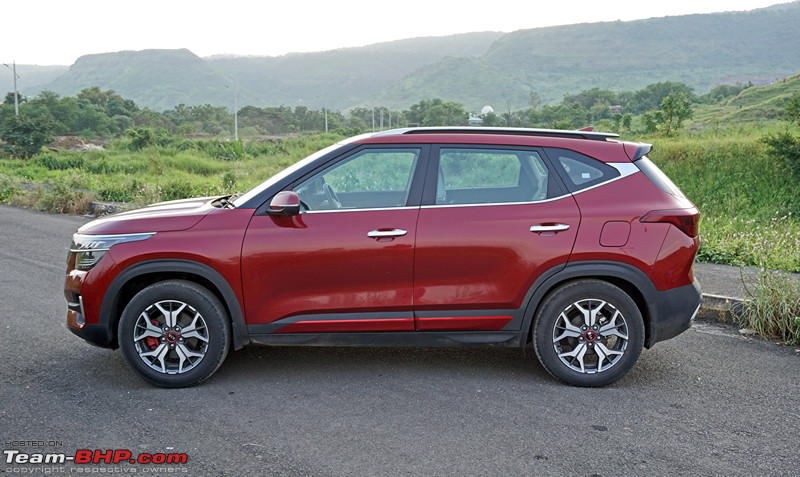 To say that Kia has entered India with a bang would be an understatement! It got everything spot on, including the product, price, variant spread & marketing. And with just this single product, Kia was the no.5 manufacturer in October (related thread). MG Motor - another 2019 entrant - has also enjoyed success, but Kia is on an altogether different level! Kia has received more than 50,000 bookings for the Seltos & the car has a waiting period of up to 5 months in some cities. As you know, Kia is part of the Hyundai group and its Indian division is hungry, aggressive & well-funded. When any new company decides to enter a market as fiercely competitive as India, choosing the right product is crucial for its success. Additionally, the product has to be of top-notch quality. Get a half-baked product and you will be blown away to smithereens. Just look at what happened to the Tata Harrier. Kia certainly did its research before setting foot on Indian soil. And the company isn't done yet. Round 2 of the attack is going to come in 2020 with the Carnival MPV & a Compact SUV based on the Venue. The Seltos is a very handsome crossover based on a new platform which will underpin the next-gen Hyundai Creta too. Karan561 points out this is a modified version of the K2 platform which is seen in the Verna & Elantra. It uses a 73% high-strength steel structure. The doors, tailgate and bonnet (especially) have a good deal of weight to them. There's very little flex if you press the metal with your thumb. The car feels solid & well-built throughout. Paint quality is as good as we’ve seen in the segment and the panel gaps are tight + even as well. You'll see on the Seltos the same kind of quality consistency as Hyundais. 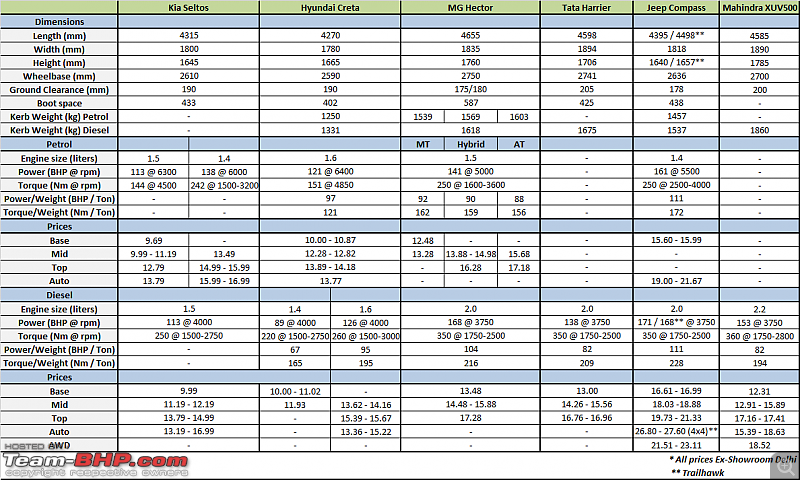 To power the Seltos, Kia have used two petrols = a 1.5L, 4-cylinder (lower variants) and a 1.4-litre turbocharged unit (higher variants). A 1.5L, 4-cylinder turbocharged diesel is also available for the torque / economy lovers. All engines comply with BS6 emission norms and come mated to a 6-speed manual gearbox. Automatic transmission options include an IVT (CVT) for the 1.5L petrol, a 7-speed DCT (dual-clutch) for the 1.4L turbo petrol and a 6-speed torque converter for the 1.5L diesel. The Seltos is available in GT Line and Tech Line trim levels, and a total of 17 variants. Take a look at the official website; it is complex & confusing, but you can say that Kia has mostly everyone covered. If you are out shopping, be prepared to spend as much time on the variant selection as the car selection! Coming to safety, the Seltos is equipped with dual front airbags, ABS + EBD, rear parking sensors & seatbelt reminder (for driver + front passenger) as standard. Barring the 1.5L HTE Petrol, the car gets disc brakes all-around and leaving the HTE, HTK & HTK+, all variants get ISOFIX child seat anchors. The top variant further gets 6 airbags, TPMS, ESP, hill-assist and a 360 degree camera with front parking sensors. Additionally, you get an IRVM with RSA and SOS buttons. As of date, the Seltos has not been crash tested by independent entities like the NCAP - we look forward to the results. Kia is offering a standard warranty of 3 years / unlimited km, which can be extended to 5 years / unlimited km. We strongly recommend choosing an extension as always. You can expect Hyundai-like reliability with later cars, but it does appear that Kia is still to perfect its production process. Both our test cars had a problem with their air-conditioning. Kia is also offering 3 years Road Side Assistance, a scratch-care program for one-time free repair of your first scratch (more info) and 3 years UVO telematics subscription. Kia, though a subsidiary of Hyundai, has come into India as a separate entity. So it will not use Hyundai's established sales and service network. Instead, the company has set up its own 3S (Sales, Service and Spares) network with 265 touch points across 160 cities in the country. After the success of the Seltos, there is a long line of businessmen begging for more dealerships. It has also set up its own elaborate manufacturing facility in Anantapur, Andhra Pradesh with an installed annual capacity of 3,00,000 units. Smart & mature face is aggressive with a wide, glossy black tiger nose grille and a deep air dam. Chrome has been used around the grille and headlamps, but it doesn’t look overdone: 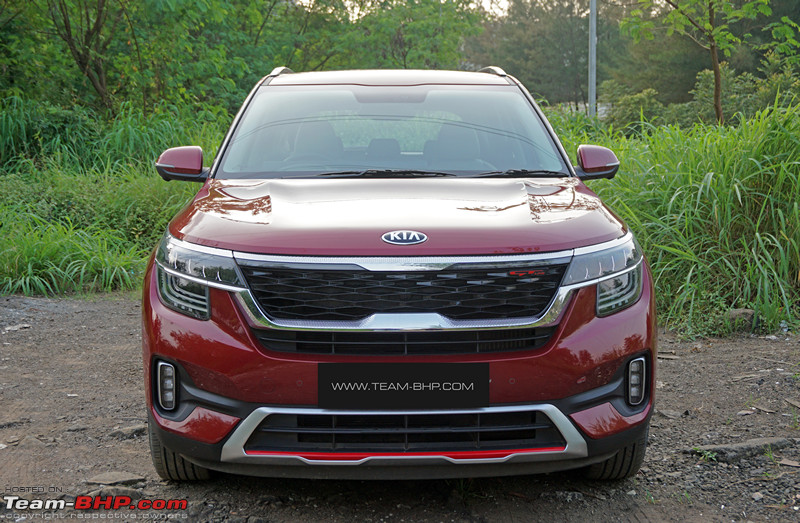 Rear end features many creases on the tailgate and bumper. Like the front, a silver faux skid plate has been provided. Thick chrome strip runs between the tail-lamp clusters and merges with them. This is the only part that looks excessive to me. Fake dual exhaust look is very chic: 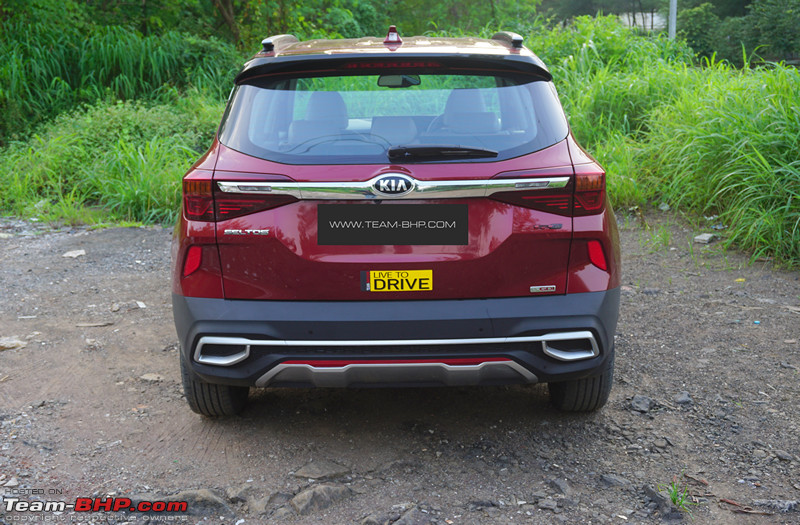 Car has a very European-design vibe to it. Black plastic cladding on the sides and around the wheel arches (along with roof rails) gives it a rugged look: 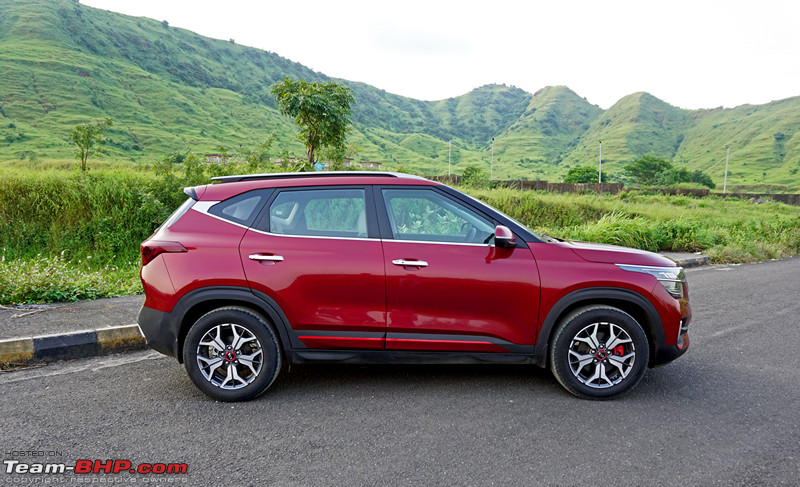 Measuring 4,315 mm in length and 1,800 mm in width, the Seltos is longer and wider than its main rival – the Hyundai Creta. Its wheelbase of 2,610 mm is also longer. However, with a height of 1,645 mm, it is not as tall as the Hyundai (1,665 mm): 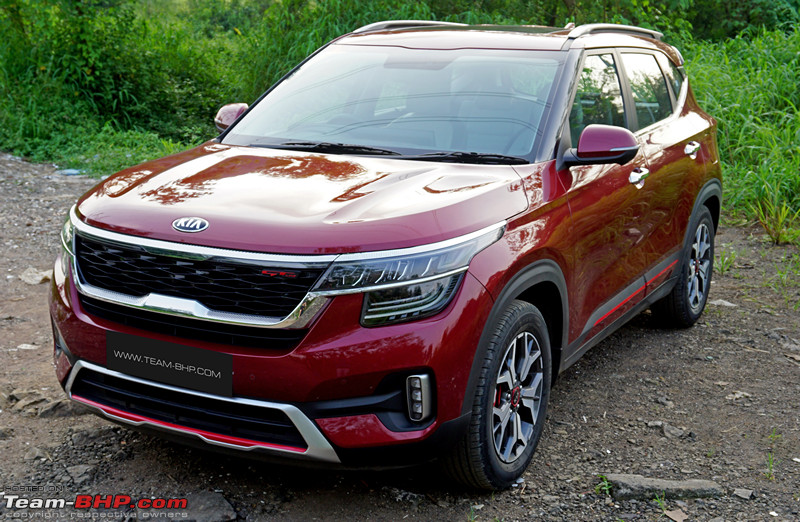 Strong character lines and flared wheel arches gel well with the front + rear ends of the car. The Seltos looks amazing! 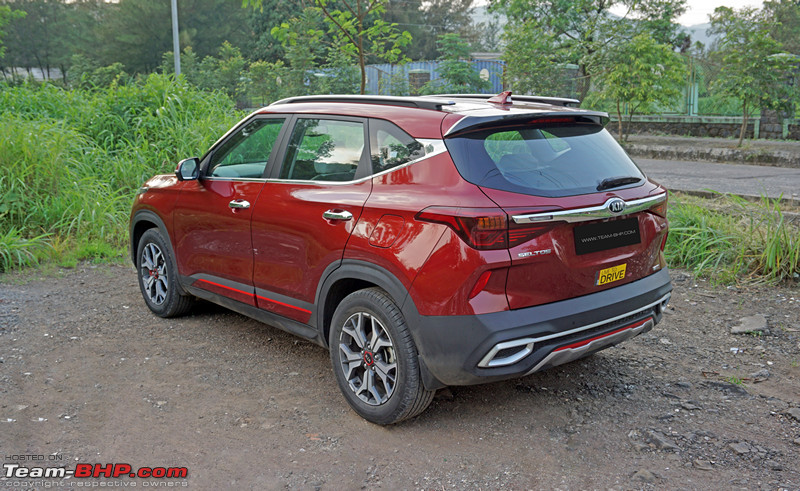 Snazzy “crown jewel” LED headlamp clusters have chrome inserts; they consist of LED projectors, LED indicators and LED DRL strips on the top. These are standard on all the GT Line variants. In the Tech Line, they come only in the HTX and HTX+ variants. Lower variants get halogen projector headlamps: 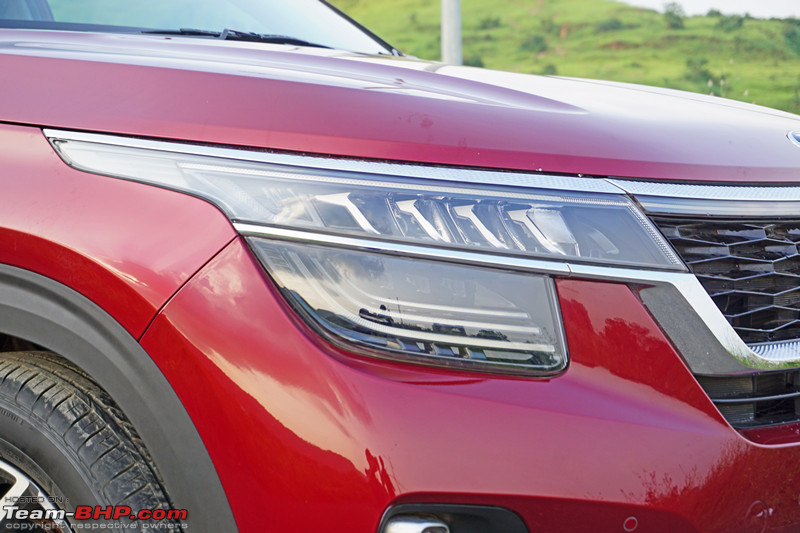 LED pilot lamp strip extends almost till the center of the grille: 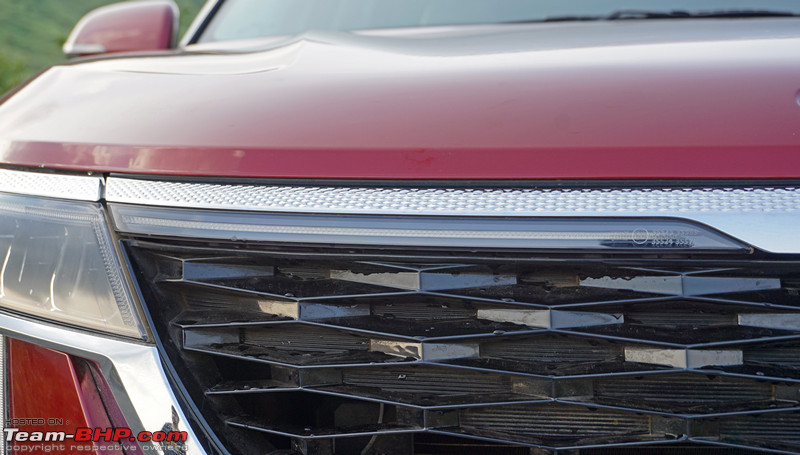 "Heartbeat" LED DRLs are located in the outer corners of the headlamp clusters: 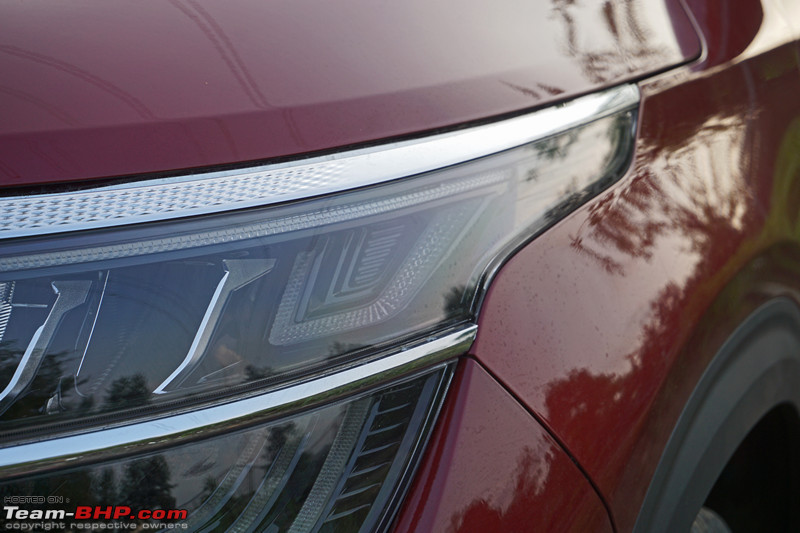 A look at the headlamp cluster with all the lights in action. They look rather attractive at night & lend presence to the car: 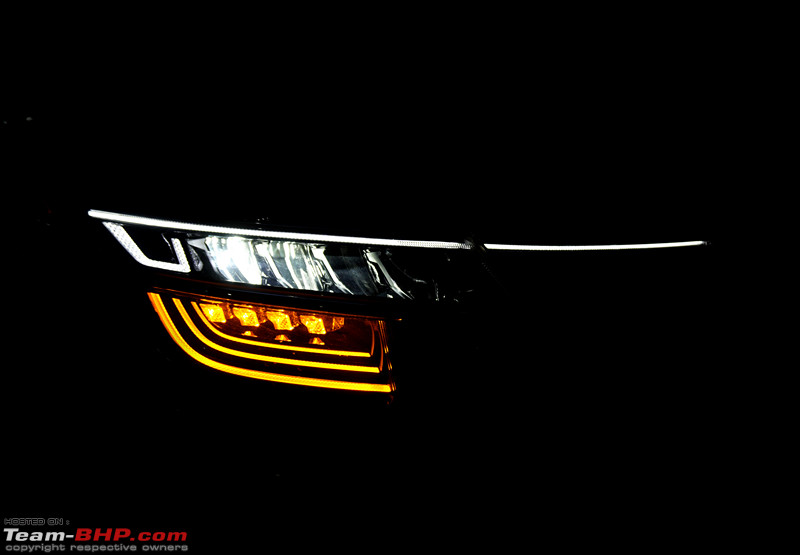 DRLs are bright and prominent, even during the day. Trivia: When you use the turn indicator, that side's DRL switches off for better visibility to cars coming from the opposite side: 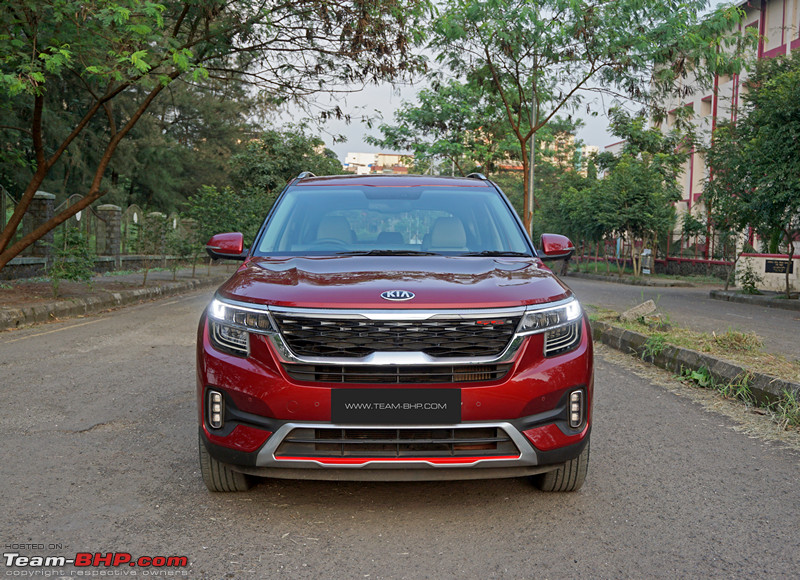 Split grille with a glossy black “tiger nose” section on the top. The upper grille section has a funky design pattern with a thick chrome border:  Chrome border of the grille gets a funky design pattern: 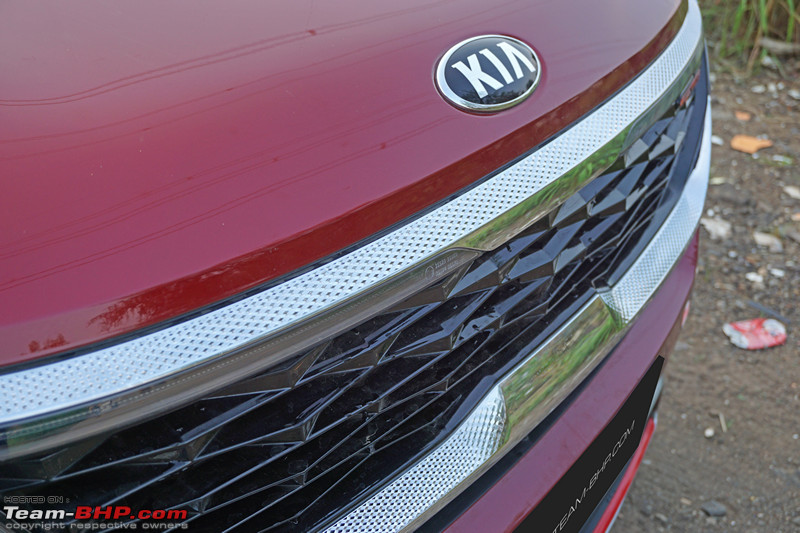 GT Line variants get a red badge on the right: 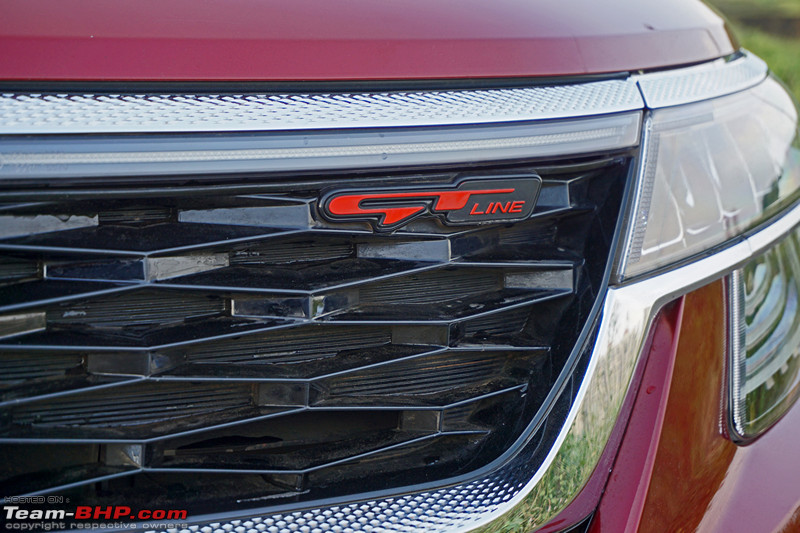 GTX+ (top variant) gets a front camera, which is part of the 360-degree camera feature. It sits in the center of the grille and is superbly integrated: 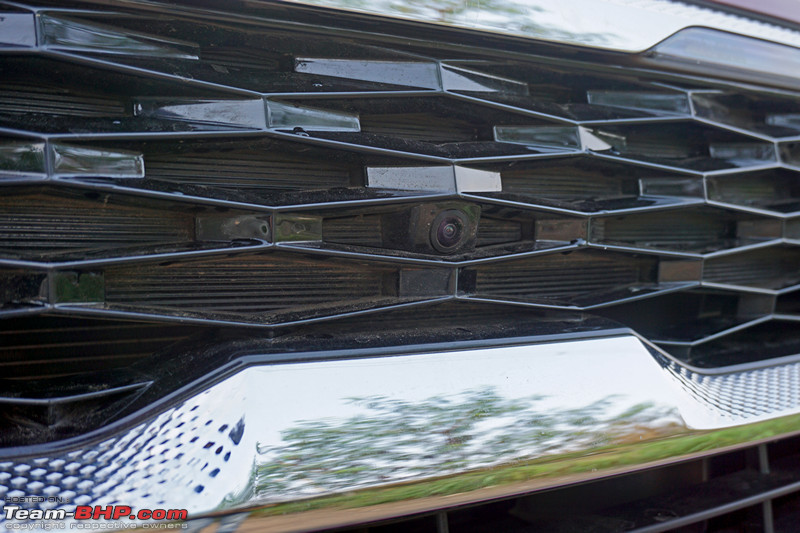 Front bumper features black inserts and a large air dam with a thick silver border, which forms a faux skid plate at the bottom. Don't miss the vertically-stacked LED foglamps with silver housings: 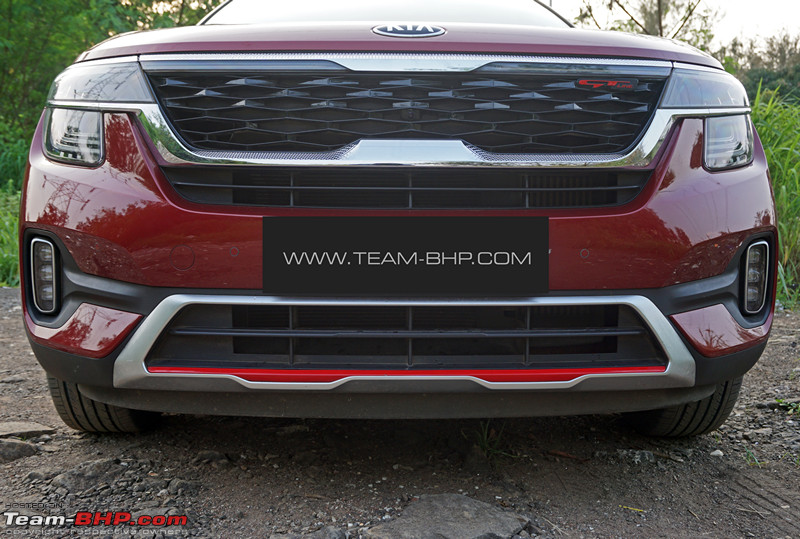 A closer look at the "ice cube" LED foglamps. They are bright and provide good illumination. Top variants of GT Line and Tech Line (GTX+ & HTX+) come with 4 parking sensors at the front: 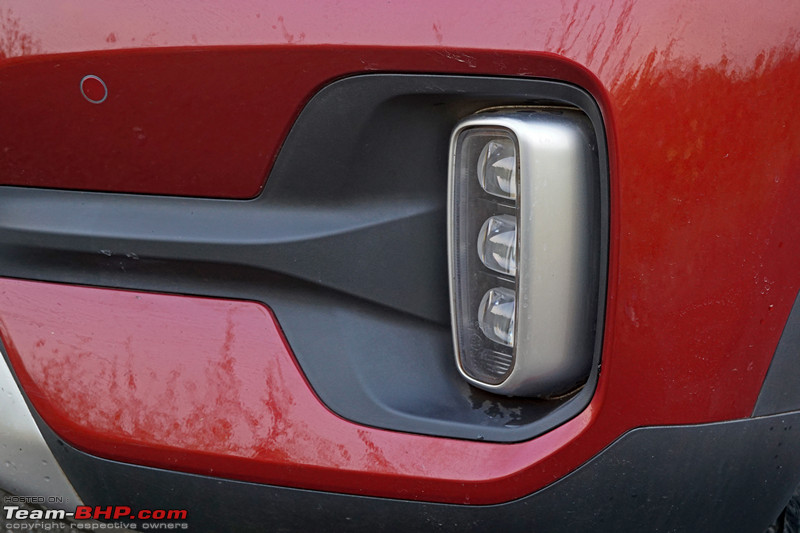 GT Line gets a red strip at the base of the air dam. We found this cheesy & it certainly doesn't go well with all body colours (including this test car's maroon). Ornamental skid plate does not stretch far back at all and is of no real use: 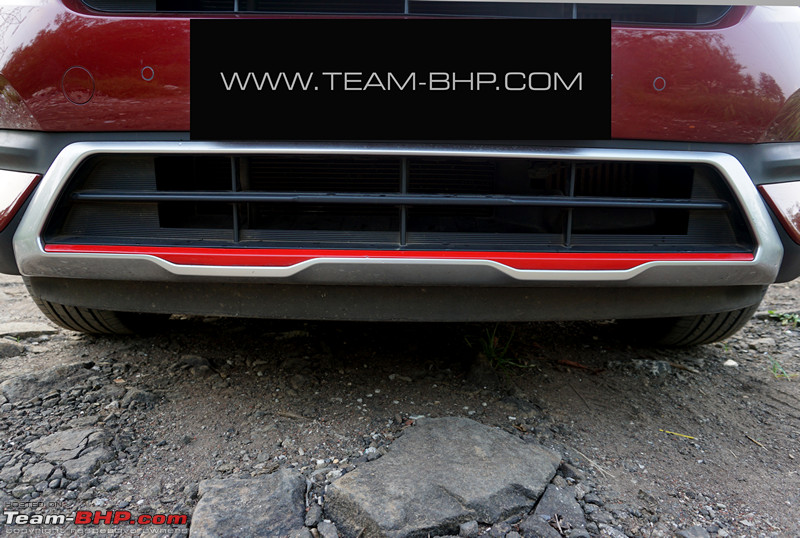 'Tech Line' does not get a silver border around the air dam or that cheesy red highlight of the GT Line: 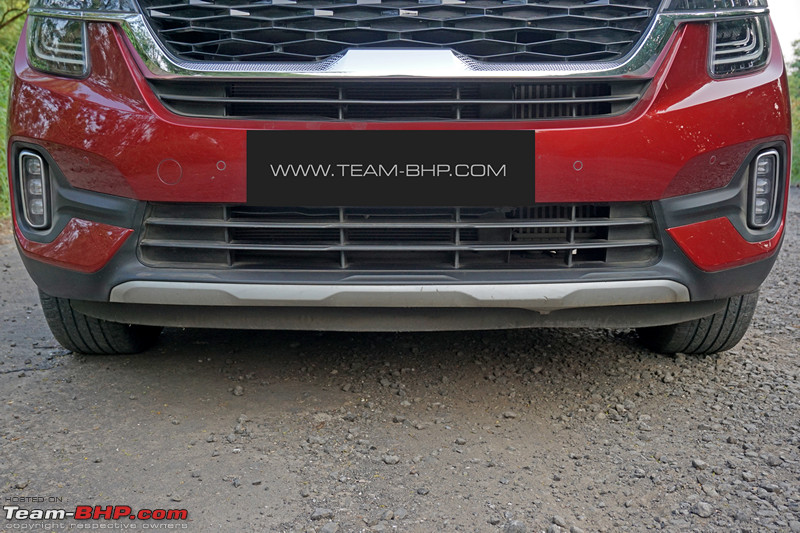 There is a good deal of underbody protection. These are important for India's unpredictable road conditions: 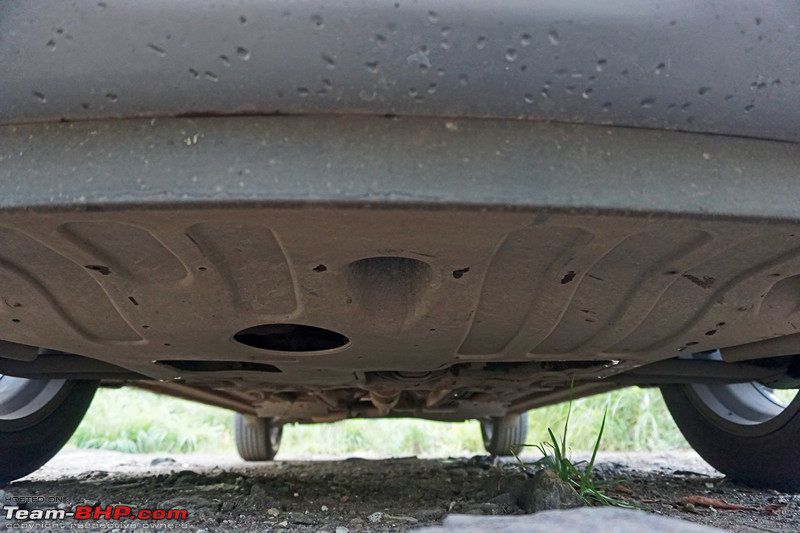 Long bonnet features a wide and largely flat central dome, while the prominent creases on the side give it some muscle. Prominent Kia badge sits right at the front. Kia's badge has the short company name, unlike say the "S" Suzuki badge or Hyundai's slanted "H": 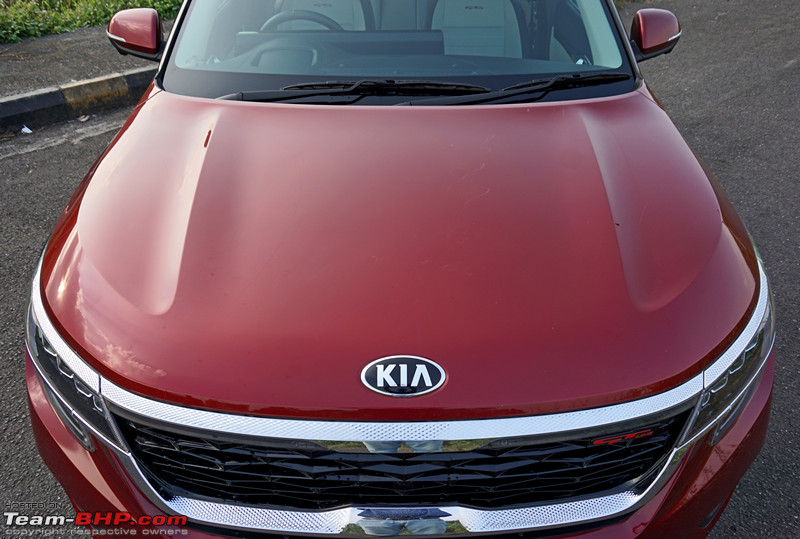 The Seltos is equipped with automatic rain-sensing wipers. The sensor is located in the center of the windshield: 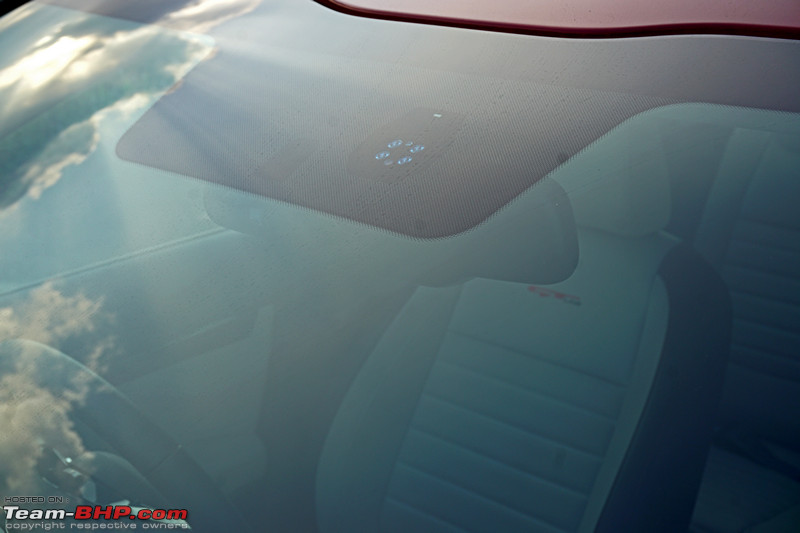 Wiper spindles are concealed under the bonnet... 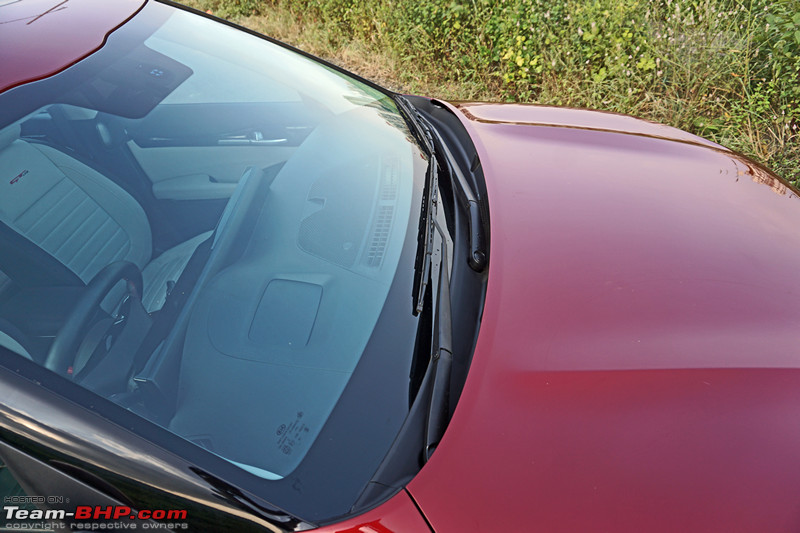 ...as are the windshield washers: 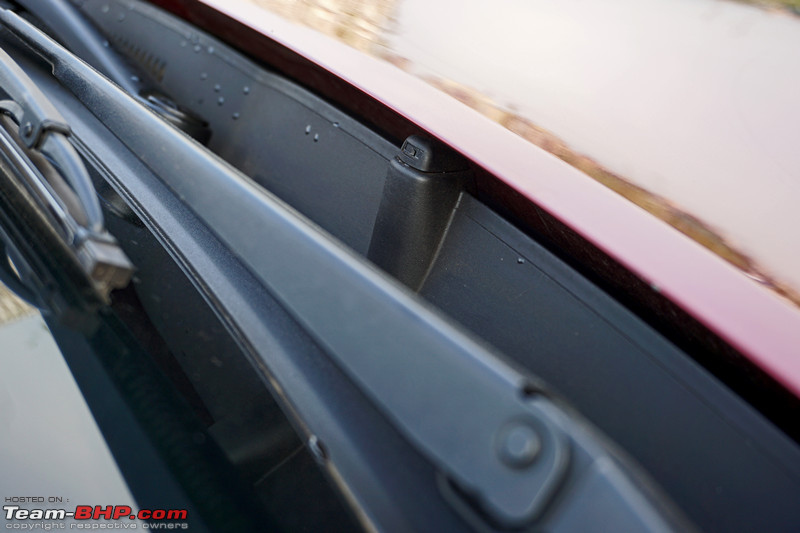 Both windshield washers squirt out effective sprays (rather than jets) of water: 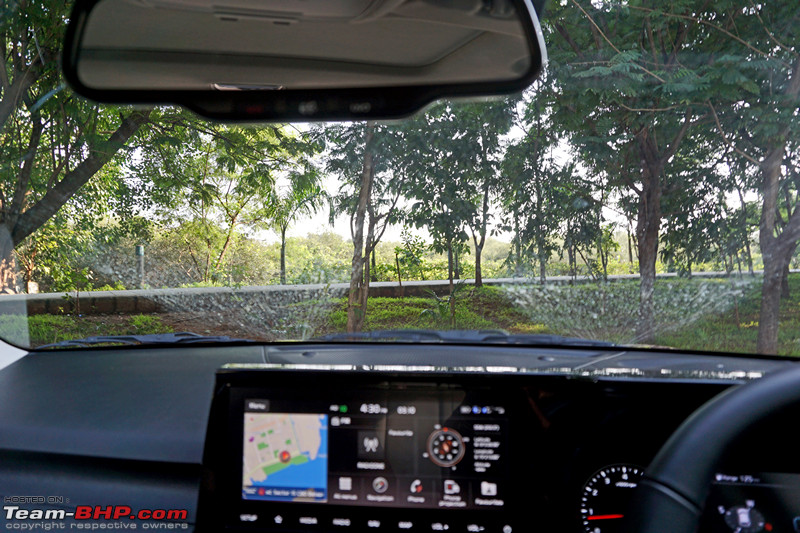 Dual-tone body colour + black ORVMs with integrated LED turn-indicators. They are electrically adjustable + foldable, and also have an auto-folding function on lock / unlock: 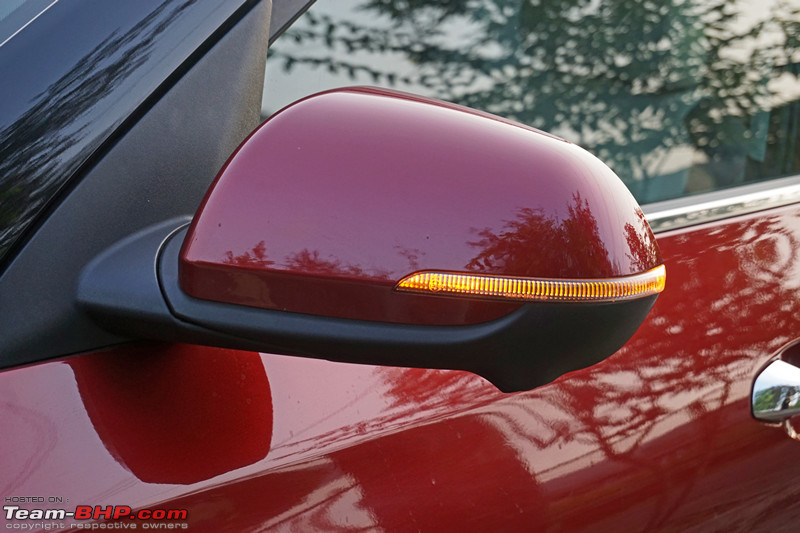 As mentioned earlier, GTX+ variant gets a 360-degree camera. The side cameras are placed under the ORVMs: 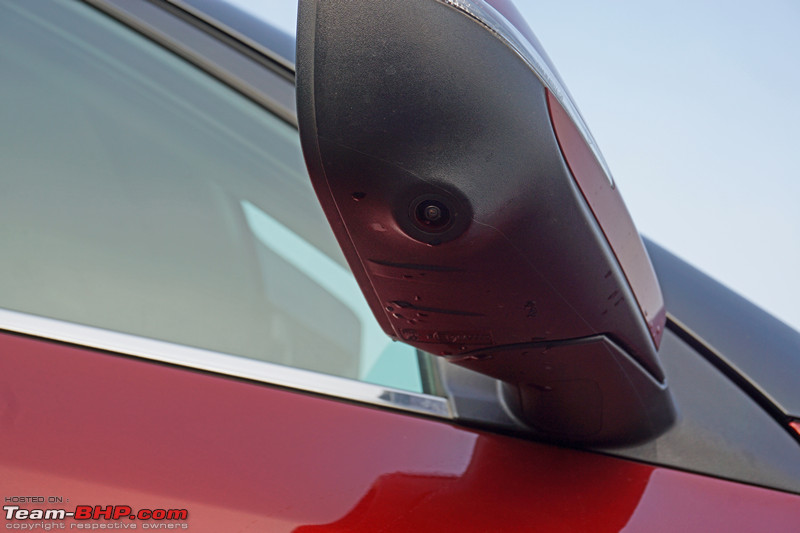 GT Line and higher variants of Tech Line get a chrome door handle with a request sensor on the driver's door. No request sensor or keyhole on the front passenger's door:  Roof slopes down slightly towards the rear, while the window line rises. A and B-pillars are blacked out. C-pillar is thick, but quarter window helps in making the cabin appear airy. Chrome strip runs below the window all the way to the C-pillar: 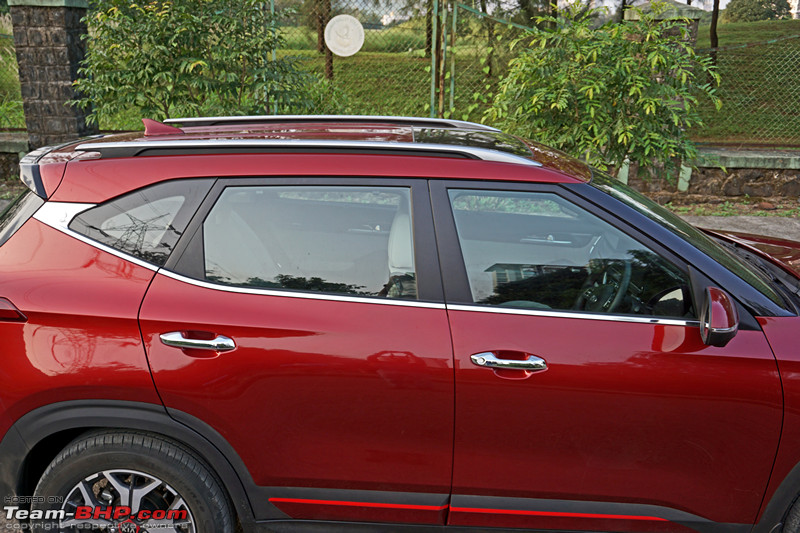 Thick chrome insert on the C-pillar where the strip ends. Notice how the top edge of the chrome insert merges with the rear spoiler: 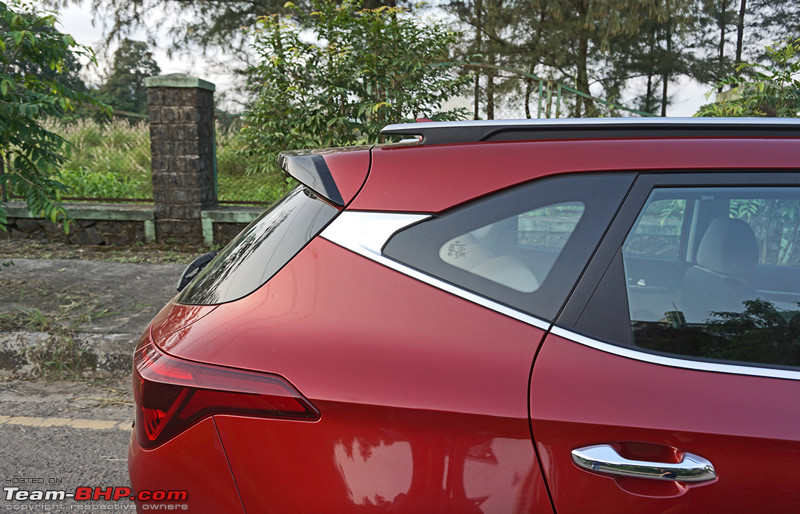 There's a prominent haunch that originates on the rear door, runs across the rear panel and merges with the tail-lamp: 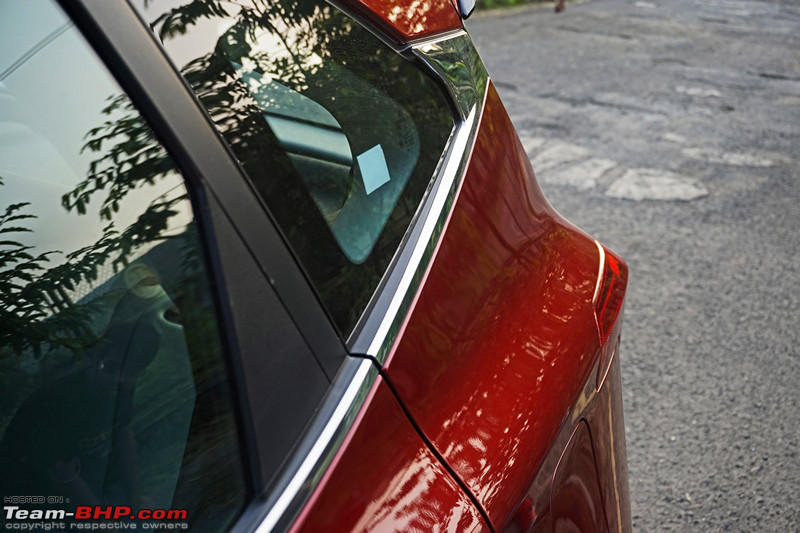 Very sweetly sculpted side profile - we like the subtle muscle effects: 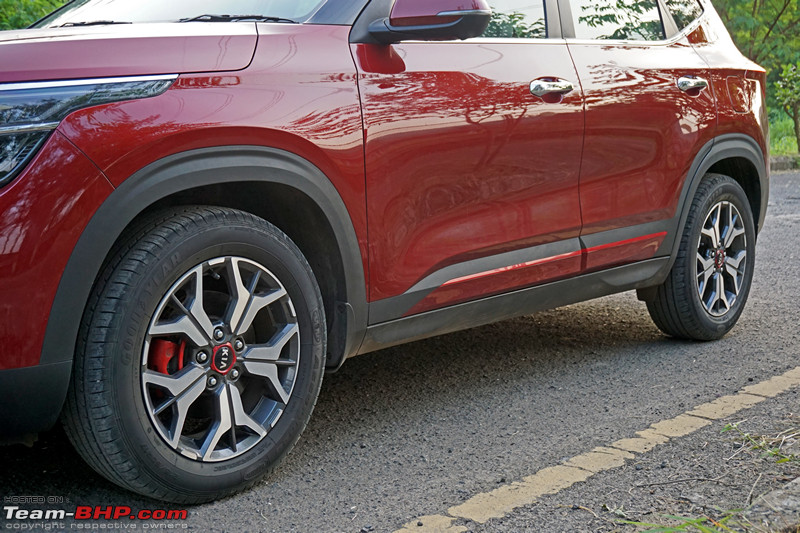 GT Line gets 17" crystal-cut funky alloy wheels with red center caps, shod with 215/60 section tyres. Except for the red center cap, I like the design: 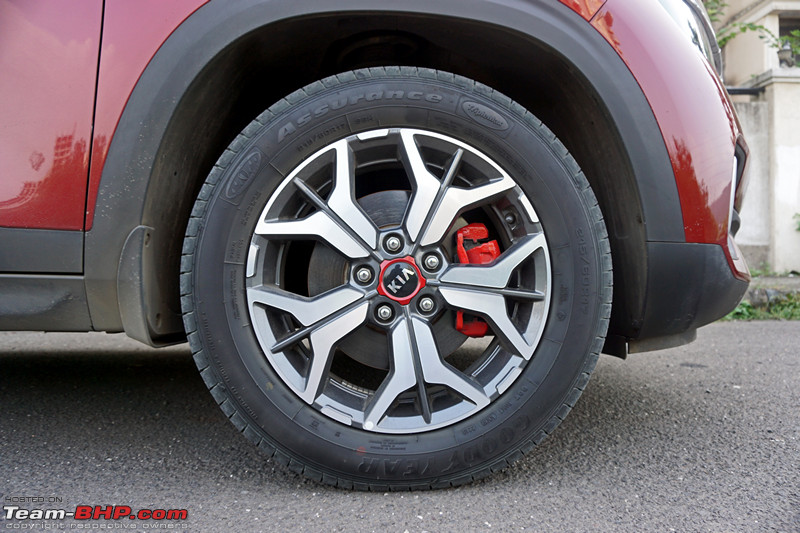 GT Line also gets red brake calipers at the front. Perhaps the only red highlight we appreciate: 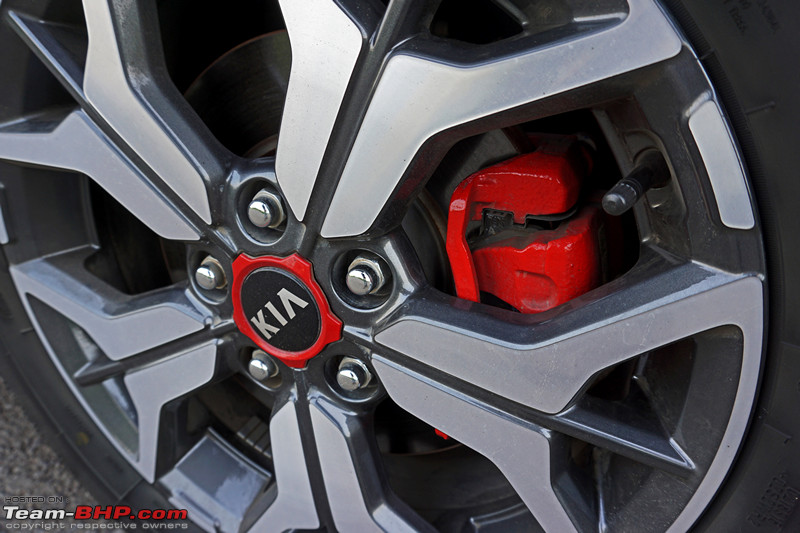 Tech Line gets these 17" single tone alloy wheels in the HTX and HTX+ variants. They look more sedate than those of the GT Line, but with all the red bits missing, one might find them easier on the eyes. Lower variants get 16" steel wheels or 16" alloy wheels (HTK+): 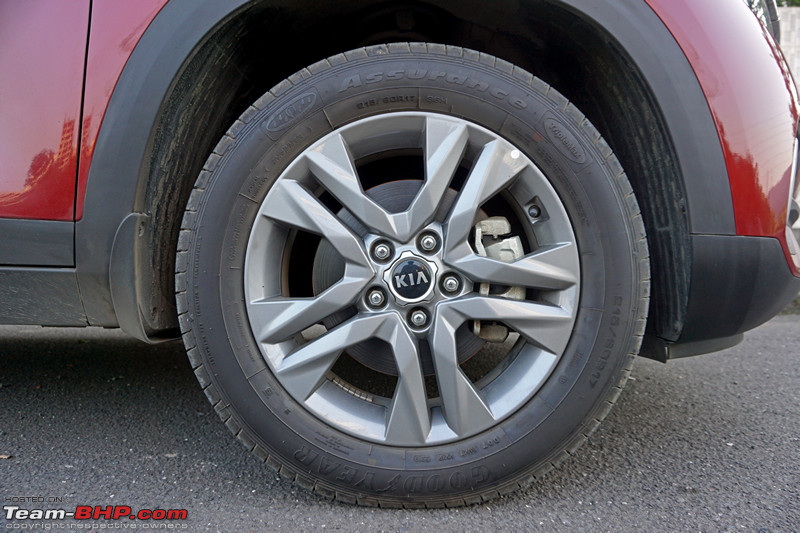 GT Line gets a red line on the black plastic cladding of the door. We'd remove this if we bought a GT Line: 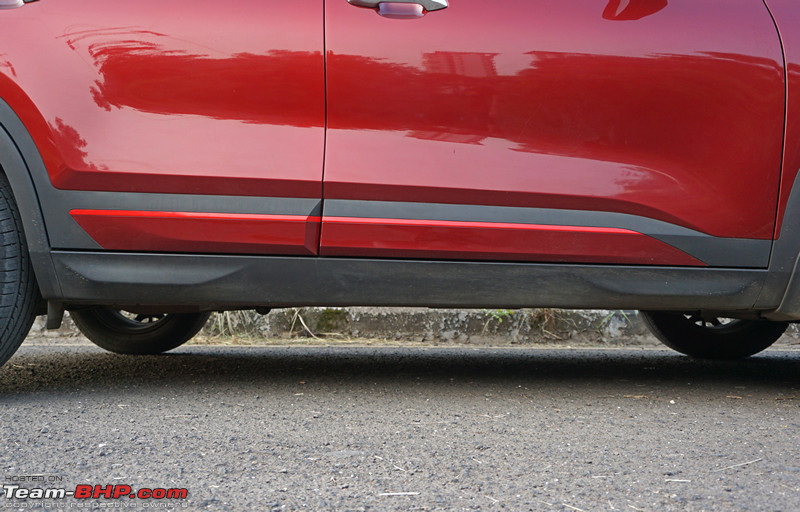 Tech Line gets a silver highlight instead (which we MUCH prefer!): 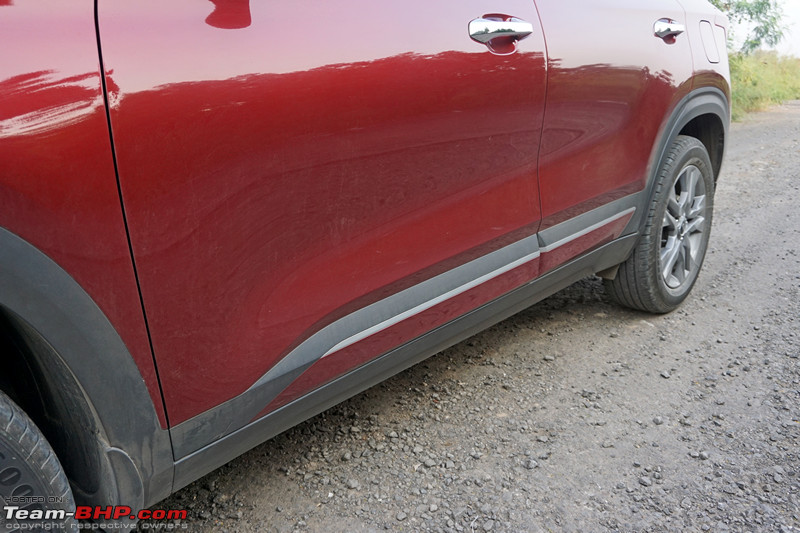 Small mud-flaps located ahead of the rear tyres: 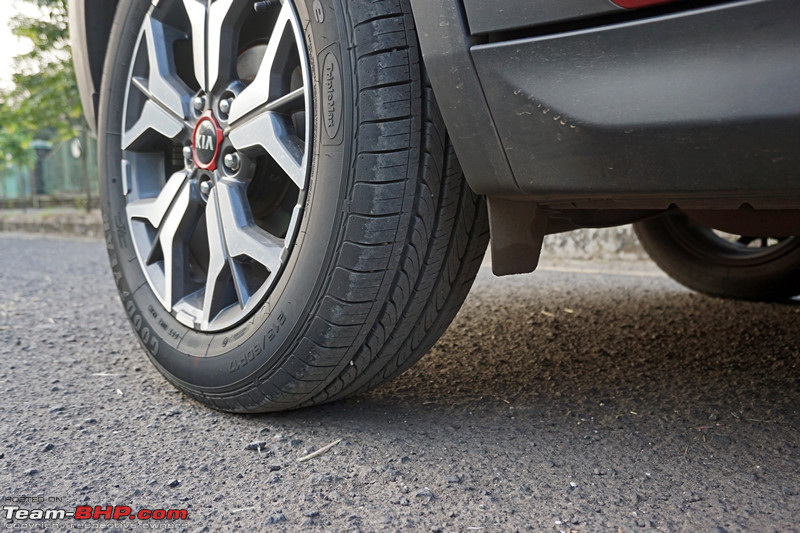 Disc brakes are provided on the rear wheels as well: 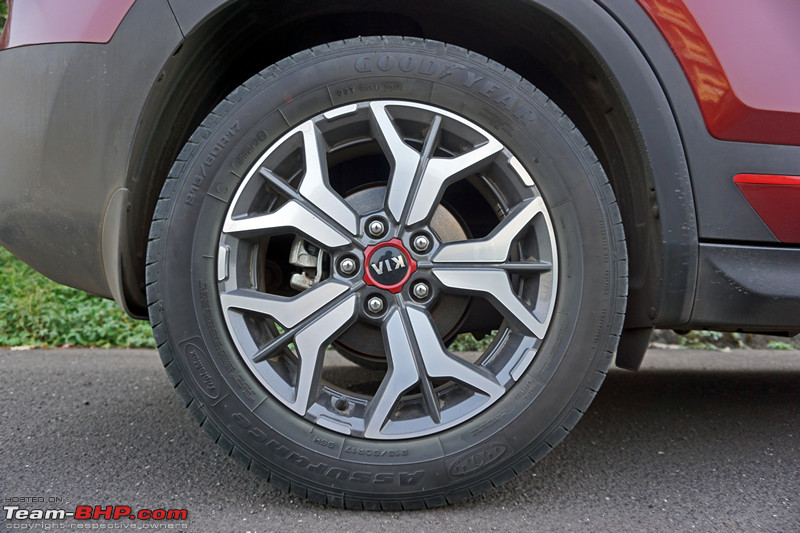 GTX+ and HTX+ variants get a very-welcome sunroof. It's a bit smaller than we'd have liked though: 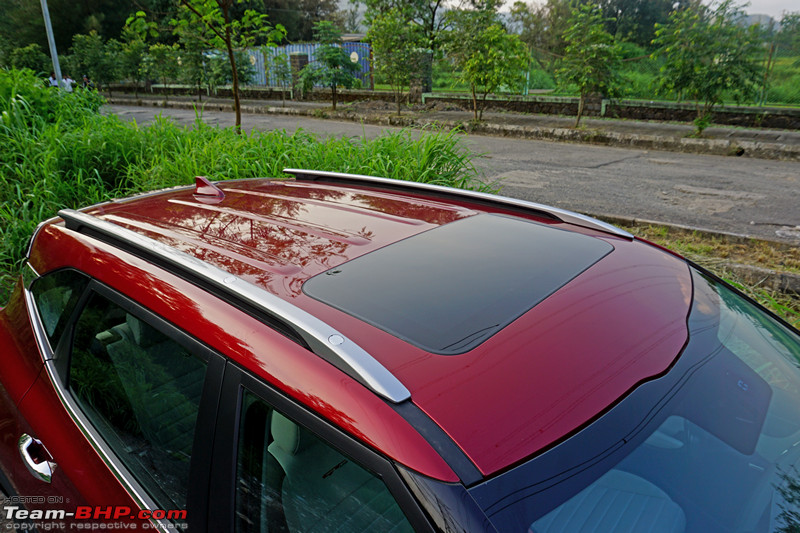 Barring the base HTE trim, all variants get silver + black roof rails. Roof is ribbed for better structural rigidity. Sharkfin antenna sits at the rear: 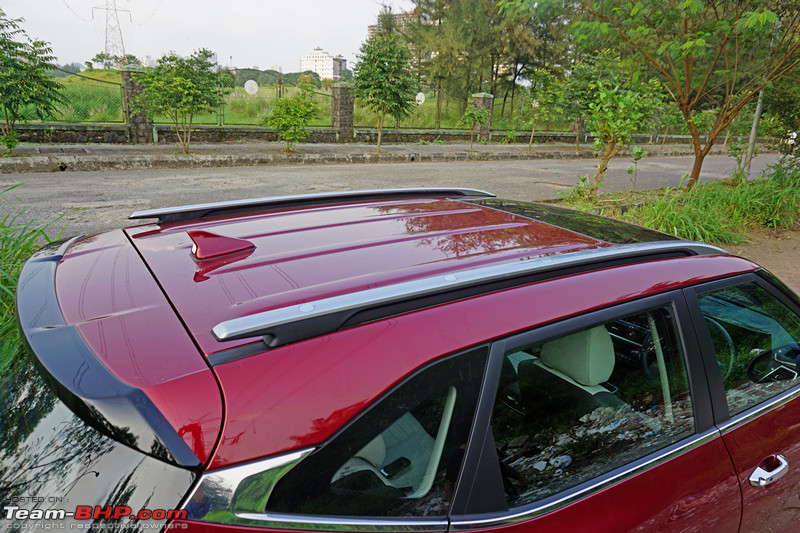 Tailgate gets a subtle and neatly integrated spoiler with a glossy black lip: 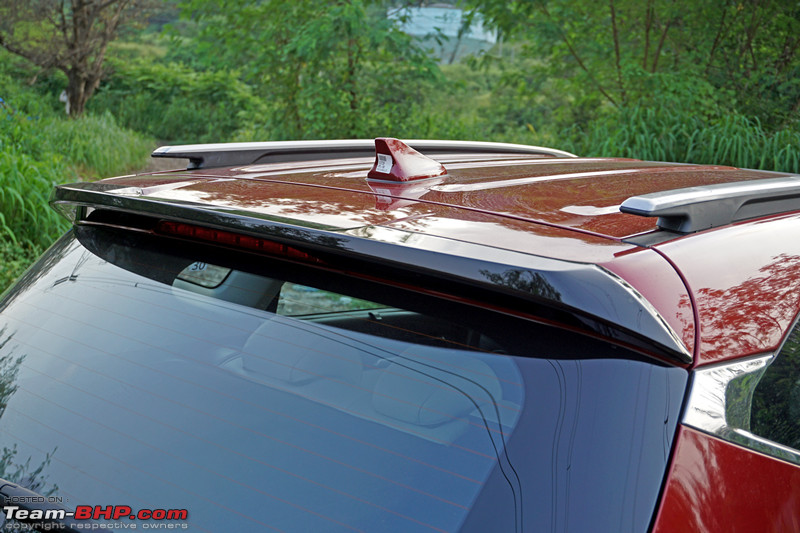 LED HMSL is housed in the spoiler: 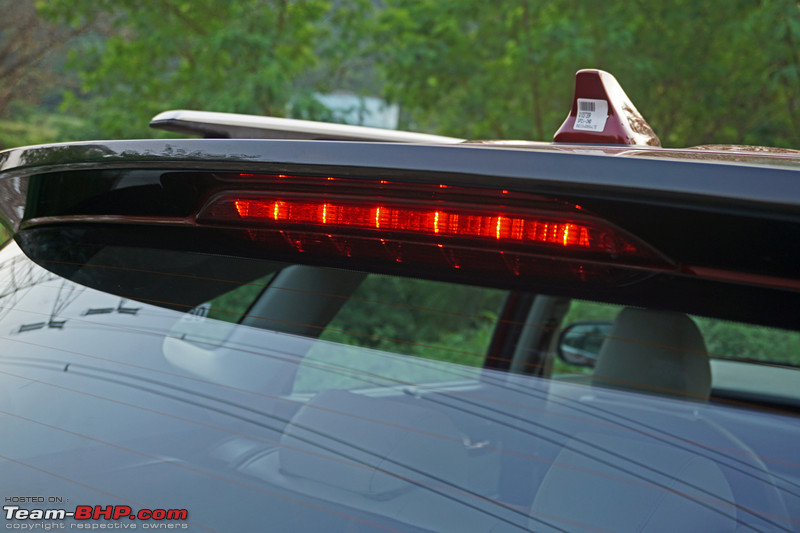 Windshield washer is well-integrated in the HMSL (on the extreme right): 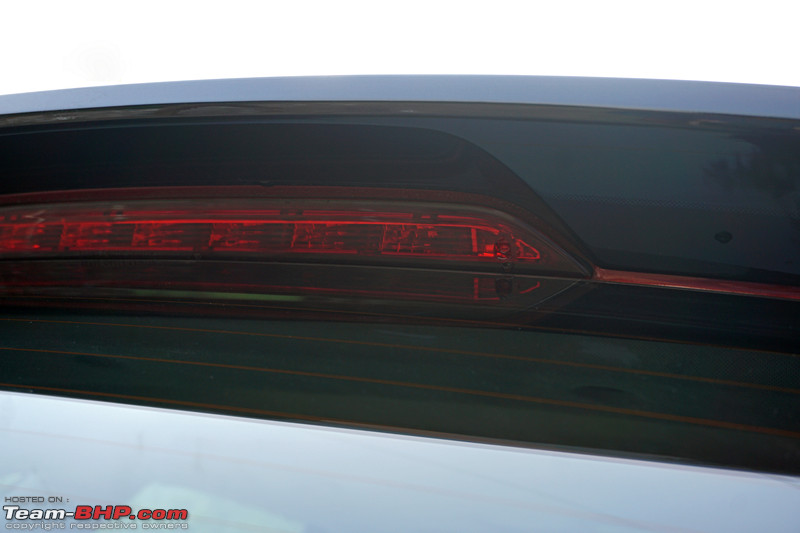 LED tail-lamps are available on the HTX, HTX+ and GT Line variants. Notice the heartbeat shape of the LEDs in the corners - pretty much like the shape of the DRLs. We love Kia's designs! Take a look at the 'Seltos' badge, you can tell they've put a lot of thought into its font & styling: 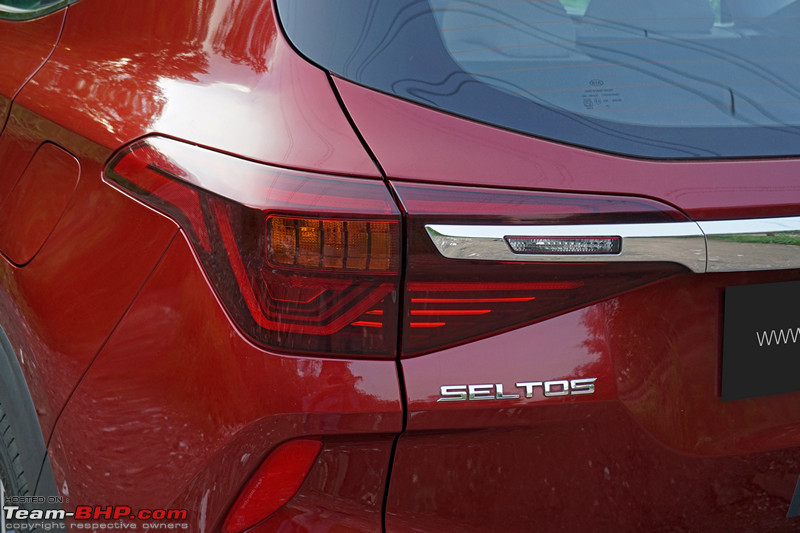 With all the lights in action. Nope, there are no rear foglamps: 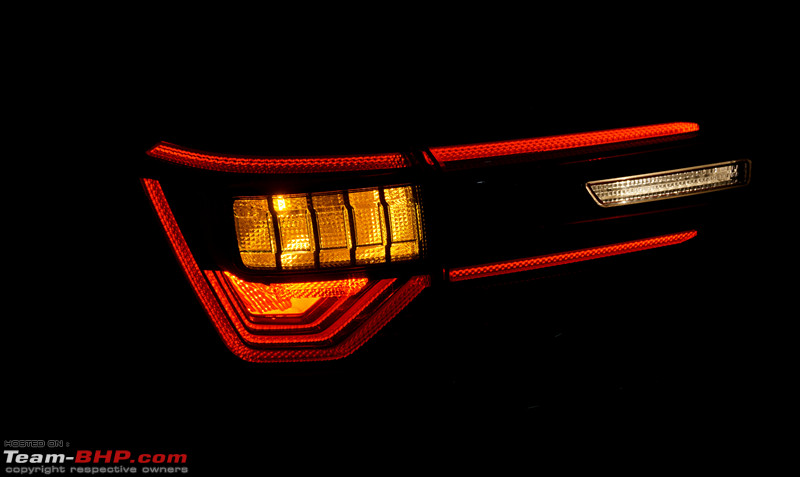 Tailgate has many creases. Rear windshield is proportionately sized. Thick chrome strip houses a large KIA badge: 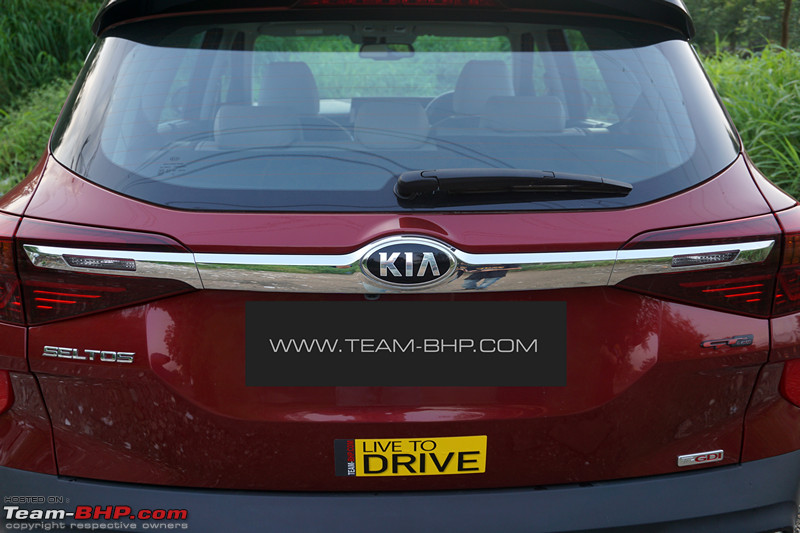 Reversing camera is tucked away under the chrome garnish, with the electromagnetic boot release next to it:  Number plate illuminators are halogen yellow bulbs. Surprising, since all other lights are white LEDs! A glaring lack of attention-to-detail: 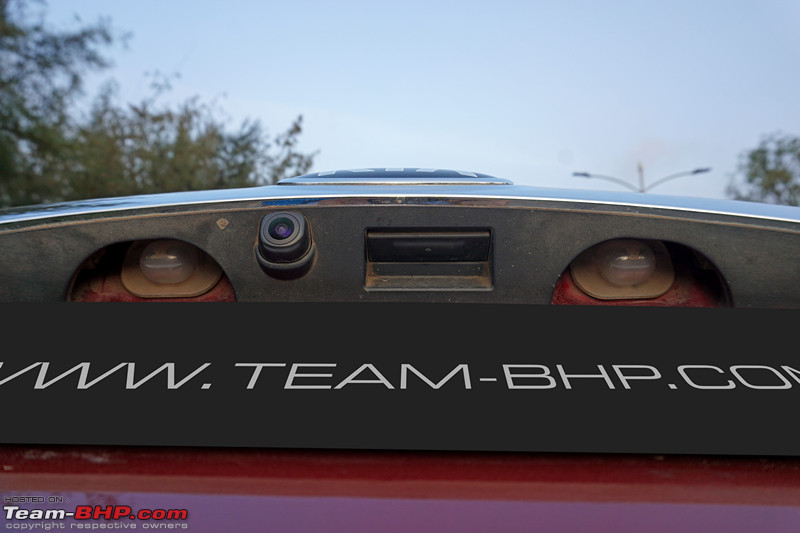 GT Line and engine badging on the right: 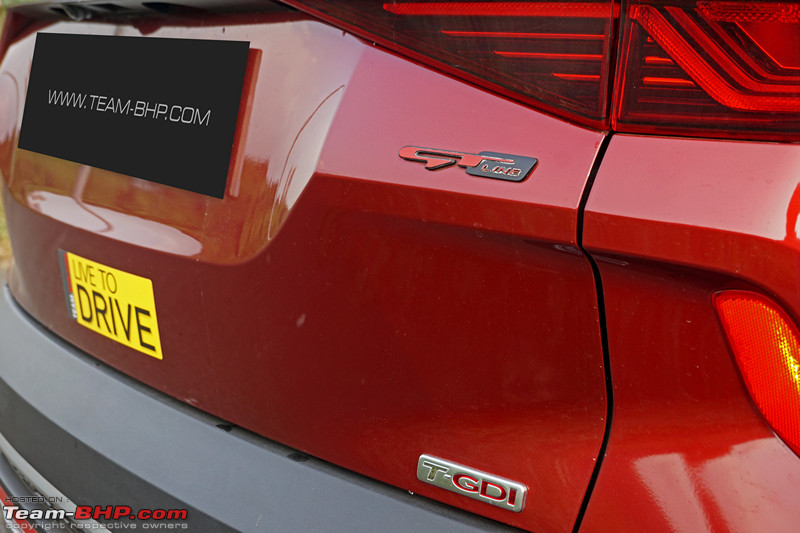 Smart reflectors are placed in recesses at the extreme ends of the bumper (on the body coloured portion). We appreciate how this usually mundane item has been turned into a design touch by Kia:  Rear bumper has a huge black bottom area to break the body-colour monotony. Prominent skid plate too, and silver inserts above. We love the fake dual exhaust-like look (actual tail-pipe peeps out from below). 4 parking sensors have been provided. Like the front bumper, the rear skid plate has a red highlight above it (we don't like it at all): 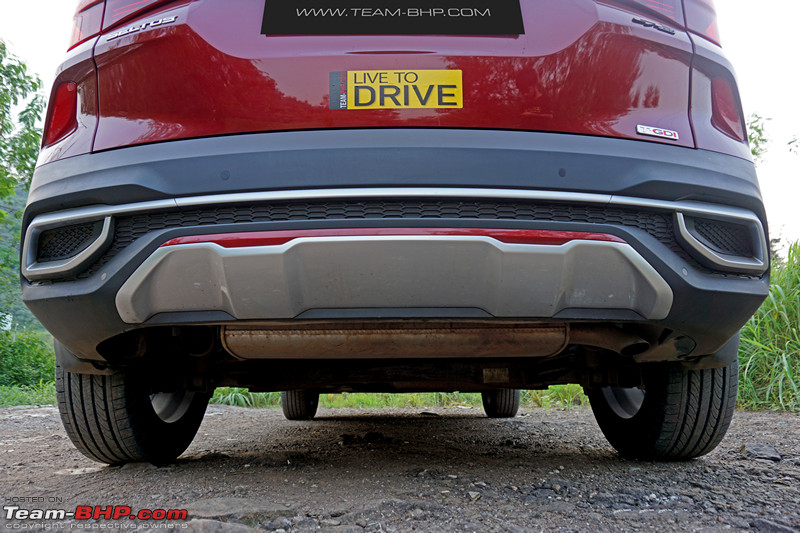 Towing point is located on the right. Cap has an arrow indicating where you should press to remove it: 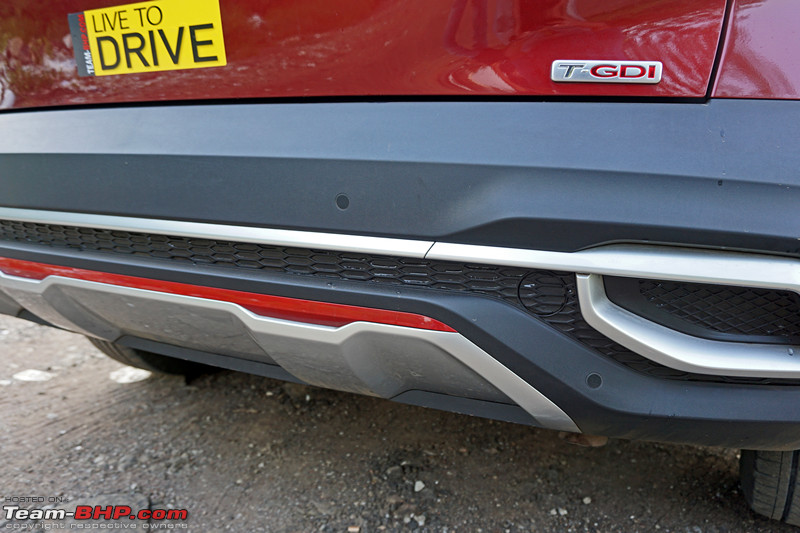 What look like openings for the exhaust pipes are actually sealed: 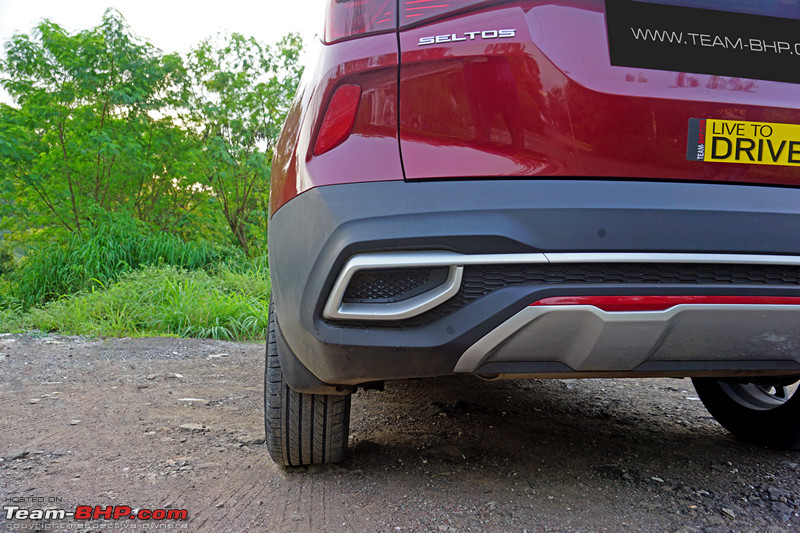 A glance at the rear of the diesel HTX+ "Tech Line" which does not get the red highlight (thankfully) above the skid plate. There is no badge denoting the variant or engine. We prefer this clean look: 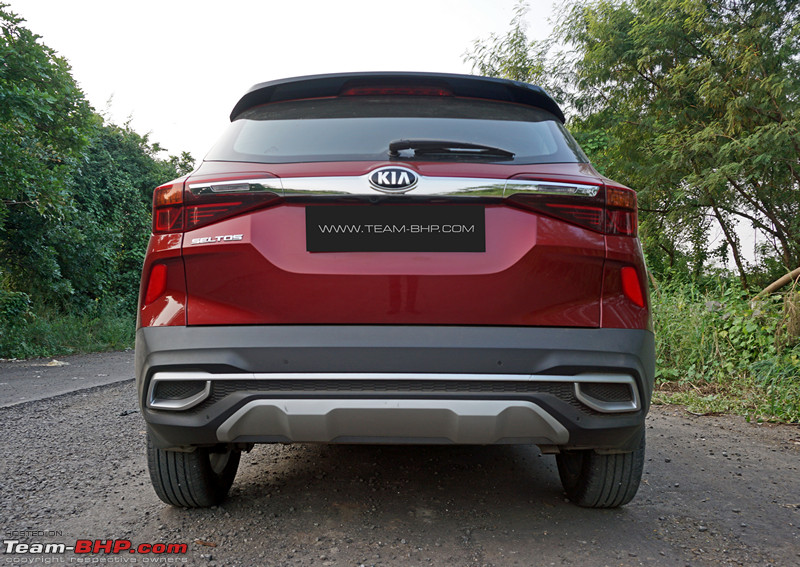 Next to its fiercest competitor. The Seltos looks far more aggressive & modern. However, the next-gen Creta is coming in early 2020. Hyundai saved Kia by buying it many years ago; the subsidiary is now strong competition in many markets: 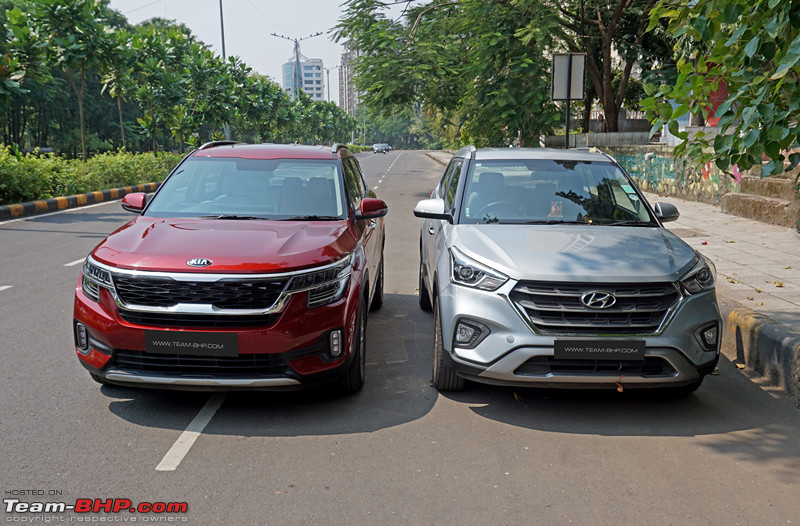 Last edited by Aditya : 29th December 2019 at 08:30. |
| |  (74)
Thanks (74)
Thanks
|
| The following 74 BHPians Thank Aditya for this useful post: | 2himanshu, Abhinav V, ach1lles, Added_flavor, AdityaDeane, aghate, akshay81, amit1agrawal, arbaz906, ashking101, Bee, Bibendum90949, BlackPearl, bullock-Car, BZ25, carenthusiast, carrazy, Chrome6Boy, dailydriver, dksv, GTO, hemanth.anand, hmansari, InControl, Ithaca, jailbird_fynix, JoseVijay, kutts, laferrari, Leoshashi, libranof1987, low_range, MDED, MSAneesh, N33raj, Nazaar25, Night_Fury, NomadicLife, noopster, NPV, Nrulz, PapaKiloSierra9, phoenixash, Ponbaarathi, Prakritij, Puffdamgcdragon, RaghuVis, RavenAvi, Reinhard, REN, Researcher, Rigid Rotor, S.MJet, sanj47900, searacer932, shibujp, shipnil, Simat, skchettry, smuniswami, sparky@home, the mole, theexperthand, THE_DRIFTER, TorqueTwist, uday.ere, vaasu, Varun_HexaGuy, vb-saan, Vik0728, vredesbyrd, VTec_KickedInYo, Vysakh, wheelguy |
| | #4 |
| Team-BHP Support  | Interior - Front 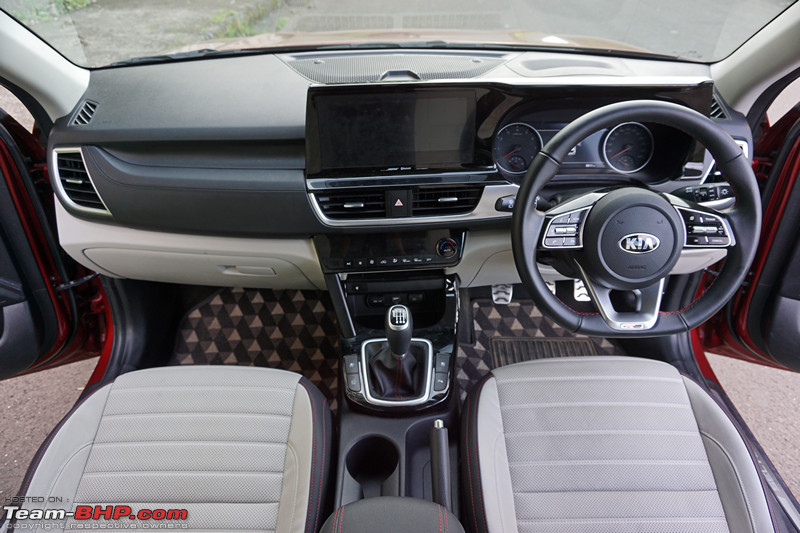 The front doors of the Seltos open and shut in a triple-stage action. They have decent feel and aren't light as in some other Asian cars. The doors open wide enough & the roof is high. So, occupants will not have any problem while getting in or out. On the inside, the Seltos has very good legroom and headroom. Even taller occupants will find it comfortable. The front windshield is large. Though the roofline slopes down, the rear windows are decently sized and overall, enough light is entering the cabin. The interior appears similar in size to the Hyundai Creta's. They have a dual-tone beige & black theme. An all-black theme is also available, though not on the top (GTX+, HTX and HTX+) variants. The styling of the dashboard is contemporary. It is black on the top and beige below, with silver and piano black inserts. The instrument cluster and the infotainment head-unit are integrated into one large display that sticks out from the dashboard. It has a piano black finish. The carpets are black, while the doorpads, seats and floormats are beige + black. This is not very clever, as they are all likely to get soiled easily. However, it does make the interior look nice and airy. The roofliner is whitish-grey. The plastics on the dashboard are all hard. That said, the quality of the plastics is certainly the best in the segment. Every part is well-finished and there are no rough edges anywhere. A leatherette (artificial leather) insert is present on the passenger side of the dashboard. The seats get leatherette upholstery and there is some leather applied on the door armrests, central armrest, as well as the gear knob and steering wheel. Ergonomically, the cabin is well laid out and all controls are easy to find / reach. You'll find your perfect driving position within minutes. The feel, quality and finish of the buttons is very good and they feel like they are built to last. Kia has loaded the interior with features such as auto headlamps, auto wipers, auto-dimming IRVM, electrically adjustable and ventilated front seats, blind spot monitor, head-up display, a 10.25-inch touchscreen head-unit with telematics (UVO), 8-speaker Bose sound system, ambient lighting, electric sunroof, wireless mobile charging and an air purifier. However, some features such as illuminated power window switches and illumination / cooling for the glovebox are conspicuous by their absence. Black & beige dashboard is logically laid out. The entire cabin is practical, user-friendly and equipped with likeable features. Part quality & ergonomics are spot on too:  Dashboard is well-screwed together and nicely finished. One can't find any rough edges anywhere:  Top of the dashboard (behind the instrument cluster) houses the retractable head-up display in the GTX and GTX+ variants:  8" head-up display pops up from under the cowl. It's not the most elegant HUD solution & feels rather after-market'ish, but is still unique in this class of car. HUD worked well for our 5'10" height & we didn’t need to take our eyes off the road. Won’t suit everyone though (dependent on your seating position), despite its available adjustments:  Speed and navigation directions are displayed on the head-up display: 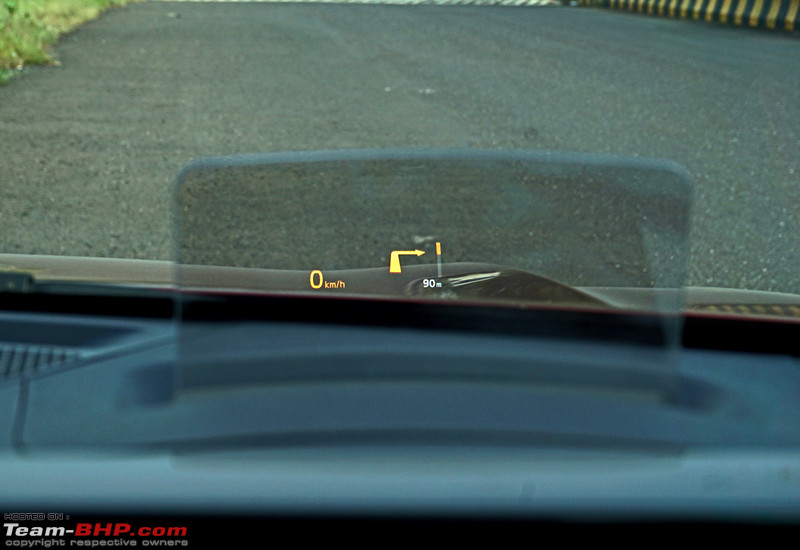 Windscreen is large and the seating position is a little high up. We could see the muscular humps of the bonnet in our 5'10" driving position. However, we are a bit apprehensive about the frontal visibility with the uniquely designed instrument cluster that sticks up from the dashboard. It's okay for average sized users, but shorter drivers could have challenges. This makes the head-up display useless for short drivers, even with the driver's seat at the highest position: 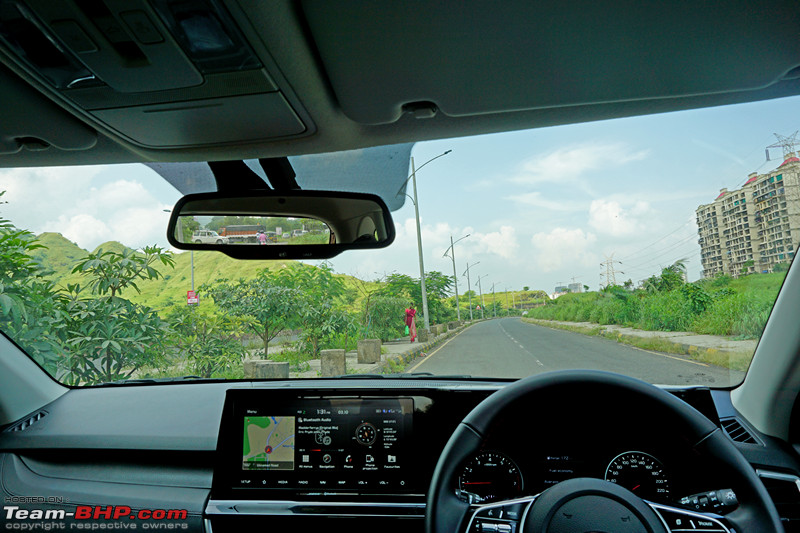 A-pillars aren't excessively thick and do not cause big blind spots. Lateral view and all-round visibility are satisfactory:  GT Line gets a sweeeeet 3-spoke, leather-wrapped steering wheel with red stitching, piano black + silver inserts and thumb contours. It looks very premium, is the perfect size and has just the right thickness. Flat bottom steering feels great to hold and offers good grip. The steering-mounted controls are finished in black & have well-sized buttons, making them easy to operate. The toggle switches are finished in silver. While the steering is great when it comes to the looks and feel, one gets the impression that there are too many buttons on the wheel. The hornpad isn't easy to reach for those with shorter thumbs, but it is light to press. The horn itself is a twin wind-tone type with a premium European sound:  Buttons for the infotainment system, telephony and voice commands are placed on the left spoke. Mute function (very useful) is by pressing the volume switch inward. Pressing the mute button does not pause the song that's playing. Like we have seen in some new cars, to go to the next track, you have to push the track button down (opposite of what is usually the case). Looks like a new trend being adopted by manufacturers. Buttons for operating the MID and cruise control are placed on the right spoke:  Zooming in to show you the red contrast stitching on the steering:  GT Line badge sits at the base of the silver insert on the steering:  Tech Line gets the same steering wheel as the GT Line, but without the contrast stitching:  A closer look at the perfect stitching on the Tech Line's steering:  It comes with a Seltos badge instead:  The steering can be adjusted for height & reach, both:  Glossy black engine start button with a silver ring around it. Looks classy:  A look at how the instrument cluster unconventionally sticks out from the dashboard. We aren't fans of this new trend:  10.25-inch touchscreen head-unit uniquely looks like an extension of the instrument cluster. We first saw this kind of arrangement in the W222 S-Class: 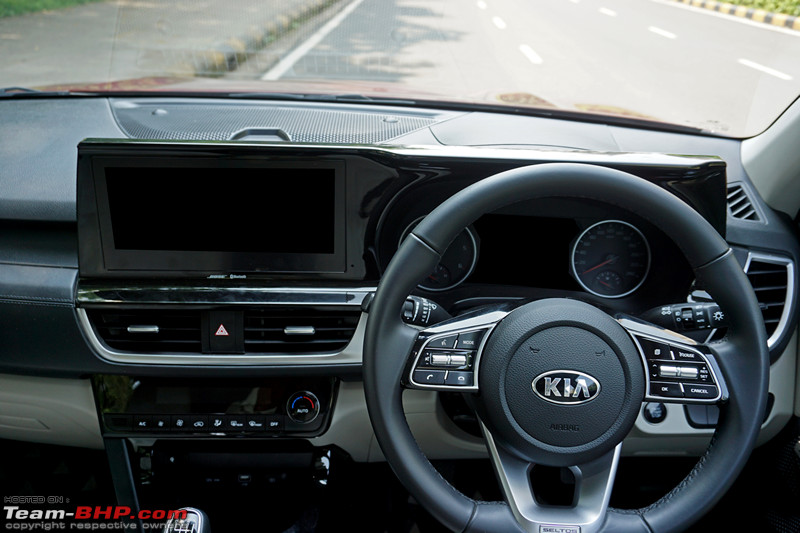 Instrument cluster is easy to read. Tachometer on the left & speedometer on the right (just the way we like it). Analogue temperature & fuel gauges too, with a 7" colour MID in between. Meters are backlit in white and have red needles. While the tachometer of the 1.4L turbocharged petrol is marked till 8,000 rpm...  ...the one of the diesel is marked till 6,000. Both the engines are free-revving in nature:  A system check is performed every time the car is started. Nice graphics! Also, the odometer is shown every time the door is opened: 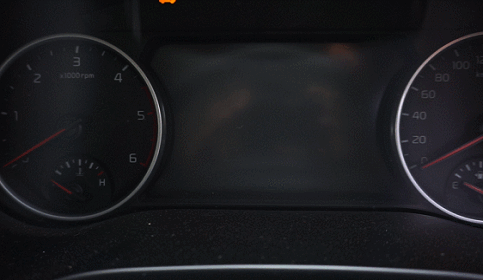 The MID shows average and instant fuel consumption, distance-to-empty counter, a single trip meter, digital speedometer & outside temperature reading. The trip meter shows the distance travelled, average consumption and time taken. The MID also displays turbo & torque meters which show you how much power & torque are being used. Very gimmicky. The digital speedometer is a sticky & remains on, no matter what you are viewing in the MID: 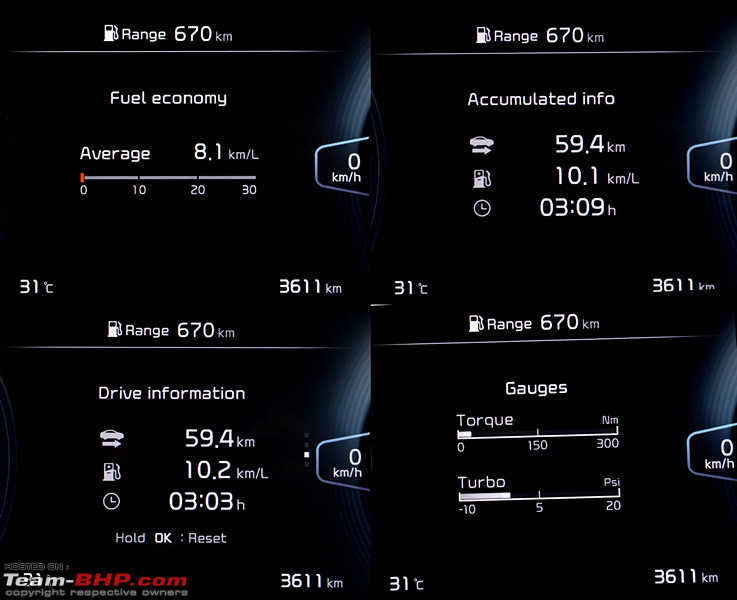 Other readouts include a TPMS and compass (pointless on a FWD car). The illumination of the instrument cluster has 20 levels of adjustment. MID has a parking sensor display as well:  The MID also displays the position of the lights and wipers (as you adjust their respective stalks). Quite cool! These readouts appear for a few seconds whenever the positions are changed. The MID further shows a summary of the drive when you switch the car off: 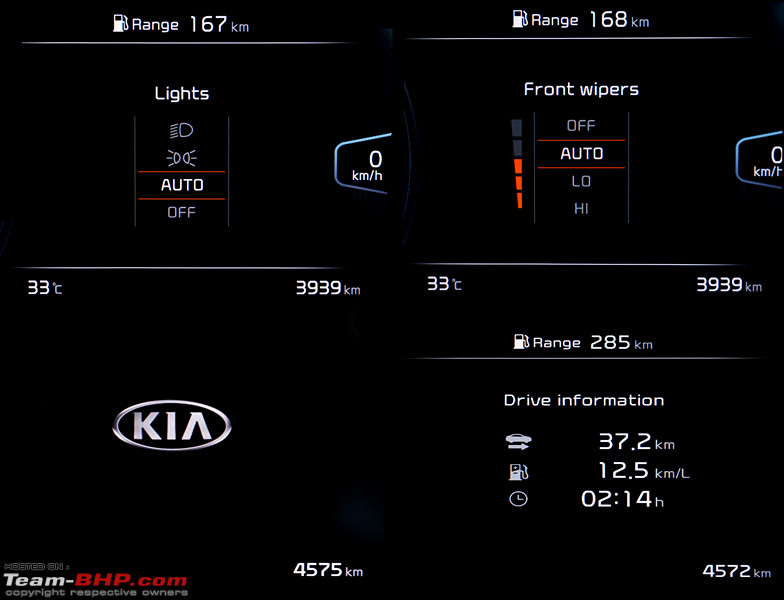 MID turns into a 'Blind View Monitor' when any of the indicators is turned on. The ORVM camera activates & this display shows you what's on the side. Useful while parking too (especially left camera to watch the kerb). Navigation directions are also displayed on the MID:  MID displays the specific door that is open. It covers the bonnet & tailgate too. The system sensibly warns you if the sunroof is open, only when the engine is switched off: 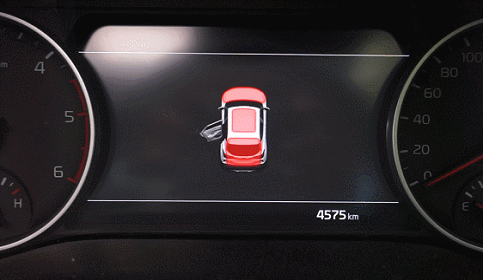 Stalks exude quality. Wiper and light stalks are shared with some Hyundai cars. Quality is excellent and the operation soft. Automatic wipers have been provided and there are five levels of settings for sensitivity. You do get auto headlamps as well. Foglamp switch is nicely integrated on the RHS stalk. Lane change indicator is standard on all variants:  Air-con vents are symmetrical and get a thick silver border. Air flow can be shut by moving the direction controller to the extreme left or extreme right for the right and left vents respectively. However, even with the vents in full shut position, some air keeps flowing out:  Switches for popping out the head-up display, dash illumination and headlamp level adjustments are located below. The traction control off button is also located here (don't ever use it unless starting off on slippery surfaces like slush & snow):  Tech Line does not get traction control or a head-up display. Hence, switches for those are replaced by blanks, which give a feeling that something's missing:  Black OBD port is located to the right of the fusebox:  Thin, yet sturdy bonnet release lever is located below the dash:  Fuel flap release is placed conventionally on the floor:  Like the dashboard, the doorpads get a beige & black colour theme. The beige area is in the middle. It is sure to get soiled if the user's hands are not clean. Tweeters & front speakers are housed in the doorpad:  HTX+, GTX and GTX+ variants get UV-cut solar glass on the front windshield and windows, which is claimed to stop ultraviolet rays from entering the cabin. God bless these solutions in our sunfilm-less era:  Shiny piano black insert houses the tweeters and silver door handles. The handles feel sturdy & long-lasting. While the plastics are all hard, the armrest is wrapped in leather. Red stitching in the GT Line looks cool. "Bose" badge carries weight in India. Convenient touch = Even if the driver's door is locked, just pull on the lever and the door opens (no need to use the unlock knob first). It's only on the driver's door & that's a good thing:  Console houses the usual set of buttons. Only the driver's window gets one-touch up/down and anti-pinch functionality, and only the driver’s window button is backlit. This car is so loaded, but something as practical and convenient as illuminated switches are missing!! Had to look for the lock / unlock switch at night, which sucks. Door mirrors are electrically foldable. ORVM adjuster selector switch is weird. One of the two mirrors is always selected - there is no middle / dead position. So, if by chance, you press the adjuster, one of the mirrors will change its angle. ORVMs can be closed electrically even after the engine is switched off. The opening & closing actions are damn silent. We respect such finer detailing:  Doorpad can hold a 1-liter bottle, and other small items:  A peek at the doorpad of the Tech Line (HTX+) variant:  No contrast stitching here:  Running board is not wide, making ingress / egress easier. GT Line gets 'Seltos' branded aluminium scuff plates while...  ...Tech Line gets a simpler black-plastic one:  Black & beige front seats of the GT Line and HTX / GTX+ variants of the Tech Line are draped in leatherette upholstery. This white'ish colour looks premium, but gets dirty way too easily. Under-thigh & back support are satisfactory. Importantly, the seats come with a cooling function which prevents the users backs from perspiring. Such a boon in hot Indian summers. Overall, we found that the driver's seat offers satisfactory support, even on long drives. On the downside, those with a heavy build might find them a size too small: 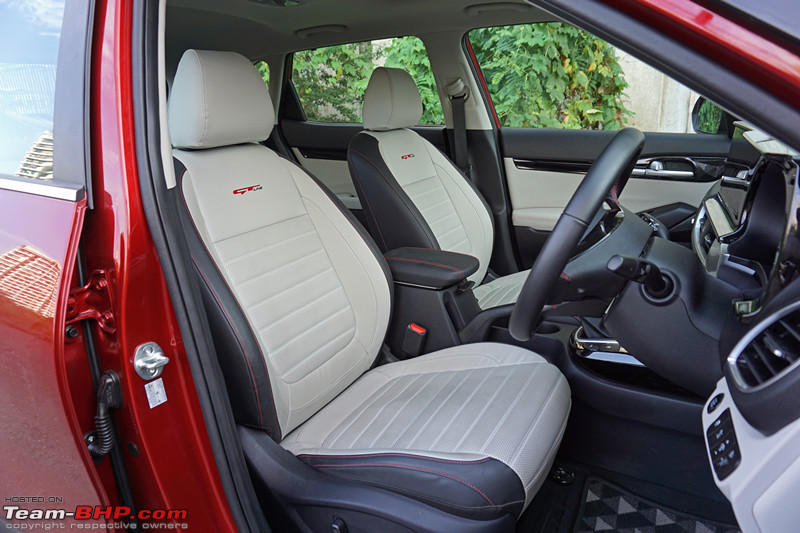 A look at the leatherette upholstered seats of the HTX+ variant. Nice pattern!  Driver's seat is 8-way electrically adjustable. Lumbar adjustment is not provided. These switches feel sturdy & durable. Finding a comfortable driving position is super easy:  Fore & aft travel range is enough to accommodate tall & short drivers alike:  Height adjustment range is healthy as well. Short or tall, no one will complain:  Basic manual adjustments for your spouse / date:  A close look at the tubular pattern leather seat upholstery of the GTX+ variant. Perforated material is mandatory for the seat's cooling function. The quality of materials used is good:  Red contrast stitching on the side looks nice:  "GT Line" has been embossed on the backrest:  A close look at the honeycomb upholstery pattern of the HTX and HTX+ variants. Other Tech Line variants get black fabric upholstery:  Center armrest has a soft leather cladding with red stitching. While it is not adjustable, the armrest is conveniently placed and most drivers will find it comfortable to use. Still, that's no excuse - in a car as well-equipped, this important driver tool should have been adjustable: 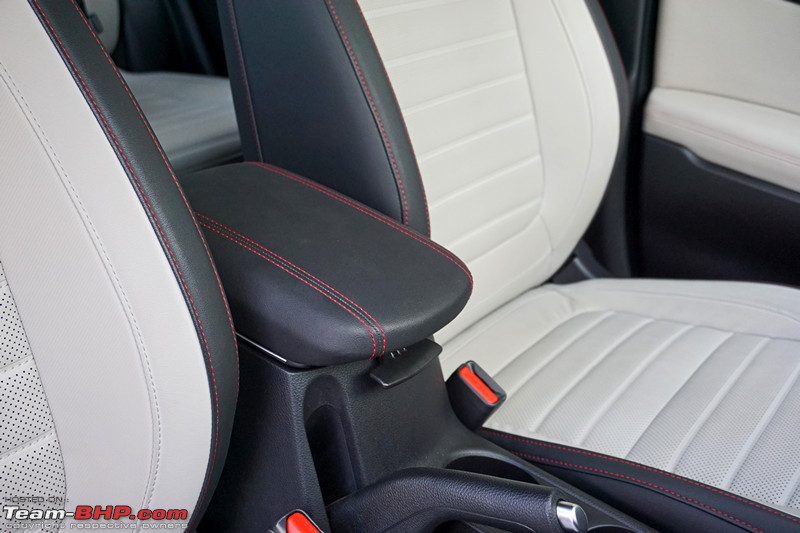 Like the other parts, the Tech Line's armrest does not get red stitching:  Seatbelts are height-adjustable. Both front seatbelts get pre-tensioners:  Pedals are properly spaced out. A very usable dead pedal has been provided as well. While the A, B & C pedals of the GT Line are finished in sporty aluminium with black rubber grips...  ...those of the Tech Line are regular black rubber grips. The clutch in both, the petrol as well as diesel variants, is light but it has a longer travel range than we expected:  Floor mats have an attractive beige & black design pattern. Looks nice, although it will get dirty easily. India isn't a country for beige anywhere on the flooring of cars:  The ORVMs are sufficiently tall and wide, providing a good view of the action behind: 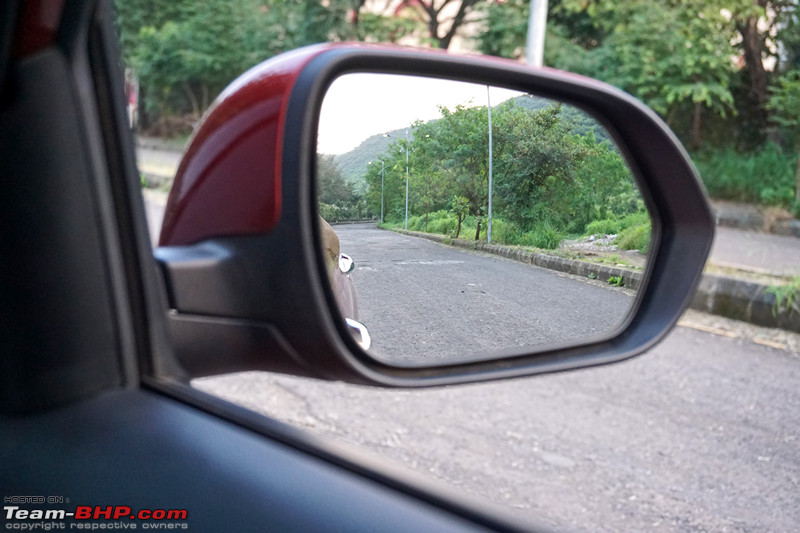 IRVM is very unique and looks upmarket. It is wide enough to cover the entire rear windshield. Rear headrests and thick C-pillars restrict visibility though: 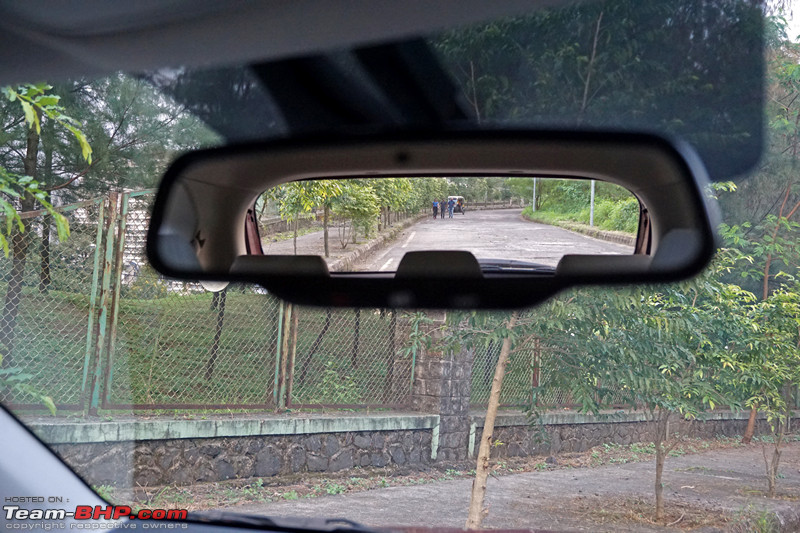 Like we saw in the Hyundai Venue, the IRVM houses 3 buttons - SOS will place an emergency call to Kia customer care, the button with the tow truck will call Kia Roadside Assistance and the third button will launch UVO (telematics). Auto-dimming function has been provided as well:  Sensor for the 'automatic headlamps' is located behind the IRVM:  Like most crossovers, the rearward view is average at best. As mentioned earlier, the rear windshield is fair in size, but the C-pillars are thick. Better to rely on the reversing camera & parking sensors:  Center fascia tilts slightly towards the driver. It features a floating touchscreen head-unit with a piano black finish. A thick silver border runs around the sides and under the air-con vents, as well as the gear lever. The climate control area gets a piano black surround too: 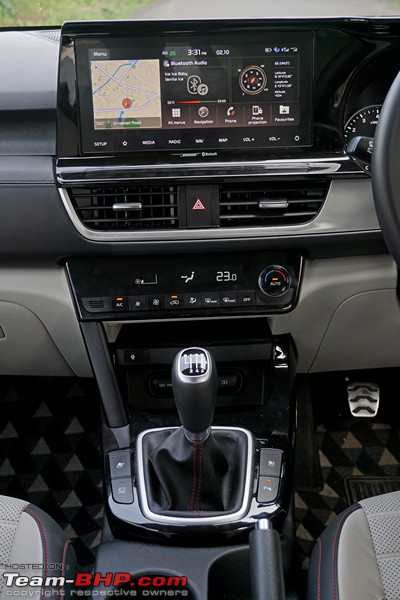 Center speaker is located on top of the dashboard: 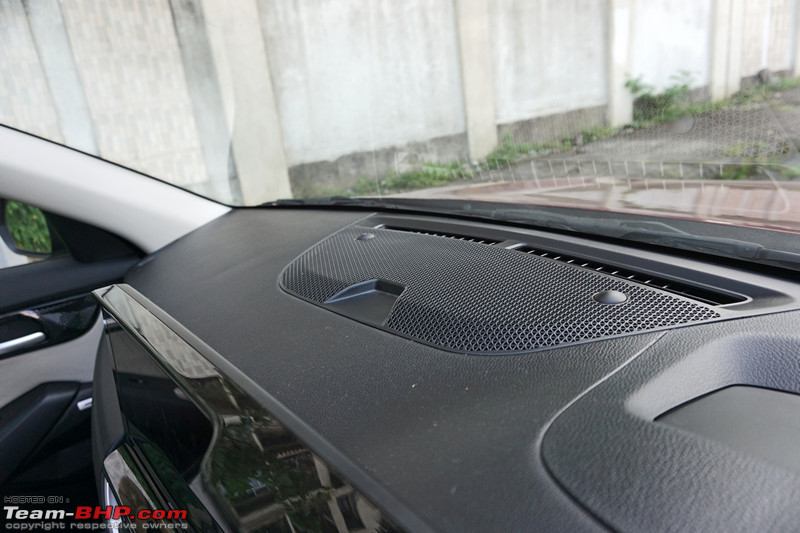 Solar sensor is located on the right: 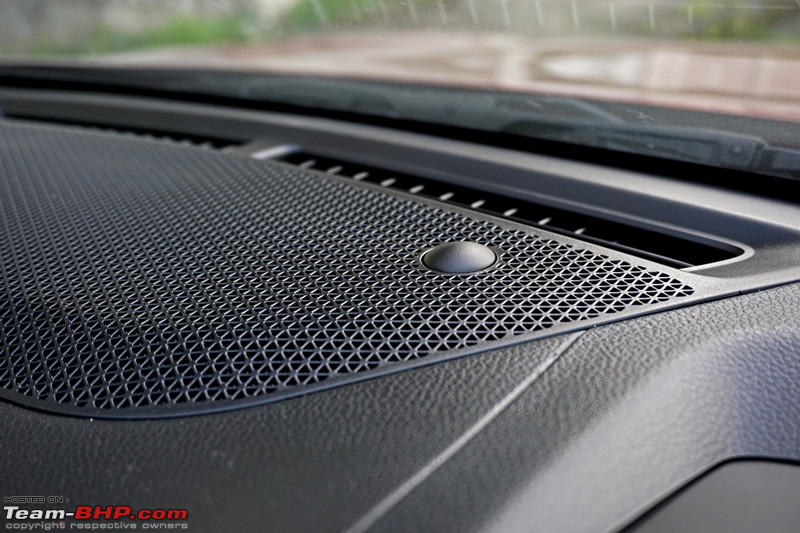 Tiny, red security alarm indicator flashes when the car is locked: 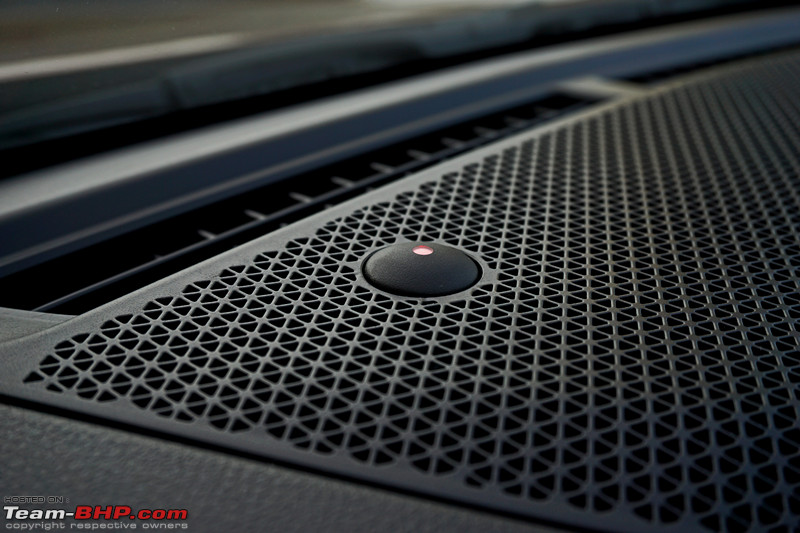 GTX, GTX+, HTX and HTX+ get this tablet-like 10.25-inch HD touchscreen head-unit. Its functions are covered in detail in a separate post: 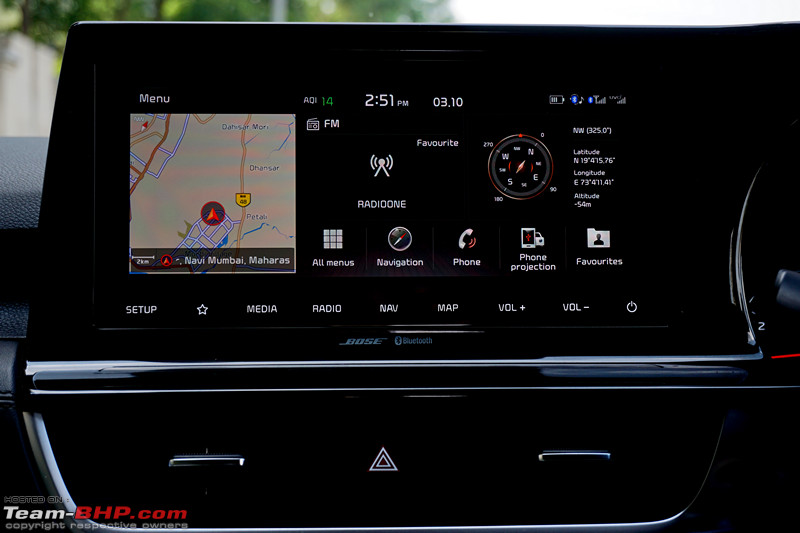 Central air-con vents have a silver border on the sides and below. While the right vent can be shut by moving the direction controller to the extreme left, it's vice versa for the left one: 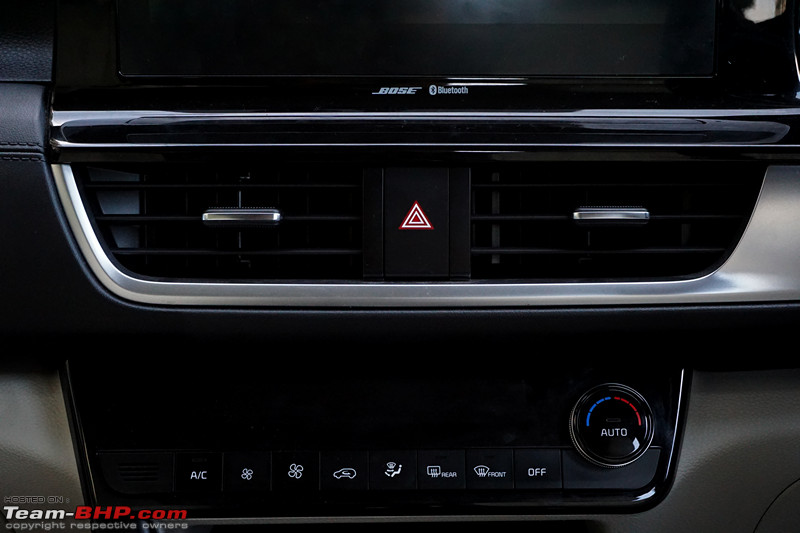 Simple and easy-to-read climate control system gets a shiny black border. The blower has 8 levels of adjustment. At levels 1 and 2, it is silent. At levels 3 and 4, it gets audible. At levels 5 and 6, it is loud, while on levels 7 and 8 - the noise is excessive. The lowest temperature that the system goes to is 17 degrees centigrade before hitting 'LO', while the highest temperature level is 27 before hitting 'HI'. The cooling performance is excellent. The systems on both our early MT test cars had bugs. The air-cons randomly stopped cooling at different times without any setting being changed. But the later AT cars that we got had their air-cons working perfectly: Kia has equipped the Seltos with Eco Coating - a technology that is claimed to eliminate air-conditioner odour. Sounds familiar? Yep, Hyundai uses it too: 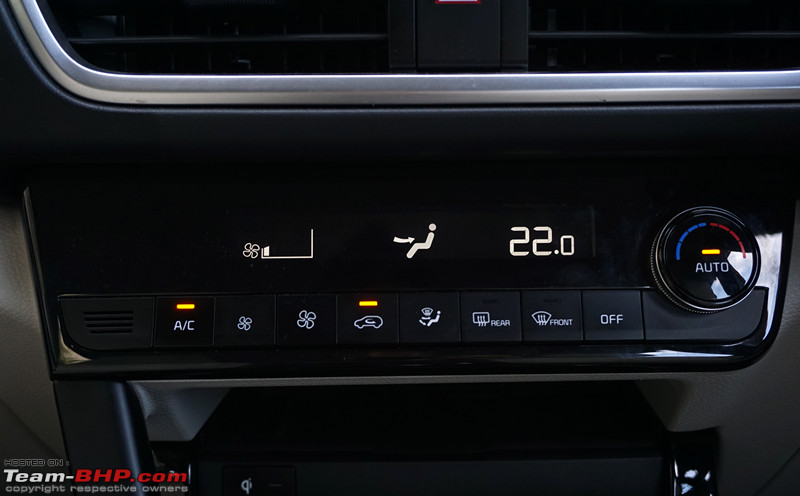 Below the climate control panel is a 10W wireless smartphone charger. Remember, your smartphone needs to have the wireless charging function for this feature to work. You should not place coins or the smartkey here: 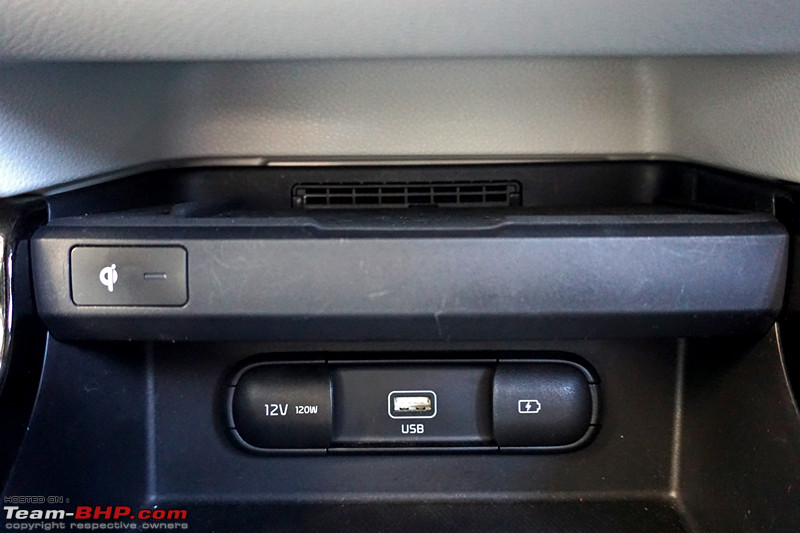 2 USB ports and a 12V power outlet are located at the base of the center fascia. The USB port on the right can only be used for charging, while the one in the middle can be used to connect your smartphone to the infotainment system (e.g. Android Auto). 12V power outlet and right side USB port get flip-type plastic covers. Nope, there's no Aux-in port. Storage area is big enough to hold a 6" smartphone: 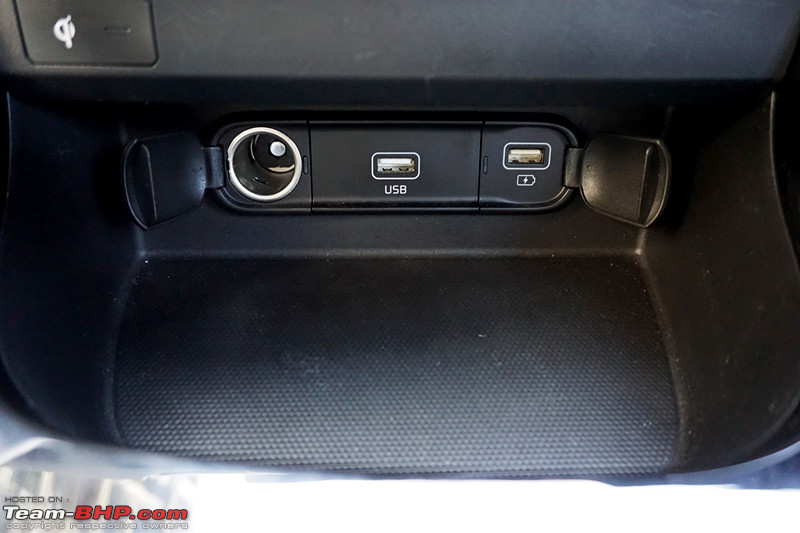 Single grab handle on the left of the center fascia. For the passenger? 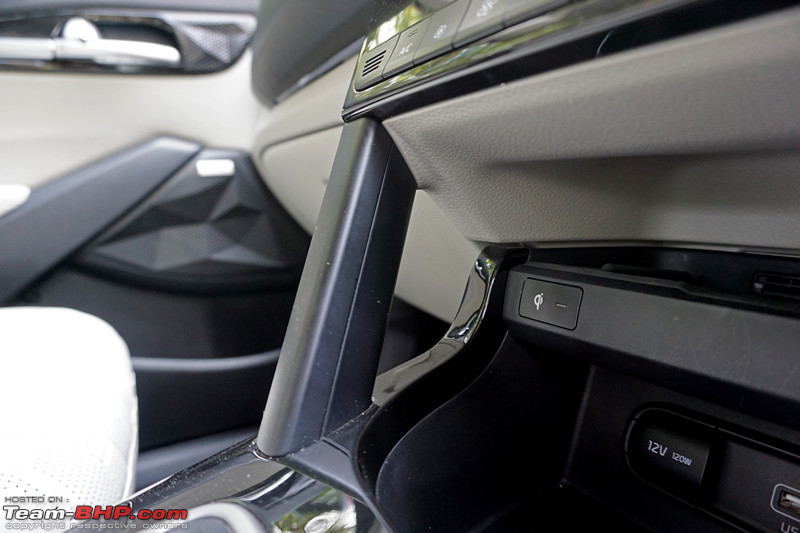 Bird's eye view of the center console: 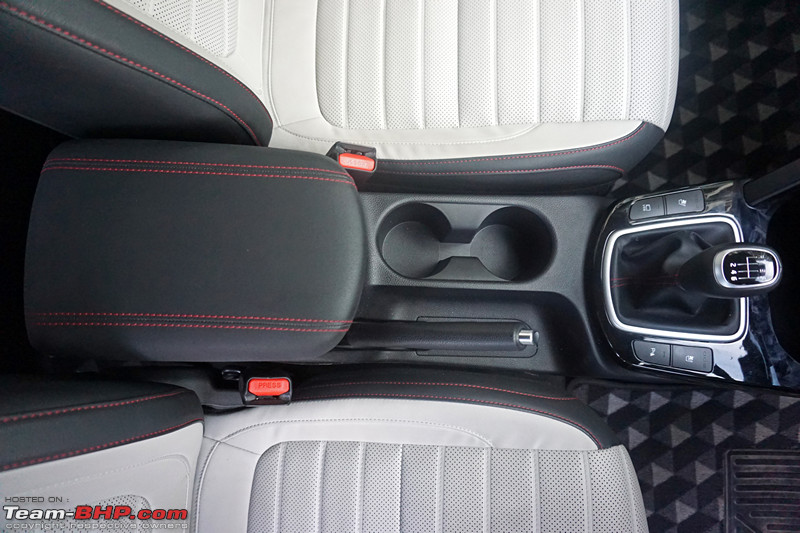 Buttons for the cooled seats are located here. Pressing the button once takes the cooling straight to level 3 - the highest setting! Pressing it subsequently brings it down to levels 2 & 1, and then off. This feature proved extremely useful in the October heat of Mumbai. Buttons to manually activate the 360 degree camera and parking sensor are placed here as well: 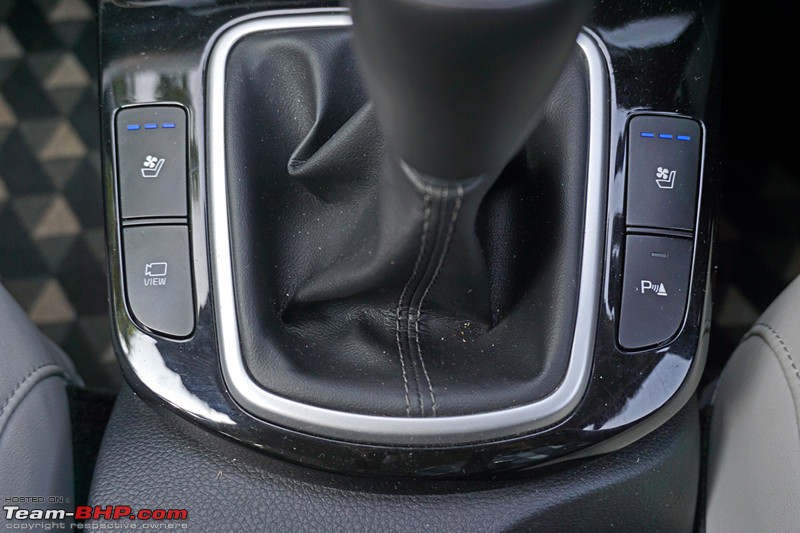 Two cup-holders to the left of the handbrake: 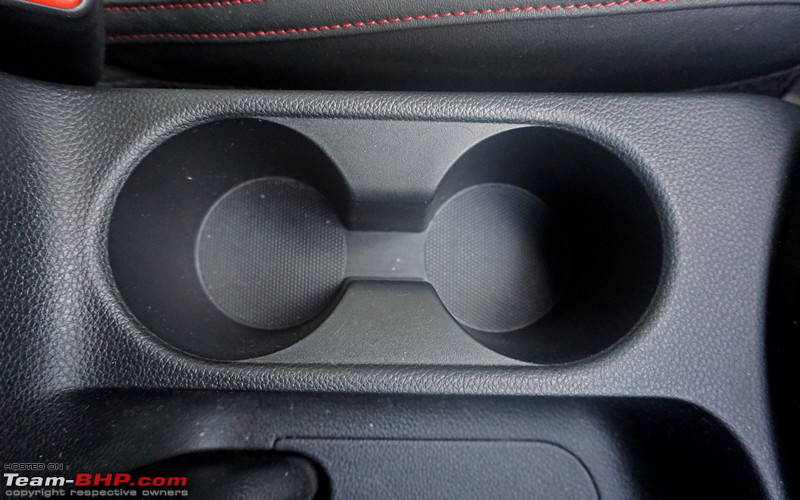 The GTX, GTX+, HTX and HTX+ variants get a cabin air purifier with perfume dispenser, which is placed below the center armrest. This is a first-in-segment feature and can be activated through the ICE head-unit. The air quality index is displayed on the head-unit as well as a small screen behind the center armrest (for rear seat passengers to see): 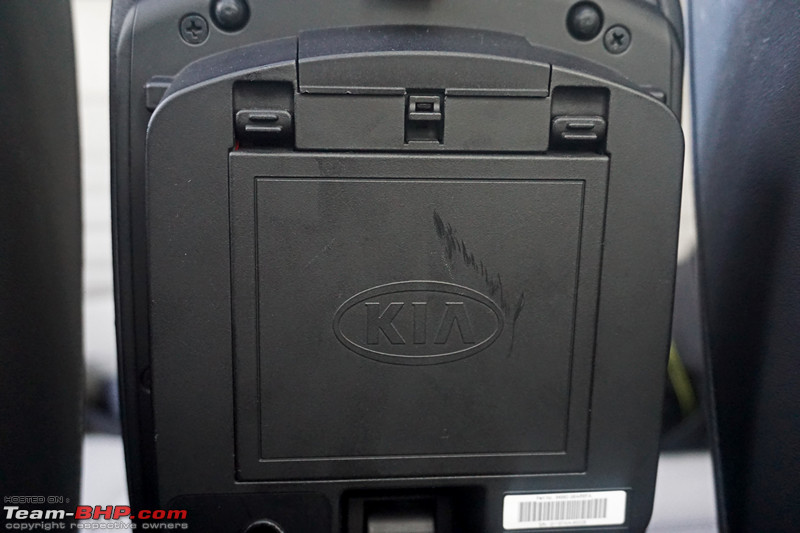 Remove the cover to gain access to the filter: 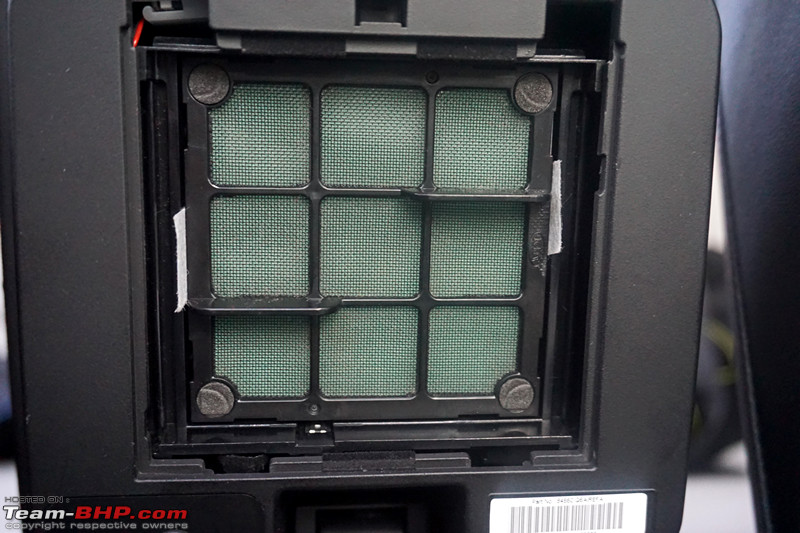 Air is sucked in from the sides of the center armrest, and purified air is then let out through the front and rear. Fan speed can be altered as well (through the head-unit). The perfume cartridge is located just ahead of the fan: 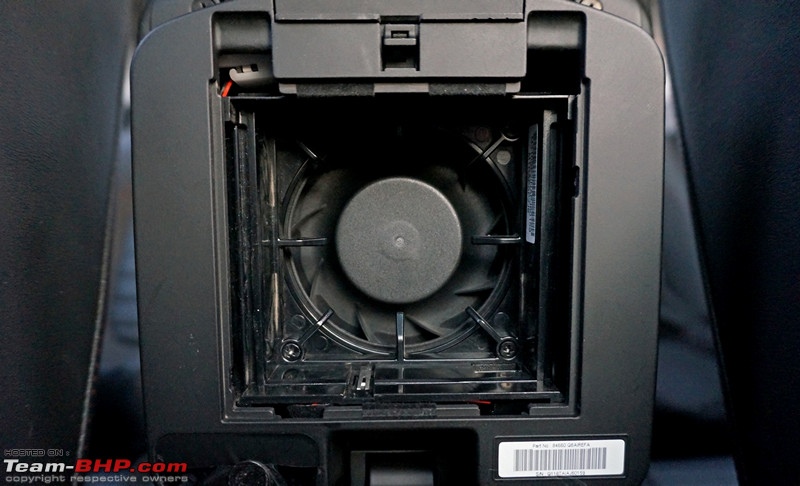 The filter can be removed for cleaning. The infotainment head-unit will tell you (in the number of hours) when you need to clean it. If you want to know how bad the quality of air is in India, try this. In Bombay, the AQI display was reading "7" with the windows up. The minute I rolled both the front glasses down, it shot up to 70 in a minute! 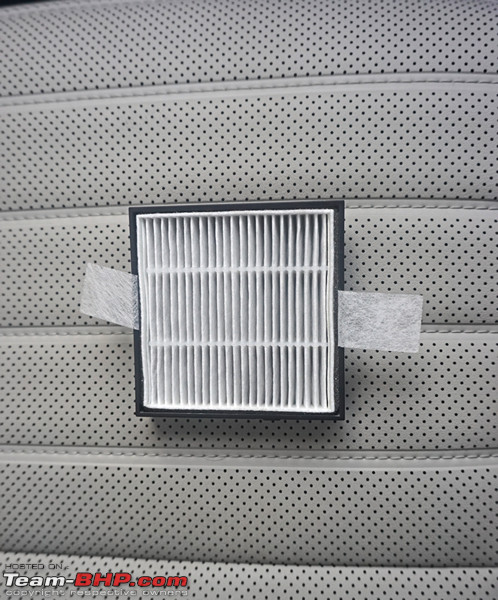 Center armrest has a deep storage compartment underneath. It has a soft lining on the floor: 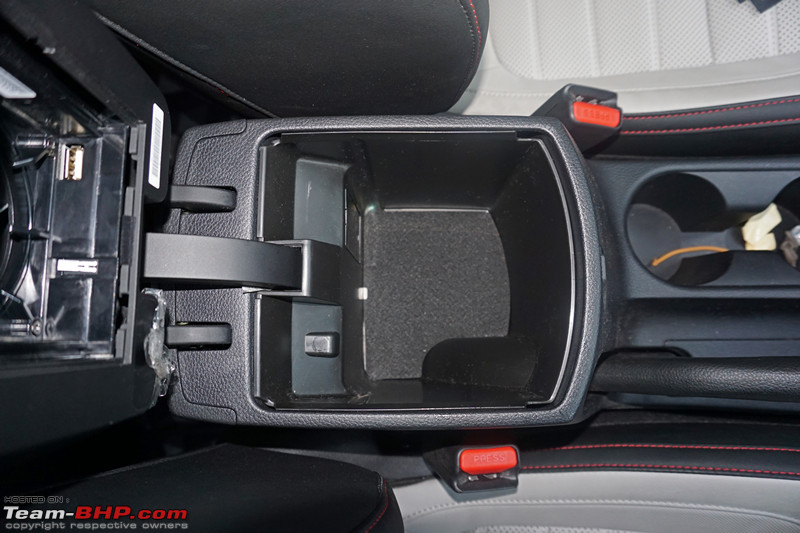 Leather insert above the glovebox is the only soft material used on the dashboard. For once, even in the GT Line, there is no contrast stitching here! 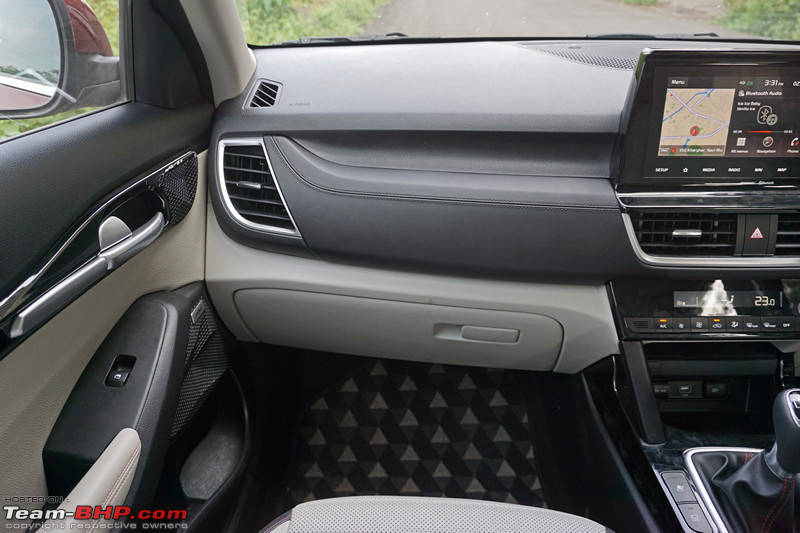 Glovebox is well-sized. No illumination or cooling - features that are expected in a car from this price bracket: 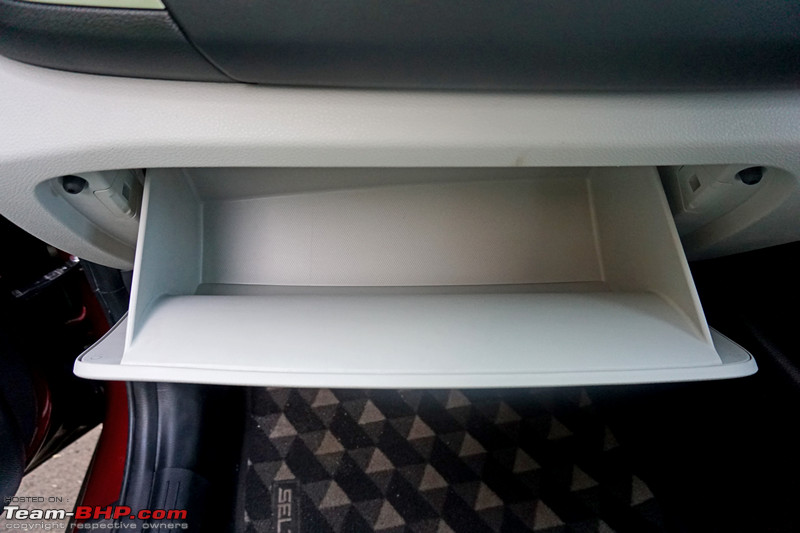 Roof bezel consists of map lights and sunroof controls, Bluetooth mic and sunglass holder. You can start the front + rear cabin lights from here. After locking the car, all cabin lights go out with a theatre-dimming effect. Even if the cabin lights are left in the ON position, they will go off when you lock the car from outside (to prevent battery drain). For obvious reasons, things are very similar to Hyundais in here: 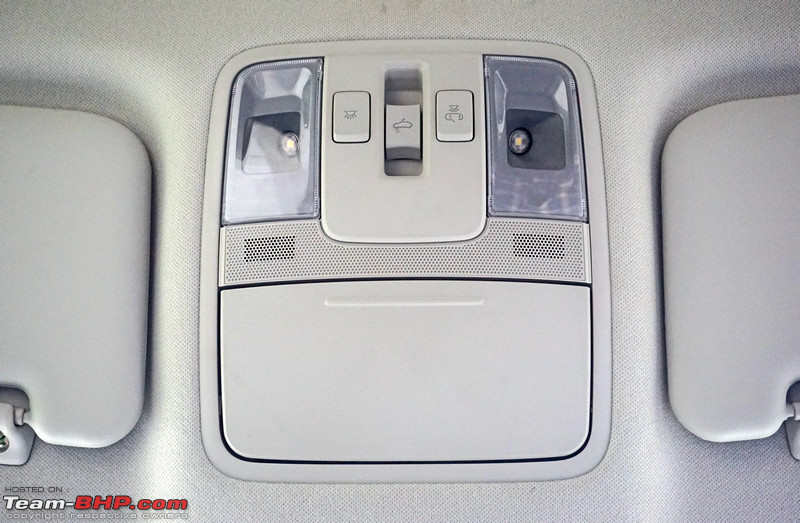 Sunglass holder has a soft opening action, and a protective lining on the inside to prevent your sunglasses from getting scratched: 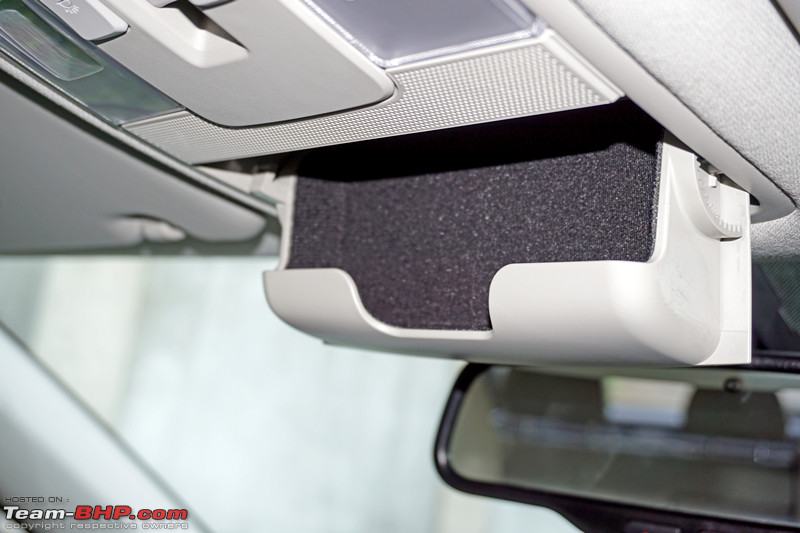 Sunvisors are economy-grade in design, yet they don’t feel flimsy. Driver-side unit merely gets a flap to hold tickets (no mirror or illumination): 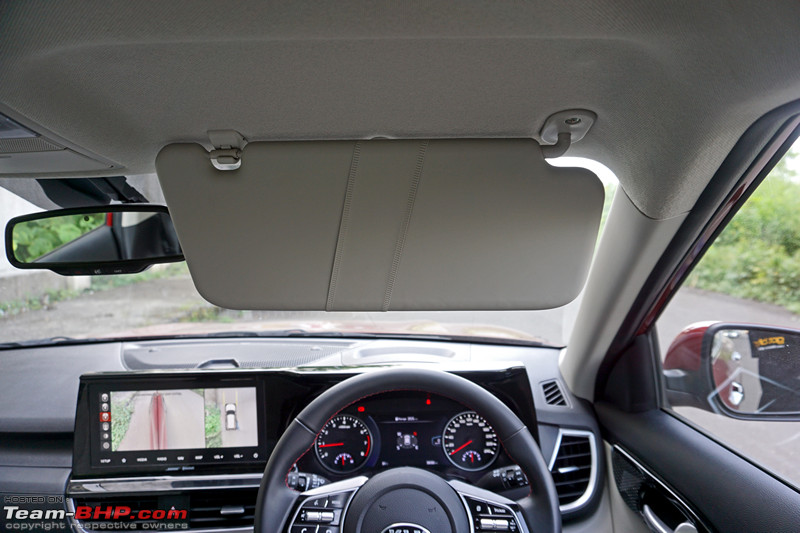 Passenger-side sunvisor gets a vanity mirror, but there's no cover or light provided: 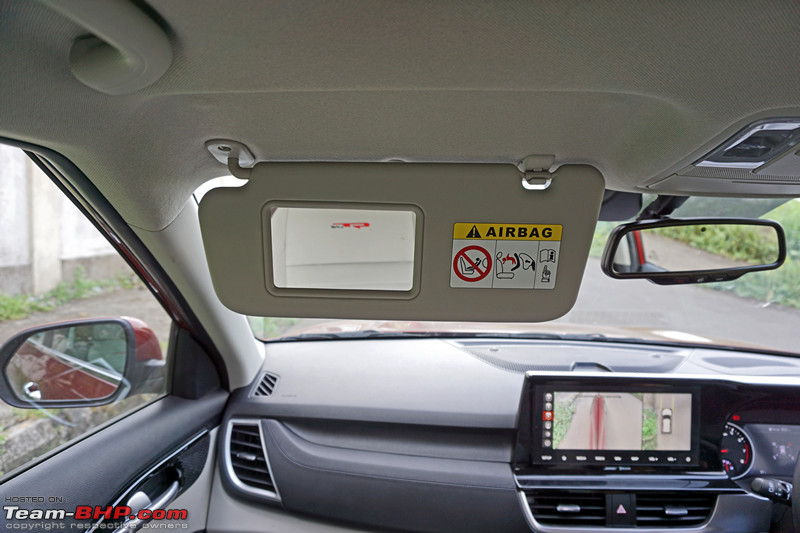 Dual airbags are standard on all variants of the Seltos. GTX+ trim gets 6 airbags in total. These include… 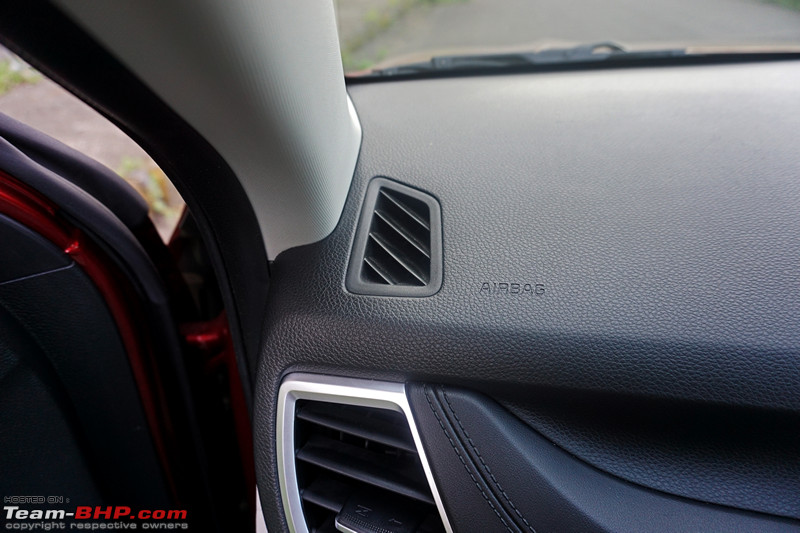 …side airbags (no seat covers here please)… 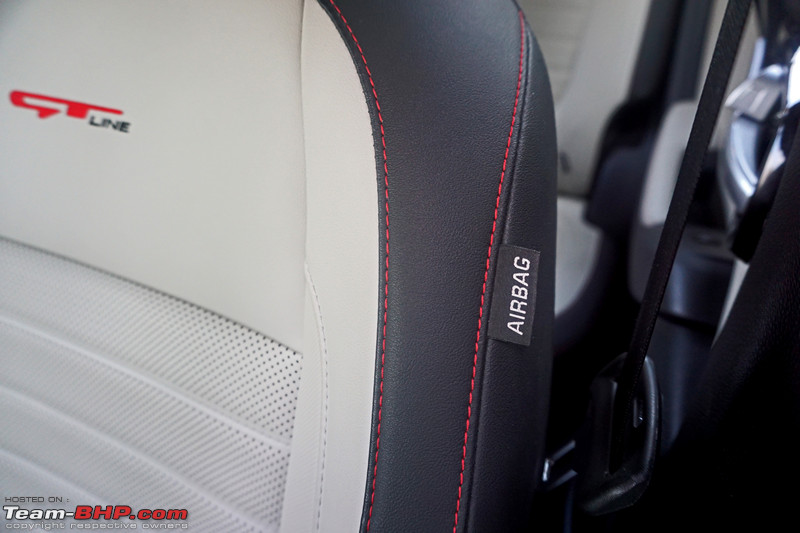 …and curtain airbags: 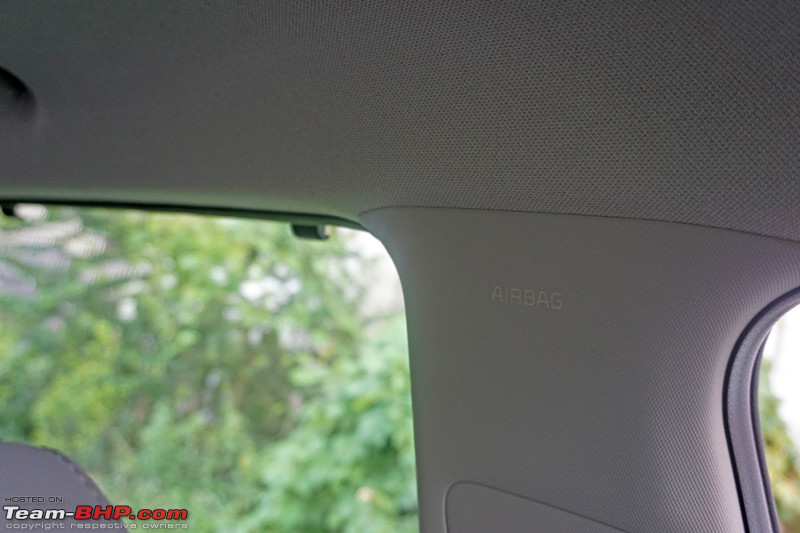 Sunroof cover is manually-operated: 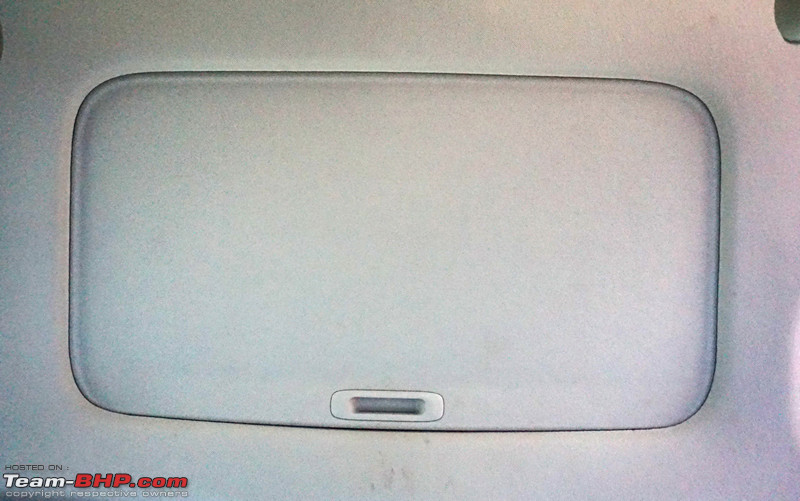 The size of the sunroof is a bit smaller than we'd have liked: 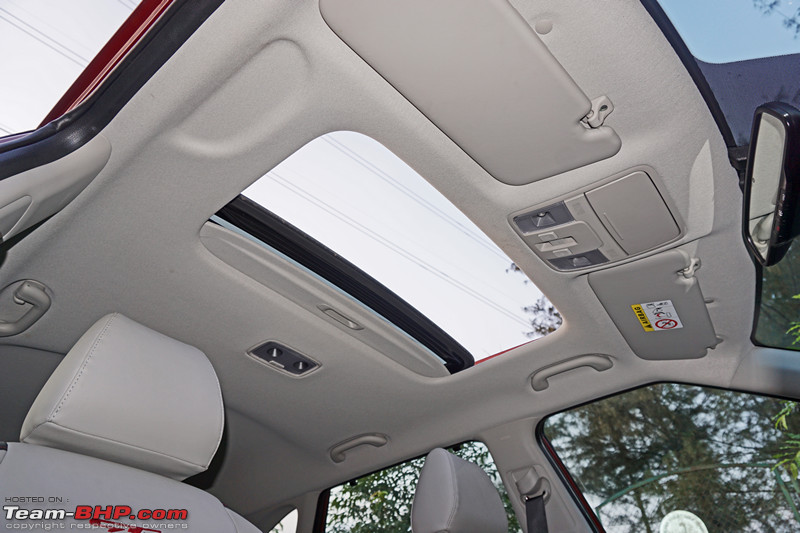 You can pop it up for ventilation, by pushing the sunroof button upwards: 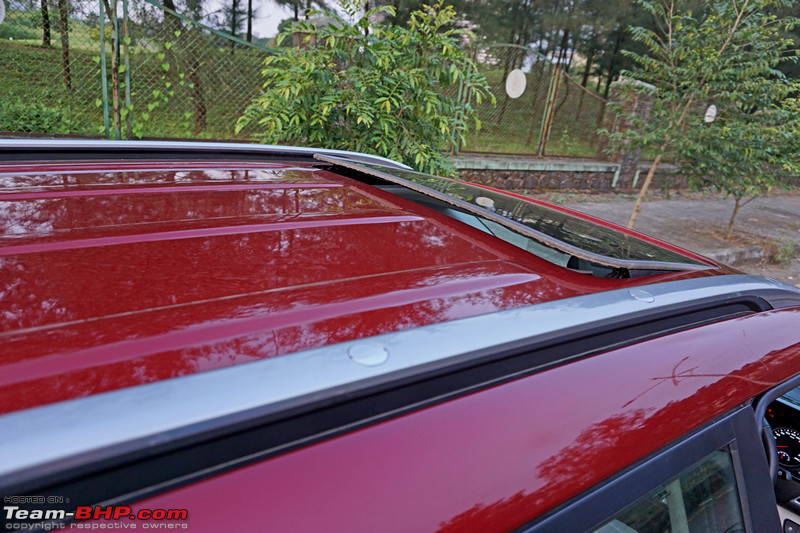 With the sunroof (or even its cover) open, a lot of light comes into the cabin. This is the max it opens to: 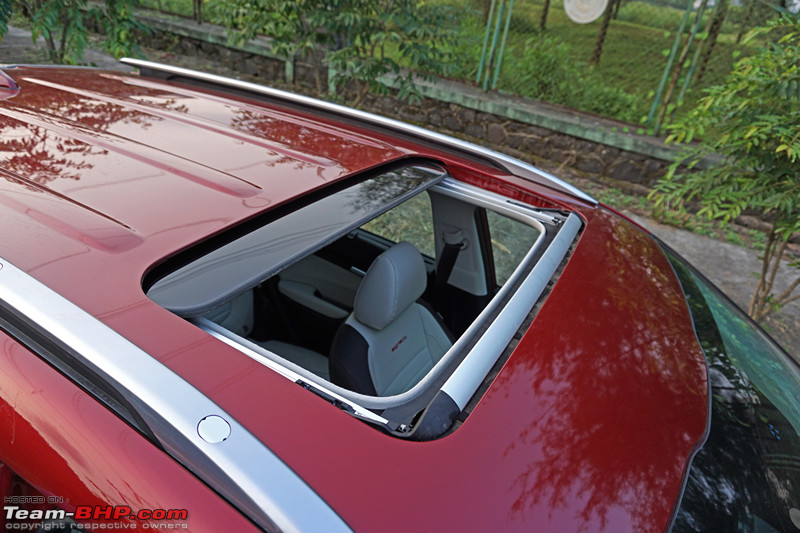 Things are organised even in places where most owners won’t look. There are no loose wires or cables dangling anywhere. Here's a look below the dashboard in the driver's footwell... 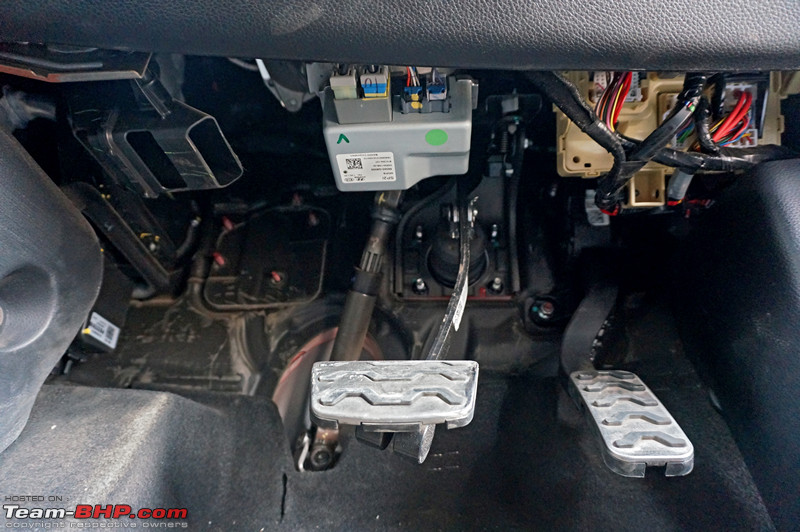 ...and the passenger's footwell: 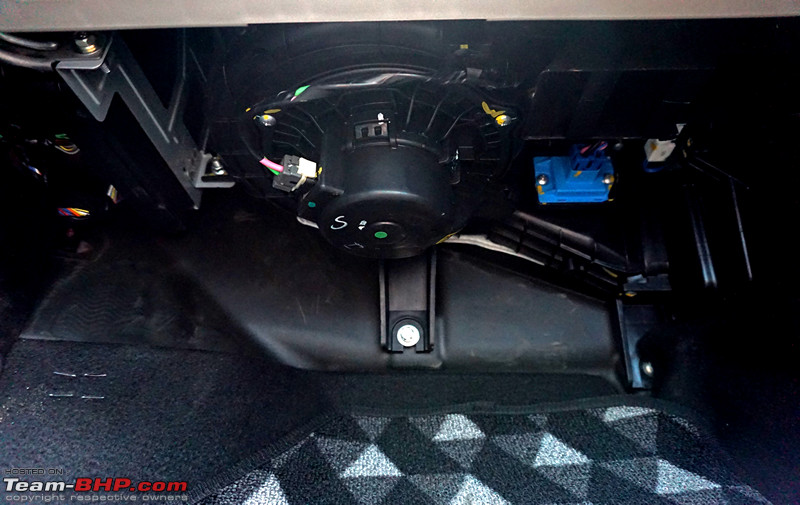 Last edited by Aditya : 6th January 2020 at 07:31. |
| |  (61)
Thanks (61)
Thanks
|
| The following 61 BHPians Thank Aditya for this useful post: | ach1lles, AdityaDeane, aghate, akshay81, amit1agrawal, arbaz906, BlackPearl, bullock-Car, BZ25, carenthusiast, carrazy, Chrome6Boy, dailydriver, Dani7766, dksv, frankmehta, Gannu_1, gkg2423, GTO, hemanth.anand, hmansari, InControl, Ithaca, jailbird_fynix, JoseVijay, laferrari, lemedico, libranof1987, low_range, MDED, Mevtec, MSAneesh, N33raj, NPV, Nrulz, PapaKiloSierra9, phoenixash, PM - B, Puffdamgcdragon, RaghuVis, Rajeevraj, RavenAvi, regenitin, Reinhard, REN, Researcher, Rigid Rotor, S.MJet, sanj47900, searacer932, shipnil, Simat, smuniswami, SS4, THE_DRIFTER, uday.ere, vb-saan, Vik0728, vivekn83, vredesbyrd, wheelguy |
| | #5 |
| Team-BHP Support  | Interior - Rear The rear doors of the Kia Seltos open and close in a two stage action. They swing out sufficiently wide and the floor isn't too high off the ground. This makes ingress & egress convenient:  There is enough space between the seat and B-pillar to move your feet in & out:  Just like the front, the door sills are not wide. GT Line gets Seltos branded aluminium scuff plates, while...  ...the Tech Line gets simpler black-plastic units:  Black & beige theme continues on the rear doorpads. The rear speakers are housed behind a funky grille with prominent 'Bose' branding. Shiny black strip does add some character to the doorpad:  Door pockets can hold a 1-liter bottle and some knick-knacks:  Again, like the front, the rear doorpads are made of hard plastic, but there is a soft leather cladding for the armrest. The GT Line gets red stitching on this armrest:  The seat has contours for support & 3 adjustable headrests have been provided. Rear seat is better for 2 adults and a kid (rather than 3 healthy adults). Also, the middle area of the backrest protrudes (due to the armrest) and the seatbase is elevated in the middle as well:  A look at the rear seat of the Tech Line. Even this variant gets three adjustable headrests and a center armrest:  Legroom is healthy and two 6-footers can sit one behind the other in reasonable comfort:  All occupants get soft & adjustable headrests. Side occupants get three-point seatbelts, while the middle passenger gets a lap belt:  ISOFIX child seat anchors have been provided on both sides. This feature is provided in all variants of the Seltos barring the HTE, HTK and HTK+:  A look at the maximum and minimum legroom available:  With the front seat in my 5'10" driving position, I have about 4" of knee room to spare. With the front seat moved all the way back for a 6+ footer, my knees almost touch the seatback, but I can still sit without issue:  The seatback has a comfortable angle. Headroom is good. At 5'10", I had ~3" of clearance and found the thigh support to be alright (as seen in the pic). Taller people might find the seat to be a little lower than expected though:  Apart from their resting position, the soft headrests have 3 levels of adjustment. They are very useful:  Seatbacks have h-a-r-d plastic surfaces with two small scoops (each) where the rear passengers' knees would be placed. This hard seatback is required for the ventilated seats, but it is a BIG FAIL for rear passengers. I absolutely hated the feel of hard plastic on my knees. Luckily, lower variants (without ventilated seats) do NOT get these rock-hard seatbacks. Both front seats come with wide & deep seatback pockets for storage:  The surface at the base of the seats is soft, and there is enough room to tuck your feet in:  The center armrest is positioned at a comfortable height:  It is wide & soft, and comes with two cupholders:  Window line rises toward the rear. Still, there is enough light coming in. The rear quarter glass + beige interior colour prevent the cabin from feeling claustrophobic:  The window rolls almost all the way in (tiny portion of the glass is visible near the B-pillar):  Pull-up sunshades have been provided in the GT Line and HTK+, HTX and HTX+ variants of the Tech Line. With sunfilms banned, these prove to be an effective way to protect yourself from the harsh sun. Rear passengers will love it! See that additional horizontal strip? It is located where there is a curve on the curtain. This plastic stick adds a bit of rigidity to it, else it will fold in the long run:  Rear air-con vents are provided on all variants:  Small screen displays the air quality index inside the car. It can be switched on or off through the infotainment head-unit:  USB port at the base of the console for rear passengers to charge their smartphones. A small cubby next to it can be used to place the smartphone while charging:  Spring-loaded grab handles have been provided above all passenger doors. Only rear-right unit gets a coat / bag hook:  The seatbelts can be parked in these slots (when folding the rear seat down):  Whitish-grey roofliner dips down where the sunroof slides in. 2nd cabin lamp is placed behind the sunroof, hence serving both (front & rear) seat rows: 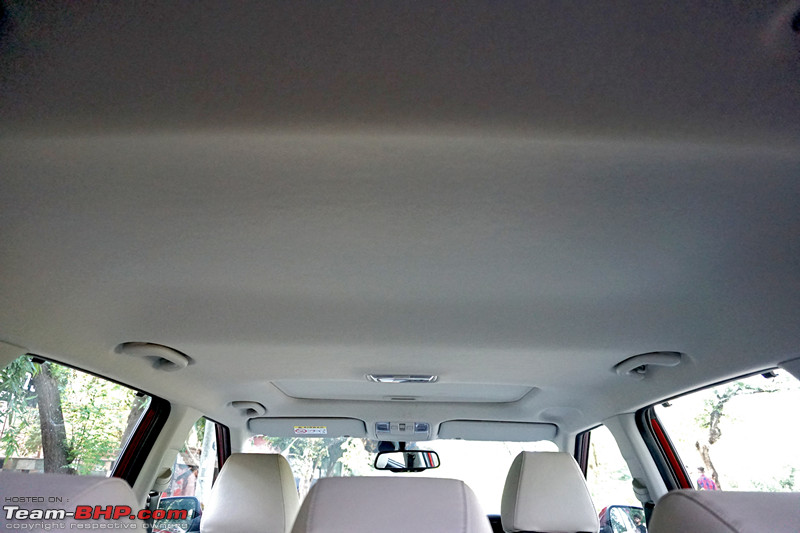 Rear cabin lamp has one button with two positions - ON (pressed) or door (not pressed). There is no "OFF" position (which is pointless anyway). It functions independent of the front cabin lamps:  The floor hump is on the taller side. It is also quite wide. This, and the air-con unit, will restrict legroom for the middle passenger. It will be best for him to place his feet on either side of the floor hump:  On paper, the 433-liter boot is larger than the Creta's (402 liters) and Harrier's (425 liters), but way smaller than the MG Hector's (587 liters). We frankly feel its smaller than its 433L rating would indicate. The opening is wide, which makes it convenient to load luggage:  Large parcel tray comes with a recessed area and prominent border to keep things in place. It gets strings which attach it to the tailgate & lift it up when you open the boot:  Removing the parcel tray makes the boot appear much bigger. This should easily swallow your family's vacation bags:  Boot light is located on the left:  Storage cubicles have been provided on either side of the boot. The one on the right side is slim and long...  ...while the one on the left is wider:  Cargo tie-down hooks are provided in the 4 corners of the boot:  For reclining the seats, this plastic flap has to be pulled up. The same flap has to be pulled to fold the backrest down for increasing cargo space:  Rear seats can be reclined individually. Here's the difference in the angles between the reclined & regular positions:  There is a clearance between the seatback and parcel tray with the backrest in its regular position. With the backrest reclined, this gap disappears:  GT Line, HTX and HTX+ variants get a 60:40 split on the rear seat:  Folding the seatbacks down gives you much larger cargo capacity. However, the Seltos doesn't come with an adjustable boot floor and you cannot get a f-l-a-t floor:  Top tether for the child seat (there's one on each side of the rear seat):  Pic taken from the inside with the tailgate shut. Loading lip is not high and is almost level with the boot floor. Makes it easy to take your bags out:  Only the lower part of the tailgate gets cladding on the inside. We would have liked 'full cladding' in a premium car. Still, there are no ugly bits sticking out anywhere. All the wiring is properly concealed, including the demister's:  A tailgate emergency opener has been provided at its base:  Strap to lift the boot floor up:  Tools are housed in a soft bag, which sits in the spare wheel. Lots of empty space around the spare tyre to keep odd items, cleaning sprays etc:  Spare wheel in all trim levels is a 16" steel unit with 205/65 section Good Year Assurance rubber. In a premium product like the Seltos, the higher variants should definitely have gotten a spare of the same size as the regular wheels. When using a thinner space saver, remember to drive very cautiously (due to the varying tyre sizes & grip levels):  Toolkit has the regular tyre changing equipment. We like their black colour (tools are usually provided in silver):  Last edited by GTO : 27th December 2019 at 07:43. |
| |  (55)
Thanks (55)
Thanks
|
| The following 55 BHPians Thank Aditya for this useful post: | ach1lles, AdityaDeane, aeroamit, aghate, akshay81, amit1agrawal, arbaz906, ashking101, AYP, Bee, BZ25, carrazy, Chrome6Boy, Col Mehta, dailydriver, Dani7766, dksv, earthian, GTO, haisaikat, Hayek, hemanth.anand, hmansari, InControl, Ithaca, jailbird_fynix, JoseVijay, laferrari, Leoshashi, libranof1987, MDED, MSAneesh, N33raj, NPV, Nrulz, Puffdamgcdragon, RaghuVis, RavenAvi, regenitin, Reinhard, REN, Researcher, Rigid Rotor, S.MJet, sanj47900, searacer932, Simat, skchettry, SS4, THE_DRIFTER, uday.ere, vb-saan, Vik0728, vivekn83, wheelguy |
| | #6 |
| Team-BHP Support  | In-Car Entertainment The higher variants of the Kia Seltos get a 10.25" HD touchscreen head-unit with a 400W Bose sound system + 8 speakers (including 2 tweeters and a subwoofer). Sound quality is overall 'very good' & owners will be happy; however, it is not 'exceptional' as you would expect after seeing the Bose badges. GTO says that he enjoyed the MG Hector's sound system more. Still, this one is good too and it's very important for you to set the equalizer up to your preferences. Has the usual connectivity options, including video playback via USB. The system is also connected and has "UVO" (which Kia has translated from "your voice") with 37 features. Connectivity via the embedded SIM card is free for 3 years. The touchscreen has no lag and its visibility is good, even under direct sunlight. Screen resolution & clarity are very impressive. No physical buttons for the main functions have been provided though. 10.25-inch floating head-unit sticks out of the dashboard and looks like an extension of the instrument cluster. Design & clarity are impressive:  Music is played through 8 speakers – one on top of the dashboard, one on each door (superbly designed funky cover too)…  …a tweeter on each of the front doors...  ...and a subwoofer in the boot:  Amplifier is located under the front passenger's seat:  You can have a split screen with lots of concurrent displays (map, media / Android Auto, compass etc.):  The custom (star) button can be assigned to a desired function:  Love these small touches! You can choose the options for the steering's mode button:  Auto-illumination works smartly & is independent of the headlamps. Example = during the day, we drove under an overpass (with the headlamps off); the screen immediately turned to night mode, and then back to day mode once we cleared it. Additionally, the display can be switched off from this screen (for night driving). To bring it back to life, simply touch the screen anywhere:  The ambient light settings. One can get the mood lighting to flicker with the music being played (cheesy & cheap IMHO)...  ...or just glow steadily according to the colour chosen (our choice). You can also adjust the brightness of the ambient lighting:  The head-up display settings (height & brightness):  You can choose the information you'd like to see on the HUD...  ...and adjust the size + colour of the digital speedometer:  Colour options include orange, white and green - surprisingly similar to our national flag!!! Coincidence or intended?  Interestingly, the volume of the parking sensors can be set:  The auto-locking and unlocking functions of the doors can be enabled or disabled. Thank god auto-unlocking can be turned off! It's not an apt feature for crime-laden India:  The system tells you when the service is due, in terms of days and kilometers. These can be altered by the user (default was 10,000 km / 12 months which is the recommended interval):  You can alter the 'auto reset' of the fuel economy reading:  We love the 'driver approach' feature, whereby the ORVMs fold out as you walk to your Seltos:  The climate control will switch to "fresh air" mode automatically if it has been in the recirculation mode for a certain period of time. This is quite important as driving for long durations in 'recirculation mode' can make you drowsy - more information:  The system displays a summary of the driving information, based on your driving pattern:  The air purifier's fan speed can be adjusted from here. The rear display (above the rear air-con vents) can be turned on / off:  An estimate of when one needs to clean the filter of the air purifier:  Air quality index is displayed at the top of the head-unit:  Smartphone pairing via Bluetooth is very easy, but remember, it cannot be done when the car is on the move. You need to put the car in neutral and engage the handbrake ("P" in case of the automatic) to pair your phone:  Onboard navigation can be switched to full screen mode. Maps are provided by HERE. Overall navigation is accurate and user-friendly, but there were a couple of times when it got confused. Anyway, with Google Maps available via Android Auto & Apple CarPlay, we doubt anyone's going to use this inbuilt navigation:  POIs include the Kia dealerships & workshops nearby:  Android Auto & Apple CarPlay available:  Because of the large display, this is one of the rare cars in which you can see the Android Auto screen as well as the car's regular display together. In most cars, Android Auto takes over the entire screen (this can too, if you click on it):  The system has an in-built memory of 128 MB!  One can access the manual of the infotainment system by scanning the QR code:  Owners can download the Kia UVO Lite Remote App on their smartphones, connect it to the infotainment system via Bluetooth and use their phones as a remote control. You can select the music source, adjust the volume, equalizer & more. Might be useful for chauffeured owners, or if your kids on the backseat are controlling the music:  Full connection and control guides have been provided. Switch the audio system on or off and mute/unmute the system with this app. Pretty much all the controls are here:  The Kia Seltos comes with "UVO" telematics with 37 features for safety & security, remote operations, convenience and vehicle management:  UVO services will be complimentary for the first 3 years, post which owners can renew them for a fee:  By pressing the rightmost button on the IRVM, you can start the UVO system (it's also there in the ICE). You will be connected to a dedicated 24x7 call center. The Kia call center can assist you on the destination route. This might be just the start = we're sure that in the future, this concierge will help you with other things (and open an additional revenue stream for manufacturers):  If your car suffers a breakdown, pressing the middle button on the IRVM (with the towing van icon) notifies the UVO connect center, which will get in touch with you and dispatch assistance to help you out. Nifty for breakdowns, accidents, tyre / key / battery / fuel trouble:  Emergency assistance has been provided as well. On pressing the SOS button on the IRVM, the connect center will inform emergency services to send assistance (police / ambulance) to your location:  Press 'vehicle diagnostics' on the screen to run a check of the vehicle's health. If any issues are found, they will be displayed on the screen:  The car and your smartphone will be connected to each other through a cloud-based network. You need to download the UVO smartphone app (available for IOS and Android, both) and set up the system:  You can use the app to work with the navigation system. One can set destinations with schedules in advance, send a destination route to the car's navigation system, track the vehicle in real-time and share its location with friends. Coming to safety and security, an "auto collision notification" feature is activated when the vehicle's airbags are deployed. An automatic call is made to the connect center, which then sends emergency services (police & ambulance) to assist you. A notification is sent to your pre-saved emergency contacts. An alert is flashed on your smartphone if someone attempts to steal the car. If the car is stolen, you can track it, or have it immobilised through UVO (imagine the look on the thief's face  ). You can set boundaries through the Geo Fence Alert feature, set a speed alert, a time fence alert and an idle alert (e.g. if your chauffeur is idling it for too long). ). You can set boundaries through the Geo Fence Alert feature, set a speed alert, a time fence alert and an idle alert (e.g. if your chauffeur is idling it for too long). Convenience features include remotely monitoring the air quality index inside the car (scratching our heads trying to figure how this would be useful to anyone), getting trip details and driving summary for each trip taken. Additionally, one can get a vehicle health report, receive diagnostic alerts and maintenance alerts. You can remotely start or stop the car's engine, the climate control system and air purifier, lock or unlock the vehicle, flash the headlamps and have the horn blow for 30 seconds (to locate the car). Owners can view the status of the engine, climate control system, doors, fuel level and tyre pressures. Do note that the remote engine start, remote climate control start and remote air purifier start features are available only for the automatic variants. The car can be remotely started ONLY if the doors, bonnet and boot are properly locked and the gear shifter is in the "P" position:  Like the Hector, this GTX+ variant gets a 360 degree camera system. Makes parking so damn easy & no worries about kerb damage on the wheels either. You can also get zoomed in and zoomed out views, according to your preference. Camera quality can best be described as average (cars like EcoSport have superior units). Here is a look at the wide view:  The top view...  ...the left + right view...  ...and the rear view:  Camera quality at night is poor. Adaptive guidelines have been provided for the reverse camera:  Last edited by Aditya : 10th November 2020 at 20:02. |
| |  (47)
Thanks (47)
Thanks
|
| The following 47 BHPians Thank Aditya for this useful post: | abhinavinc, aghate, akshay81, arbaz906, ashking101, AutoNoob, Bibendum90949, BZ25, carrazy, Chrome6Boy, dailydriver, Dani7766, dksv, frankmehta, GTO, hemanth.anand, hmansari, InControl, Ithaca, jailbird_fynix, JoseVijay, laferrari, libranof1987, lihkinm, MDED, MSAneesh, N33raj, NPV, Nrulz, phoenixash, RaghuVis, Rajeevraj, RavenAvi, Redline6800, regenitin, Researcher, Rigid Rotor, S.MJet, Simat, skchettry, swiftnfurious, THE_DRIFTER, uday.ere, vaasu, vb-saan, Vik0728, wheelguy |
| | #7 |
| Team-BHP Support  | Driving the 1.4L Petrol MT 1.4L turbo-petrol is an easy fit in the bay:  The Seltos GT Line is powered by a 1.4L, 4-cylinder turbocharged petrol engine. It's called the Smartstream 1.4 T-GDI, gets a direct-injection fueling system and complies with BS6 emission norms. Mated to a 6-speed manual transmission, this engine produces a strong 138 BHP (@ 6,000 rpm) and 242 Nm (1,500 - 3,200 rpm). The power figure puts it comfortably ahead of all its rivals in the C2 segment. It should be noted that the next-gen Hyundai Creta (coming in 2020) is expected to use this motor as well. Because it's a direct-injection turbo petrol, you can expect long-term maintenance costs to be a little higher than the usual naturally-aspired engines (e.g. Creta's 1.6L). The engine is barely audible at idle and on the move too, its refinement is satisfactory. The Seltos rolls off from a standstill in a clean manner. Despite being a turbocharged unit with a high power output, it has fair driveability. There is a little lag, but it's minimal and we were able to pull from even as low as 1,000 rpm in 3rd gear. The lag is manageable. If you are not careful with the throttle, the power delivery does feel spiky at first. On the move, you'll be happy in the city because the Seltos petrol doesn't need downshifts more than necessary. It can even cruise at 40 km/h in 4th gear with the engine spinning at 1,250 rpm without a problem. The engine starts coming into its stride above ~1,500 rpm and as the revs go past the 1,800 rpm mark, the 1.4L enters its power band. On the open road, as you would've guessed with almost 140 BHP on tap, the acceleration is impressive. The mid-range is strong and as it crosses 3,000 rpm, there is a "kick" felt. The turbo petrol has long legs and can be a fast highway cruiser. On the flip side, power is available only till ~6,100 rpm. The engine revvs till 6,500 rpm after which, the fuel supply cuts off abruptly. We found this limit to be too low for a petrol & it can sometimes catch you out in the middle of an overtaking maneuver. Even so, enthusiasts will love the performance of the 1.4L turbo. Driveability is good on the expressway as well and you won't find the need to downshift too often. It's only when you need to pass slow moving vehicles on undivided highways that you will drop a gear or two, use the mid-range and fly past them. In 6th gear, the car cruises at 100 & 120 km/h at ~2,100 & 2,650 rpm respectively. The GTX and GTX+ variants are equipped with 'hill-hold'. The feature works just as it should, without any driver intervention (completely in the background). Stop on an incline, the car will hold itself in place for ~3 seconds, giving you enough time to get your foot off the brake pedal and onto the accelerator. No roll-back worries. Newbies will appreciate this feature as they usually struggle with the handbrake + pedals co-ordination on climbs. The 6-speed gearbox has short throws, but we found 1st gear to be notchy / tricky to engage. While the clutch is light enough, we found its travel range to be on the longer side. Kia should fix this as there's no reason to have a longer clutch pedal throw that inconveniences owners. During the initial days, you also have to be careful with the modulation as the car is easy to stall (I stalled it once & GTO stalled it twice). Coming to NVH levels, the Seltos does extremely well at slow speeds and around town. It is only at higher revvs that you can hear the engine. There’s minimal-to-zero sound heard in the cabin if you're driving in a calm manner. Even while cruising on the highway, the engine is quiet enough. The engine sounds alright at high rpm, but not sweet as say, the Honda 1.5 Vtec. Above 5,500 rpm, it starts to get boomy. The ARAI-certified fuel economy of the Petrol MT is 16.1 km/l. 1,353cc turbo-petrol engine develops 138 BHP & 242 Nm:  Both - the petrol and diesel - get an insulation sheet under the bonnet:  Good deal of underbody protection has been provided. All the critical components appear to be well protected:  Turbocharger sits behind the engine, just ahead of the firewall:  Firewall insulation is sufficient and overall engine NVH is excellent:  Vertically-stacked intercooler is on the left side of the engine bay:  6-speed shifter has a glossy black top with a silver insert around it. Reverse is located up, to the extreme left:  Gear lever gets a leather boot. Check out its smart red stitching. To engage reverse, silver unlock button has to be pulled upwards:  MID has a gearshift indicator, logically placed next to the rev counter. Newbies will appreciate. It shows which gear you should shift to in order to obtain the best fuel economy:  A red "R" is displayed outside the revv counter when reverse gear is engaged. No other gear is shown (note: all gears are displayed here in the ATs):  Driving the 1.4L Petrol AT Kia is offering a dry clutch 7-speed DCT as an option on the Seltos 1.4L turbo petrol. The DCT is available only in the GTX and GTX+ trim levels. Both are equipped with hill-hold, ESP, brake assist, multi-drive modes and selectable terrain modes. A dual-clutch transmission uses two clutches, which are controlled by electronics and hydraulics. The clutches operate independently, with one clutch controlling the odd gears (1st, 3rd, 5th, 7th & reverse), while the other controls the even gears (2nd, 4th & 6th). This allows gears to be changed instantly, without interrupting the power flow from the engine to the transmission. Dual-clutch technology offers lightning fast upshifts, although the downshifts are not as fast. Reliability has always been a weak point of this technology (TAKE THAT extended warranty!). Dual-clutch gearboxes from Volkswagen and Ford have suffered from serious reliability issues in India. We will keep our fingers crossed on the durability of Kia’s DCT. The Seltos DCT has 7 gear ratios, which results in a superior spread of gearing. The transmission has “S” and manual modes. However, there are no paddle shifters, which we feel takes some of the fun of driving away for enthusiastic drivers. That said, the DCT gearbox is smooth and the entire package is very refined. The Seltos DCT is Rs. 1 lakh more expensive than the MT variant. That's the usual premium for automatics of any kind (except the cheap AMTs). It is priced at par with the MG Hector (Rs. 15.68 – 17.18 lakhs) and undercuts the Jeep Compass (Rs. 19.00 – 21.67 lakhs), which are the only other petrol DCTs in the segment. The Hyundai Creta AT however, with its 6-speed torque converter gearbox, is priced considerably lower at Rs. 13.77 lakhs. With your foot on the brake pedal, hit the engine start button to fire up the engine. Just like the MT, the Seltos DCT is refined at idle. It moves off seamlessly from a standstill, with minimal lag. Light accelerator input is all you'll need to commute in the city. The gearbox moves up early, while shifts are quick and super smooth. Driving in a regular style, you'll never even know that the gears are being changed. Due to the refinement of the engine, there's no sound of the engine tone changing either. The turbo-petrol is very fast and with 138 BHP + 242 Nm on tap, the gearbox's job is made easier. The DCT is almost never found hunting for gears. The combination of this engine, smooth gearbox, light steering, excellent ergonomics, properly placed dead pedal & good frontal visibility made the Seltos a breeze to drive in Bombay. It can crawl in bumper to bumper traffic conditions at 6 - 7 km/h after you lift your foot off the brake pedal in 'D'. This way, you can drive in heavy traffic with just the brake pedal. Be warned though, the practice has a downside and you shouldn't do it for an extended duration. The DCT starts heating up. A gauge for the DCT's temperature has been provided in the MID and we observed it going up in stop and go traffic (some owners have already reported seeing the overheating sign). Solution? If driving in traffic for long, put the gearbox in "N" whenever you stop. While it's doable and might become a habit with time, GTO heavily criticizes this as a design flaw in the dual-clutch gearbox that makes drivers (inconveniently) find a workaround. Also remember to press the brake pedal entirely in whenever you stop (partial brake input keeps the clutch engaged). In the worst situation, if you do see the overheating warning, it's just best to pull over and let the gearbox cool down for a couple of minutes. The powerful turbo petrol gives the Seltos AT very long legs. It is punchy and fast on the expressway & will keep petrol-heads happy. Floor the accelerator and you'll see a bit of torque steer too, with the car accelerating to 100 in just under 10 seconds. The mid-range is strong as is typical of turbo engines; this is very helpful during overtaking. On the expressway, at 100 km/h, the engine spins at a relaxed 1,750 rpm. We found the kickdown response time to be satisfactory. The transmission & turbo are quick to respond and the reaction times are short enough. Pushed hard, the engine will revv to just 6,500 rpm before the transmission shifts up. As mentioned in the MT review, we found the rev limit to be low for a petrol. There is also an “S” mode which makes the transmission more aggressive. This mode can be engaged by moving the gear shifter to the right. Use it when you're in the mood for fun, or just temporarily to quickly overtake someone. We noticed that the transmission does not shift to 7th gear with "S" mode engaged. As mentioned in the MT post, while the motor sounds alright at high revs, it's not sweet sounding like Honda's 1.5L Vtec. Kia's 1.4L turbo does get boomy near the redline too. All said and done, as competent as this engine and gearbox combination is, Volkswagen's DSG is a notch above Kia's DCT IMHO. It remains the best dual-clutch gearbox we've experienced. In terms of FE, the ARAI-certified fuel economy figure of the Seltos Petrol DCT is 16.5 km/l. However, most owners are reporting 8 - 9 km/l in cities like Bombay & Delhi. The highway FE numbers that are being shared are in the 13 - 14 km/l range (depending on driving style, of course). The Seltos DCT gets selectable driving modes: Eco Mode - Engage 'Eco' mode to take the engine into its most fuel-efficient mode. Frankly, because of the powerful engine, this mode is also very usable. It's not dull or dead at all, like in some other cars. With a light steering, muted throttle response & an upshift-happy gearbox, Eco is the smoothest of all to use. We drove the car in Eco mode for 100 km and had no complaints at all. Yes, the response time of the engine and gearbox is slower, but it's still practical & driveable. On the open road, this mode can be used while cruising on the expressway. Sport Mode - Engaging Sport makes the car noticeably more responsive to throttle inputs. The difference is immediately felt! Here, the transmission holds gears for longer and doesn’t shift up quickly. It also gives you the best steering weight for highway driving. Enthusiasts will love this mode & use it whenever they're in the mood for some fun. On the flip side, we found Sport to be too sharp for city traffic...it can make things jerky at times. The other modes are noticeably smoother. What we also found confusing was that the engine revvs were restricted to 6,000 rpm in Sport, which is 500 rpm lesser than the normal mode! Lastly, we noticed that the transmission does not shift to the 7th cog (it remains in 6th). The Kia Seltos DCT comes with 3 terrain modes - Snow, Mud and Sand. These modes can only be activated at speeds up to 80 km/h. Honestly, we find them useless - related discussion (How useful are the Terrain Modes of 2WD cars?). Stylish gear lever is a mix of black & silver, with nice red stitching. Unlock button is located on the right:  To engage manual mode, move the lever to the right, push forward to upshift and vice versa (just the way we prefer it!):  Shift Lock release is super easy to press with your finger (you don’t need any special tool or key). Pressing this button bypasses the gear lock system whereby you cannot move out of position "P" unless the ignition is started and the brake pedal is pressed. Use the shift lock button when you park on an incline and can’t move the lever out of "P". The feature could also be used in a breakdown to tow the vehicle:  DCT is available only in the GTX and GTX+ variants and hence, the pedals are finished in sporty aluminium with black rubber grips. Dead pedal is very usable:  Glossy black rotary knob to switch between the multi-drive modes (Normal, Eco, Sport) and terrain modes (Snow, Mud, Sand). Press the knob in, to switch between the drive / terrain modes:  A look at the DCT's instrument cluster. Gear position is displayed in a circle next to the revv counter:  Dual-clutch ATs are more prone to overheating in traffic. That's why it has a temperature gauge for the gearbox:  Even in full auto "D" mode, the display always tells you what gear is currently engaged (D1, D2 etc). As enthusiasts who pay a lot of attention to such things, we appreciated this:  The selected drive mode is projected in the instrument cluster. While normal mode is not displayed, "Eco" is fittingly in green...  ...and "Sport" in red:  Engaging Sport mode also brings to life a strip of 10 lights on the tachometer's border. As the revvs increase, the strip lights up   Selected driving / terrain mode displayed on the MID:  7DCT badge on the front-right body panel is the only indicator of the transmission used by the car:  Last edited by GTO : 27th December 2019 at 08:15. |
| |  (60)
Thanks (60)
Thanks
|
| The following 60 BHPians Thank Aditya for this useful post: | ach1lles, aghate, akshay81, amit1agrawal, arbaz906, AYP, Bee, BZ25, carrazy, Col Mehta, dailydriver, dksv, Flyer, giri1.8, GTO, haisaikat, Hayek, hemanth.anand, hishetty, InControl, Ithaca, jailbird_fynix, JoseVijay, laferrari, Leoshashi, libranof1987, lihkinm, MDED, MSAneesh, N33raj, NPV, Nrulz, PapaKiloSierra9, phoenixash, RaghuVis, RavenAvi, Redline6800, regenitin, Reinhard, REN, Researcher, Rigid Rotor, S.MJet, sainyamk95, shaheenazk, shipnil, SideView, Simat, skchettry, swiftnfurious, Tgo, uday.ere, vaasu, vb-saan, Vik0728, vivekn83, vredesbyrd, VTec_KickedInYo, wheelguy, yesyeswe |
| | #8 |
| Team-BHP Support  | Driving the 1.5L Diesel MT 1.5L, 4-cylinder CRDi diesel fills the engine bay fairly well:  The Seltos diesel draws power from a 1.5L, 4-cylinder CRDi engine with a variable turbocharger. The motor produces 113 BHP (@ 4,000 rpm) & 250 Nm (@ 1,500 - 2,750 rpm). This makes it less powerful than the Creta 1.6 CRDi (126 BHP & 260 Nm). That said, the outright performance of the Seltos diesel is enough to keep most drivers happy. Kia has brought in the 1.5L to qualify for the lower excise duty slab, and we expect Hyundai to follow the same in the future. There are hardly any vibrations felt on startup, but there is a hint of body shake. The engine idles smoothly and even on the move, it feels very refined. The diesel's driveability is fantastic! There is almost no turbo-lag and very few gearshifts are required around town. Power delivery feels quite linear & this tune is user-friendly. The Seltos diesel is easy to drive in urban traffic. There is adequate torque delivery even before the turbo spools up, and the engine can pull in 2nd and 3rd gears from ~1,000 rpm without much fuss. It clears our 2nd-gear speed breaker test easily. Above 1,500 rpm, the Seltos starts feeling lively and the engine comes into its powerband over 2,000 rpm. The engine is an all-rounder & feels capable on the highway. Keep the motor on the boil and it will deliver sprightly open-road performance. There is no push-into-the-seat feeling though, as power is delivered in a linear fashion. The Creta's 1.6L diesel does feel peppier & more enthusiast-oriented. Still, the Kia Seltos is more than adequate on expressways and handles all tasks well (including overtaking or climbing ghats). The 250 Nm of torque ensures that overtaking manoeuvres are nicely executed. Even in higher gears, there are hardly any downshifts required while overtaking slower traffic on the expressway. The Seltos 1.5D can comfortably maintain 3 digit speeds all day long. That additional ratio on the 6-speed box allows a superior spread of power and the gear ratios are perfectly chosen. Additionally, the 6th gear brings relaxed cruising ability. The car sees 100 km/h @ 2,000 rpm and 120 km/h @ 2,400 rpm. The engine has an enjoyable mid-range too. It revvs till 5,200 rpm, but as is the case with most diesels, there is no point in going so high on the gauge. Not much go available after 4,500 rpm. The diesel's 6-speed gearbox is surprisingly smoother to operate than the petrol's, with short throws and a light shift action. The gates are well-defined. Its clutch is light enough, although the pedal has a longer travel range than you'd expect in a monocoque crossover. Coming to NVH levels, this 1.5L engine is among the most refined diesels around. It never sounds rough or too loud. In fact, when cruising on the highway, it doesn't sound like a diesel at all. Things get loud only near the redline (4,500 rpm). Other than that, the engine is sweet & smooth. The ARAI-certified fuel economy of the Diesel MT is 20.8 km/l, which is higher than the Creta 1.6 diesel's 19.67 km/l. 1,493cc diesel engine develops 113 BHP & 250 Nm:  Variable geometry turbocharger sits behind the engine, just ahead of the firewall:  Sufficient insulation is provided on the firewall. Overall refinement levels are top class:  You'll see evidence of part-sharing between Hyundai & Kia. The two share whatever mechanical components can be (like VW-Skoda). Under the skin, Hyundai & Kia cars have a LOT in common:  Vertically-stacked intercooler:  Smooth & sweet 6-speed MT:  Driving the 1.5L Diesel AT The 1.5L diesel is also available with a 6-speed torque converter automatic. In summary = this is a flawless engine + gearbox combination. It would be our pick from the entire Seltos line-up. The Diesel AT is available in the HTK+, HTX+ and GTX+ trim levels. Being a traditional torque converter unit, we also expect its reliability to be robust. The 6-speed AT is extremely well-tuned and comes with “S” / manual modes. However, there are no paddle shifters, which we as enthusiasts missed (whenever we wanted to drop a gear or needed engine braking). A light steering, soft controls & smooth shifting AT make the Seltos a breeze to drive. The properly positioned dead pedal in the spacious footwell keeps your left leg comfortable. The car moves off seamlessly from a standstill & there is no lag to speak of. Light accelerator input is all you'll need to commute in the city. The gearbox moves up early, while the shift quality is very smooth. For bumper to bumper traffic conditions, there is a 'crawl' function available. Just lift your foot off the brake pedal in 'D' and the Seltos will crawl forward at 7 km/h (without any throttle input), allowing you to drive in stop & go traffic with just one pedal (the brake). The kickdown reaction time is good. Not just that, even if you give it part throttle, the gearbox willingly drops a gear or two to give you that extra push. The transmission responds almost perfectly to throttle inputs. On the open road, the Seltos AT offers brisk acceleration and never feels under-powered. With the foot hard down, the engine will revv till 4,500 rpm (where the redline starts) before shifting up. GTO says he thoroughly enjoyed an early morning run with the Diesel AT on the expressway. Interestingly, we didn't encounter a single situation where the gearbox got confused. Thanks to the fine engine & gearbox, the Seltos AT is a competent long distance cruiser. The experience is calm & comfortable. Like the MT, the revv counter reads 2,000 rpm @ 100 km/h and 2,400 rpm @ 120 km/h. If there is a fast vehicle ahead and your overtaking window is narrow, you can shift to “S” mode by moving the gear shifter to the right. S mode is a little more aggressive and should be used when you're in an enthusiastic mood. Although, don't get us wrong = the Diesel AT is quick enough, but not F-A-S-T. Manual mode is useful when you want to prepare the car for overtaking on a 2-lane highway, or when you desire engine braking. To engage manual mode, move the gear lever to the right and then slide it forward or backward. Even in manual mode, you can take the revv counter to just ~4,500 rpm before the transmission shifts up. The response time to your commands in manual mode is pretty quick. What we really miss though are steering-mounted paddle shifters, particularly because the gearbox is so sweet. It would have been helpful during engine braking or when one desires a quick downshift. The Seltos diesel AT has an ARAI-certified fuel economy figure of 17.8 km/l. Diesel ATs are usually efficient and owners should have no complaints in this area. Spacious footwell with well-positioned pedals, and a useful dead pedal:  Gear lever looks & feels upmarket:  Stylish unlock button is placed on the right:  To engage "S" mode, move the gear lever to D, then to the right (strangely, there's no marking for S here - it's there on the instrument cluster). To engage manual mode, get into "S" mode and move the lever up to upshift and down to downshift (just the way we like it). No paddle shifters provided:  The shift lock release button. Pressing this button bypasses the gear lock system whereby you cannot move out of position "P" unless the key is inserted and the brake pedal is pressed. Use the shift lock button when you park on an incline and can’t move the lever out of "P". The feature could also be used in a breakdown to tow the vehicle:  Gear position is nicely displayed in a circle next to the revv counter; if you move to manual mode, it shows the gear number too. Reverse is shown in red, while all other positions are white:  Last edited by GTO : 27th December 2019 at 07:39. |
| |  (57)
Thanks (57)
Thanks
|
| The following 57 BHPians Thank Aditya for this useful post: | ach1lles, advenk999, aghate, akshay81, amit1agrawal, anandhsub, ashis89, AYP, Bibendum90949, BZ25, carrazy, Col Mehta, dailydriver, Dani7766, daretodream, earthian, GTO, Guna, Hatari, hemanth.anand, icar, InControl, Ithaca, jailbird_fynix, JoseVijay, laferrari, lemedico, libranof1987, MDED, MSAneesh, myavu, N33raj, naveen.raju, NPV, Nrulz, PapaKiloSierra9, Prakritij, RaghuVis, RavenAvi, Redline6800, regenitin, Reinhard, REN, Researcher, Rigid Rotor, S.MJet, sanj47900, sdp1975, shaheenazk, shipnil, Simat, sparky@home, SS4, swiftnfurious, Tgo, vb-saan, wheelguy |
| | #9 |
| Team-BHP Support  | Ride & Handling The Seltos sports a McPherson strut suspension with coil springs at the front and a coupled torsion beam at the rear. The suspension is noticeably firmer than the Hyundai Creta's. In fact, we'll go ahead & tell Kia that they should soften it a notch or two. Ride quality at city speeds is compliant, but firm. It's liveable & owners will have no problem as long as the roads are smooth, but bad roads are felt inside the cabin. Due to the taut suspension setup, you will always know what kind of tarmac you're driving on. Also, there is vertical side-to-side swaying on broken roads. GTO's mum started telling him to slow down on bad roads. Forget the benchmark set by the Renault Duster, even the Creta rides a lot nicer on typically imperfect Indian roads. Sure doesn't help that the recommended tyre pressure is a high 35 PSI (we felt it's too firm even at 34 PSI). The lesser variants get 16" rims with taller rubber. The ride quality on those is likely to be more comfortable. The upside of the mature suspension setup is that the Seltos behaves nicely at high speed. There is no bounciness or that feeling of floatiness. The car is well planted with satisfactory high speed stability. While doing triple digit speeds on the open road, the Seltos displayed good composure. Recovery from expressway undulations is also surprisingly good for a Korean car. In the area of dynamics, the Seltos is a clean & predictable handler. Through fast corners, the car remains sorted and there are no unnerving surprises. Of course, due to its height, some body roll is present, but it is well-controlled and one can push it through corners confidently. Good to know that the GTX & GTX+ variants are equipped with ESP which can be a life-saver in emergency situations. What we didn't like are the rubbish OEM Goodyear tyres. Their grip levels are strictly average & they make a lot of noise too. BHPians might want to upgrade to richer Michelin or Yokohama rubber. The Seltos gets a well-tuned EPS steering. It is light & smooth in the city. As the speedometer climbs, the EPS feels reasonably direct and fast too. The fair all-round visibility, smooth gearboxes (automatics in particular) and light controls make this crossover easy to drive in urban conditions. Its turning radius of 5.3m is slightly wider than the Hyundai Creta's (5.2m). On the highway, the steering feels stable and has no nervousness. The unladen ground clearance is rated @ 190 mm. That's identical to the Creta's and is more than enough for Indian roads. Barring the 1.5L petrol HTE, HTK and HTK+, all variants of the Seltos come with disc brakes at the rear too. Additionally, the GTX and GTX+ variants get brake assist. While braking from high speeds, the car stops in a straight line without any drama. No complaints in the braking area. Only on our Petrol DCT test car was the brake pedal really sharp & over-servoed (it was okay in the other variants). Last edited by GTO : 27th December 2019 at 07:36. |
| |  (53)
Thanks (53)
Thanks
|
| The following 53 BHPians Thank Aditya for this useful post: | ach1lles, aghate, akshay81, amit1agrawal, arbaz906, asingh1977, AYP, BZ25, carrazy, Col Mehta, dailydriver, Dani7766, dksv, DrANTO, GrammarNazi, GTO, Guna, hemanth.anand, InControl, jailbird_fynix, JoseVijay, katoom, laferrari, libranof1987, MSAneesh, N33raj, naveen.raju, NPV, Nrulz, Ponbaarathi, Puffdamgcdragon, RavenAvi, Redline6800, regenitin, Reinhard, REN, Researcher, Rigid Rotor, S.MJet, sanj47900, sdp1975, searacer932, shipnil, Simat, sparky@home, sups, swiftnfurious, Tgo, vaasu, vb-saan, Vishal.R, vivekn83, wheelguy |
| | #10 |
| Team-BHP Support  | Other Points • Thanks to BHPian rahul_goyal for giving us a comprehensive ownership report of the Seltos 1.5L Petrol MT (a variant we haven't driven). Big shoutout to ashis89 for his review of the 1.5L Diesel MT, to karan561 for covering his Petrol DCT and to BZ25 for his 1.4L Petrol MT report. • Brand new car from a brand new manufacturer from a brand new factory. Niggles are being reported in the early cars (although we expect Hyundai-like reliability in the longer-term). Our MT test cars had air-con issues, BZ25's purifier conked off, AGwagon had UVO connectivity issues, ashis89 reported about choked DPFs, an owner had a leaking coolant reservoir and many owners have reported rattles as well as the front windscreen fogging up. Then of course are the overheating DCT warnings that some owners have seen. • Rattling parcel tray? Our test car had it too. Kia has already released a "patch" for the same (pun intended). Thanks to BHPian momsonlydriver for sharing it here. • Team-BHP first spotted the Seltos being tested in India in November 2018. Kia claims to have tested the Seltos over 20 lakh kilometers in different climatic conditions & challenging terrains of India. • Originally displayed as the SP Concept at the 2018 Auto Expo. Manufactured at Kia's 536-acre production facility at Anantapur, Andhra Pradesh with up to 90% localisation. Production started in August 2019. • Available in a total of 17 variants, including 2 trim lines and 6 engine + gearbox combinations. Wow! Kia has got pretty much everyone covered. • A car like this makes the Jeep Compass feel so terribly overpriced! • Like some Hyundais, the Seltos also had its global unveil in India. That's how important our market is to Kia. Incidentally, the Seltos is selling more units here than in Korea! • Dual-tone exterior themes are available only in the HTX, GTK & GTX variants. These include the red + black roof, white + black roof, silver + black roof, silver + orange roof and white + orange roof. Surprisingly, Kia's top-end customers choosing the GTX+ are deprived of the dual-tone option. Strange. • Black interiors are available in GTK, GTX, HTE, HTK and HTK+ variants. While the GTK and GTX get leatherette upholstery, the HTE, HTK and HTK+ get fabric. Confused? It isn't just you. GTO proof-read this entire review and says that he still doesn't entirely get the variant line-up  . . • Standard warranty of 3 years / unlimited km. Extensions for the 4th and 5th years can be purchased. We strongly recommend the max possible coverage available. • First service visit at 1,000 km / 1 month (just a checkup), second at 5,000 km / 6 months (again, just a checkup) and third at 10,000 km / 12 months. Subsequent services after every 10,000 km / 12 months. • Wanted to install a dashcam, but didn’t know who to ask? You can thank BHPian dksv for his excellent post here. • Doors auto-lock at 15 km/h. All doors automatically "unlock" when the engine is switched off. As much as we're fans of auto-locking, we hate any kind of auto-unlocking. Our country is too crime-prone for that. Thankfully, this option can be turned off through the vehicle settings. • Seatbelt warning lamp comes on even if the front passenger hasn't buckled up. • We made 6 highway trips with the Seltos to review it for you  . .• If you're using the split-screen on the ICE display and have the map on the small right screen, when the song changes, just momentarily it will show you the next track's name and the display will then nicely slide back to the map - very classy. We LOVE this sort of attention-to-detail. • Walk away from the car with the keyfob in your pocket and there is sufficient audible warning in the form of a l-o-n-g beep. After a while, this beep stops. • Kia has gotten off on a very strong footing. Indisputably, it has gained a lot from Hyundai's learnings. Hyundai's 20 years of knowledge in India helped Kia prepare so much better. It also beat the next-gen Creta to the market! • The auto headlamps are very sensitive. Do you know why? Well, better safe than sorry. Dawn & dusk are very accident-prone times (google up the reasons). • Exports of the Seltos from India commenced in October 2019. • Look at Kia and the manner in which this newbie launched the Seltos. Shows you what Tata should have done with the Harrier. The Harrier was laden with issues & didn't have important variants (Diesel AT, Petrol). Tata should learn from Kia on how to handle new launches. • Pull the door's unlock knob at speed and it will resist, then go right back in to "locked" position. If you really want to unlock for whatever reason at speed, you will have to pull + hold it. But if you lightly pull, it will immediately snap back into the lock position. Nice safety touch. • The ICE screen switches to "night" mode, independent of the headlights. We had kept the headlamps off and drove through a very small tunnel during the day...the ICE screen smartly switched to night mode then, and back to day mode once we got out of the tunnel. • The car's Bluetooth radio is quite powerful. GTO was having lunch in a restaurant on the 1st floor. When his brother arrived in the Seltos downstairs, GTO's phone connected to the car in a jiffy! • Thanks to BHPian pankajparikh for this tip "You can turn off the annoying single-horn sound the car makes when you lock / unlock the car. Just press the lock + unlock key together for 10 seconds, the lights will blink twice and you can rejoice the peace mode. • The Kia Seltos brochure can be viewed here - Kia Seltos.pdf. • The UVO Connect brochure can be viewed here - UVO Connect.pdf. • Disclaimer: Kia invited Team-BHP for the Seltos test-drive. They covered all the travel expenses for this driving event. Last edited by Aditya : 28th December 2019 at 15:10. |
| |  (75)
Thanks (75)
Thanks
|
| The following 75 BHPians Thank Aditya for this useful post: | 2himanshu, Abhinav V, Abhi_abarth, ach1lles, AdityaDeane, aghate, akshay81, amit1agrawal, anshuman1117, arbaz906, ashis89, AYP, BlackPearl, BZ25, carrazy, CEF_Beasts, Chrome6Boy, Crazy_cars_guy, dailydriver, Dani7766, dksv, earthian, GTO, Hayek, hemanth.anand, hiren.mistry, icar, InControl, Ithaca, itwasntme, jailbird_fynix, JoseVijay, katoom, knightrider_7, laferrari, libranof1987, lihkinm, MDED, MSAneesh, myavu, N33raj, naveen.raju, NPV, Nrulz, PM - B, Ponbaarathi, Puffdamgcdragon, Punatic, RaghuVis, Rajeevraj, RavenAvi, RBR, Redline6800, regenitin, Reinhard, REN, Researcher, Rigid Rotor, sam264_2000, sanj47900, sdp1975, shipnil, Simat, skchettry, sri_tesla, SS4, supertinu, swiftnfurious, Tgo, The Great, vaasu, vb-saan, Vik0728, wheelguy, yesyeswe |
| | #11 |
| Team-BHP Support  | The Smaller yet Significant Things GTK and GTX variants get an all black dashboard with silver + glossy black inserts. Black interiors are easier to maintain & look sporty, but they don't have that feeling of spaciousness that comes with beige: 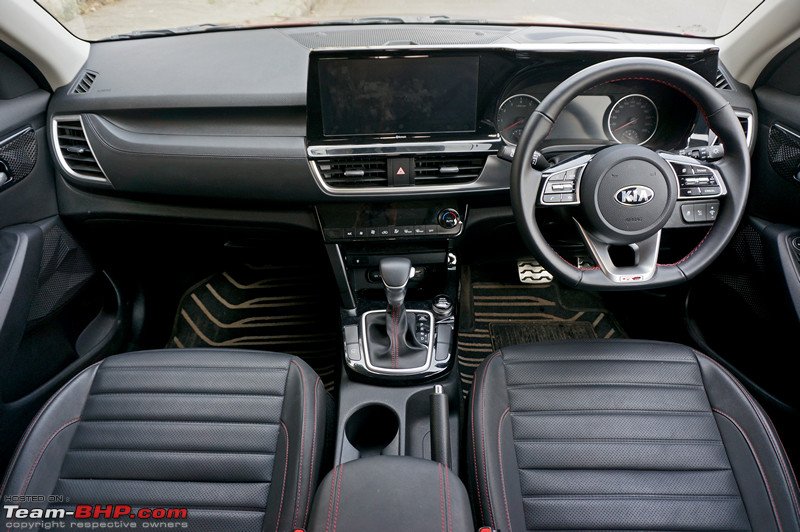 A look at the black leatherette upholstered seats of the GTK & GTX:  Tubular pattern and perforated material are identical to the GTX+, but the seats do not have cooling function:  A look at the manual adjustment levers of the driver's seat. Height adjustment is provided and the levers feel durable:  Fore & aft adjustment is via this sturdy metal lever:  Apart from the Intense Red colour seen on our test car, the Seltos is available in 7 other shades. These include Aurora Black Pearl, Glacier White Pearl, Punchy Orange, Intelligence Blue, Gravity Grey, Steel Silver and Clear White. One of those cars that looks good in any colour!  Kia can't stop bragging about Bose (it's clear why they had this tie-up). As if all those badges on the inside weren't enough, here is one outside for the world to see (right rear quarter window). It's pretty obvious that Kia chose Bose more for the "badge value" than sound (although it sounds good too):  Now this is something worth bragging about  . Bharat Stage 6 sticker on the rear. BS6 ready way before the deadline: . Bharat Stage 6 sticker on the rear. BS6 ready way before the deadline: Partial plastic cladding in the front wheel well...  ...and full cladding in the rear:  3 clear markings to indicate the diesel car's diet! Anything to prevent accidentally putting in wrong fuel, we say! No spill protector provided though:  Petrol doesn't get any such labelling:  50L fuel tank is smaller than expected. While it matches the Tata Harrier's 50L capacity, it is outclassed by the MG Hector (60L), Jeep Compass (60L) and Creta (55L):  If the air pressure in any tyre is low, this warning comes up on the MID, showing you the problematic tyre. A warning light appears above the speedometer as well (top right of the image):  Wireless smartphone charger has a cooling vent   Powerful LED headlamps do a good job of lighting up the road ahead:  With the high beam engaged, the throw is excellent!  ORVMs are India-friendly and will move the other way if a biker side-swipes them:  Recommended tyre pressure is 35 PSI all-round, which is on the higher side. Sure doesn't help its firm ride quality. Karan561 insists that 32 PSI provides the sweet spot between ride & handling (link). We tried 32 PSI and will say that the ride was more compliant overall, but bad roads were still prominently felt inside the cabin (our test car had the 17" wheels...those with 16 inchers will be happier):  Faux leather covers up the ugly gap between the dashboard & steering console - a premium touch:  All interior buttons are backlit in white. Unfortunately, on the driver's console, the passenger window & central locking buttons aren't! We're disappointed that Kia missed this much needed feature. Such cheap cost-cutting doesn't suit an otherwise premium car:  We loved the design pattern of the mats. Driver’s footwell gets 2 hooks to hold the floor mat in place:  Seatbelt warning light + chime come on even if the front passenger hasn't buckled up:  MID asks you to lower your speed whenever you cross 80 & 120 km/h with two simple words = Reduce Speed:  A peek at the cruise-control display. The function works at speeds above 30 km/h:  VIN is lightly engraved on a beam, below the driver's seat:  LED ambient lighting on the passenger's side of the dashboard (red colour only)...  ...and on the front doors (colour can be changed):  As mentioned earlier, the ambient lighting on the door can be made to flicker with the music being played!! Looks cheap IMHO. Note this happens only when you take the volume to level 5 and above: 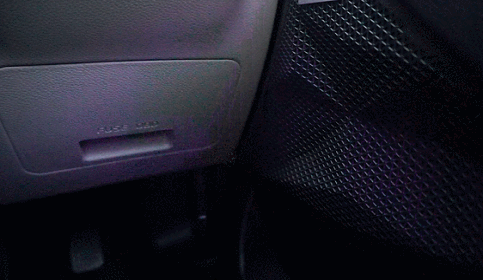 Perfume cartridge can be purchased at dealerships. Has 4 holes which are covered with tape (remove all if you like it strong):  Premium looking keyfob. We like the design. It gets a panic notification button at the bottom. Press it with the keyfob within operational distance of the car, and an SMS will be sent to the pre-saved emergency contact through UVO:  If the person with the keyfob has exited the car, a very prominent audible warning is given outside the car:  McPherson strut suspension with coil springs at the front:  Rear suspension is a coupled torsion beam setup:  HTX and GTX variants get the same 10.25" touchscreen head-unit as the GTX+ and HTX+. However, they don't get the Bose sound system and come with 6 speakers. Music quality is just average; the Bose is noticeably superior:  Last edited by GTO : 27th December 2019 at 07:33. |
| |  (121)
Thanks (121)
Thanks
|
| The following 121 BHPians Thank Aditya for this useful post: | Abhinav V, ach1lles, Added_flavor, AdityaDeane, aghate, AGwagon, akj53, akshay81, amit1agrawal, ampere, anshuman1117, antriksh, anu007, anumod, anzrulz555, arbaz906, ashis89, ashking101, AYP, Bee, Bibendum90949, BlackPearl, Bubby, BZ25, carrazy, catchjyoti, Chrome6Boy, Col Mehta, coolkurt, dailydriver, Dani7766, dealer, dksv, drmohitg, Enobarbus, Gany, giri1.8, GJ01, GTO, Hayek, hemanth.anand, hillsnrains, hiren.mistry, hishetty, HR 16, InControl, Ithaca, jailbird_fynix, JHS, karan561, katoom, knightrider_7, KrisTvpm, laferrari, lemedico, Leoshashi, libranof1987, lifebuoy, man_of_steel, MDED, Mohan Mathew A, MohanRajP, MSAneesh, myavu, N33raj, nalinsaxena23, naveen.raju, northstar*, NPV, Nrulz, omranga98, ontheway, OrangeCar, PapaKiloSierra9, PM - B, Ponbaarathi, Prakritij, prashanthyr, PrideRed, psankar, Puffdamgcdragon, RaghuVis, Rajeevraj, ramki067, RavenAvi, Redline6800, regenitin, Reinhard, REN, Researcher, RROD, RWD, S.MJet, sainyamk95, sanj47900, sayyam.gaur58, searacer932, sidenzo, Simat, skchettry, spikester, sreerknair, SS4, strawhat, stringbh, Sudeep_Kimster, summerisland, supertinu, sups, Teesh@BHP, Tgo, turbospooler, turbowhistle, vaasu, vb-saan, Vik0728, vivekn83, vsbabu, VTec_KickedInYo, WindmillsFly, yogiii |
| |
| | #12 |
| Team-BHP Support  | Re: Kia Seltos : Official Review Thread moved from the Assembly Line to Official Reviews. Thanks for sharing! Kia hit it out of the park with the Seltos, and so did your review, fittingly  . . I guess this is the first time that a manufacturer is going to win the Team-BHP COTY in its debut year and with its debut product (COTY Poll)!! Well deserved, I say. From all the mainstream cars that I’ve driven in 2019, the Seltos is the one that left the strongest impression on me…and the one I’d want to bring home. Kia’s entry will become a case study in the IIMs. Not only did they get the product spot-on, but even the execution. See how they aggressively ramped up production to 10,000+ units! You need guts for that. Or how quickly they responded to market feedback & introduced the fully-loaded automatic variants. I’ve spoken to people in the industry and noticed that even the competitors respect Kia. That’s saying something. Of course, no doubt that Kia gained from Hyundai’s 20+ years of experience in India. Hyundai HQ in Korea needed it too. This was the most logical way to expand the market for the Koreans. You can’t sell two Creta models in the 15 – 20 lakh price band, but you can certainly sell a Seltos & Creta, both belonging to the same company & sharing the same mechanicals. You can’t open 2 Hyundai showrooms in Prabhadevi, but you can certainly open a Hyundai & Kia showroom within 100 meters of each other. Hyundai-Kia have done it superbly, Renault-Nissan not so much and VW-Skoda with mixed results. While both the ATs are top-class, my pick would be the Diesel AT. I liked its driveability more, no overheating issues with brake-crawling in traffic, the fuel-economy will be higher and of course, the guaranteed reliability of the simpler torque converter gearbox in the long-term. The fact that I don’t have to pay any premium for the diesel engine makes it a no-brainer choice for me. If you were wondering about where the market is, it’s almost a 50:50 between the Seltos petrol & diesel (source). If you’re happy with the pricing of the entry & mid variants, thank the market slump for that. Kia had already committed big volumes to itself & its vendors and needed to meet them at any cost. Hence, the aggressive pricing and standout features offering. Before signing off on this review & moving onto the next, just wanted to share how cars can make everyone smile. See how happy BHPian mh09ad5578’s Mom is in this post. A sweet reminder of why we all hang out here on Team-BHP. Simply put, cars rock! Happy new year, guys! Wishing all of you a fab 2020 & may God bless your families  . .P.S. Just did a word count of this review using some online tools and it shows 15,000+ words! That's a new record. Another record is the total number of km we put on all the Seltos variants = 1,800 km of testing! Last edited by GTO : 27th December 2019 at 08:54. |
| |  (137)
Thanks (137)
Thanks
|
| The following 137 BHPians Thank GTO for this useful post: | 2himanshu, Abby92, Abhinav V, Abhinav_2502, ach1lles, Added_flavor, adi.mariner, Aditya, AdityaDeane, aghate, AGwagon, AkMar, akshay81, amit1agrawal, ampere, anshuman1117, antriksh, anu007, anzrulz555, arbaz906, ashis89, ashking101, asingh1977, Bee, Bibendum90949, binoyyj, BlackPearl, BoneCollector, brohanv, Bubby, BZ25, carenthusiast, catchjyoti, chiefpk, coolkurt, CrAzY dRiVeR, Crazy_cars_guy, dailydriver, dragracer567, DrANTO, drhoneycake, drmohitg, DrPriyankT, Enobarbus, Gannu_1, Gany, GipsyDanger, gkg2423, guyfrmblr, Hayek, heavenlybull, hishetty, HR 16, InControl, Ithaca, jailbird_fynix, jkaushik, karuvally, katoom, knightrider_7, Leoshashi, libranof1987, MDED, Mohan Mathew A, myavu, N33raj, nalinsaxena23, naveen.raju, neoonwheels, nmenon, noopster, NPV, Nrulz, omranga98, ontheway, PapaKiloSierra9, PM - B, Ponbaarathi, Prakritij, PrideRed, psispace, racer_ash, RaghuVis, rahulb22, Rajeevraj, ramki067, RavenAvi, rayjaycleoful, RBR, Redline6800, Reinhard, REN, Researcher, RJ2285, roby_dk, Romeo_Mike, S.MJet, Sachin V.W., Safari_Beast, sainyamk95, sairamboko, saisree, sam264_2000, sanj47900, sdp1975, searacer932, self_driven, sharktale, shipnil, siddarthab, skchettry, SnS_12, SpideyBoy, spikester, sri_tesla, SS4, streetfighter, stringbh, summerisland, supertinu, sups, swiftnfurious, Tgo, The Rationalist, turbospooler, turbowhistle, uday.ere, vaasu, vaish9925, vb-saan, Vid6639, Vintage muscle, vishy76, VivekCherian, vivekn83, wheelguy, xjosephjacob |
| | #13 |
| Distinguished - BHPian  | Re: Kia Seltos : Official Review Ah its out! And what level of detail. A new level! Whats going to be a COTY at many places including TBHP, sure deserves a spellbinding review & thats what this one is. Congratulations on the fabulous job of it - @Aditya & Co. Rated it 5 Stars of course. I love this car.
Thanks for the really good review. If KIA needed any confidence booster, this review is the best one possible. Last edited by Reinhard : 27th December 2019 at 09:44. |
| |  (24)
Thanks (24)
Thanks
|
| The following 24 BHPians Thank Reinhard for this useful post: | Abhi_abarth, Aditya, amit1agrawal, anu007, BZ25, dailydriver, Gany, gkg2423, GTO, Ithaca, jailbird_fynix, MDED, MohanRajP, naveen.raju, PapaKiloSierra9, RaghuVis, RavenAvi, Researcher, Simat, SpideyBoy, The Rationalist, Torque_Curve, uday.ere, yesyeswe |
| | #14 |
| BHPian Join Date: Nov 2019 Location: Gurgaon
Posts: 204
Thanked: 948 Times
| Re: Kia Seltos : Official Review What an exhaustive review! I'm sure many of us have been waiting for this since September.  The Seltos beats it's key rivals at one point which no enthusiast can argue: depth of engineering, which shows how far the Koreans have come. Kia was up till the early 2000s known for building cheap small cars like it's sister brand Hyundai, but in just a little over a decade are evolving into an aspirational brand with such great offerings like these worldwide. The Seltos beats it's key rivals at one point which no enthusiast can argue: depth of engineering, which shows how far the Koreans have come. Kia was up till the early 2000s known for building cheap small cars like it's sister brand Hyundai, but in just a little over a decade are evolving into an aspirational brand with such great offerings like these worldwide. This what I felt when I first saw Seltos in the flesh. My father loved the car so much, that he booked a GTX+ right away in early July. VW-Skoda definitely need to make their MQB AO- IN offerings up to the high standards set by the Seltos to reverse their plummeting sales. One more thing- I won't argue that the Bose Soundsystem sounds underwhelming, but after toggling through the settings, it sounds much better. 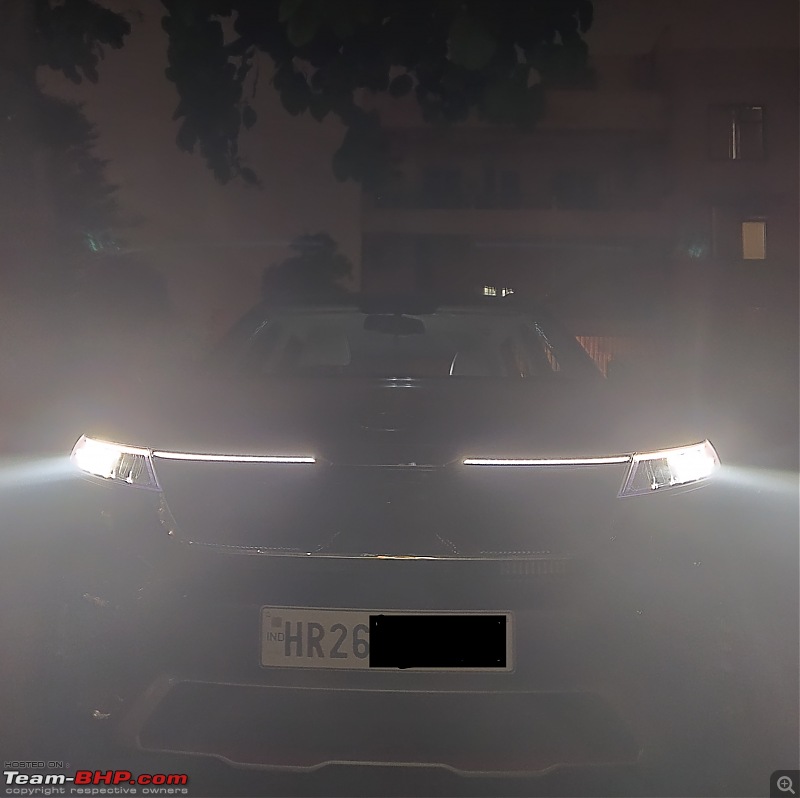 Here's our GTX+, looking epic in the night. Last edited by BZ25 : 27th December 2019 at 09:42. |
| |  (25)
Thanks (25)
Thanks
|
| The following 25 BHPians Thank BZ25 for this useful post: | Aditya, AGwagon, Bubby, carrazy, dailydriver, DrPriyankT, Gany, GTO, gururajrv, haisaikat, hemanth.anand, Ithaca, jailbird_fynix, MDED, myavu, Punatic, RaghuVis, RavenAvi, Researcher, Simat, ThatCarGuy, The Rationalist, vaish9925, VTec_KickedInYo, yogiii |
| | #15 |
| Distinguished - BHPian  Join Date: Oct 2009 Location: Namma Bengaluru
Posts: 7,520
Thanked: 11,179 Times
| Re: Kia Seltos : Official Review Whoa, what a review - amazing eye for detail, rating well deserved 5 stars  Aditya, Eddy, Viddy, GTO and rest of the team - Great work on compiling the review, time taken is worth it after seeing the results  Timing of the review is good, coming just before the end of the year when the Kia Seltos is almost poised to unanimously win the Team-BHP Car Of The Year award. I hope the missing bits (nice to haves and expected features) are addressed soon in the first update/facelift and niggles are sorted out soon. Kia has scored a home run by getting everything right in a new product, their first in India, this at a time when the automobile industry is seeing a slump! I think this is a much needed trigger Kia has provided to wake up the other manufacturers who seem to be in a slumber due to their complacency. Waiting for the other Kia launches like Carnival - God Bless Competition! Last edited by NPV : 27th December 2019 at 09:49. |
| |  (10)
Thanks (10)
Thanks
|
| The following 10 BHPians Thank NPV for this useful post: | Aditya, Bubby, BZ25, GTO, InControl, Ithaca, jailbird_fynix, RaghuVis, RavenAvi, VTec_KickedInYo |
 |


